Deep in the Desert: a Jordan photo essay/TR
#1
Original Poster
Join Date: Jan 2008
Posts: 7,514
Likes: 0
Received 0 Likes
on
0 Posts
Deep in the Desert: a Jordan photo essay/TR
Marhaba--hello. This photo essay focuses on Jordan, the small buffer state created by the Brits in the heart of the contentious Middle East Holy Land. National Geographic once called it 'the crossroads of historical empires'. Our 2010 trip crossed the sands of southern Jordan. The itinerary was supposed to have also included the Dana Nature Reserve, but a massive German snowstorm canceled our original Frankfurt connecting flight. For Mrs Z and I, our delayed desert journey was off to a bad start (see 'amegh' or bad luck). Thankfully, our truncated tour eventually salvaged the fabled twin attractions of Petra plus Wadi Rum. Both are ripe settings for fantasy. This TR will include musical interludes to break up the stony sameness. First, an overview with text and photos. Tayib, maashi!--OK, let's go!
Jordan is a small Muslim country with a population of six. About 5% of those folks are Christian. Unlike its wealthy neighbors, Jordan has negligible oil reserves. Its riches are decidedly tourist as Petra, realm of the Nabataeans, and Wadi Rum, realm of the Bedouin, rank as world-class travel destinations. *clicking on images may result in better viewing

The Jordanian tourism industry experienced a bizarre juxtaposition, when pre-covid numbers from cruise ships resulted in a new need for crowd management at Petra. The subsequent covid collapse meant that tourist dollars became a trickle.
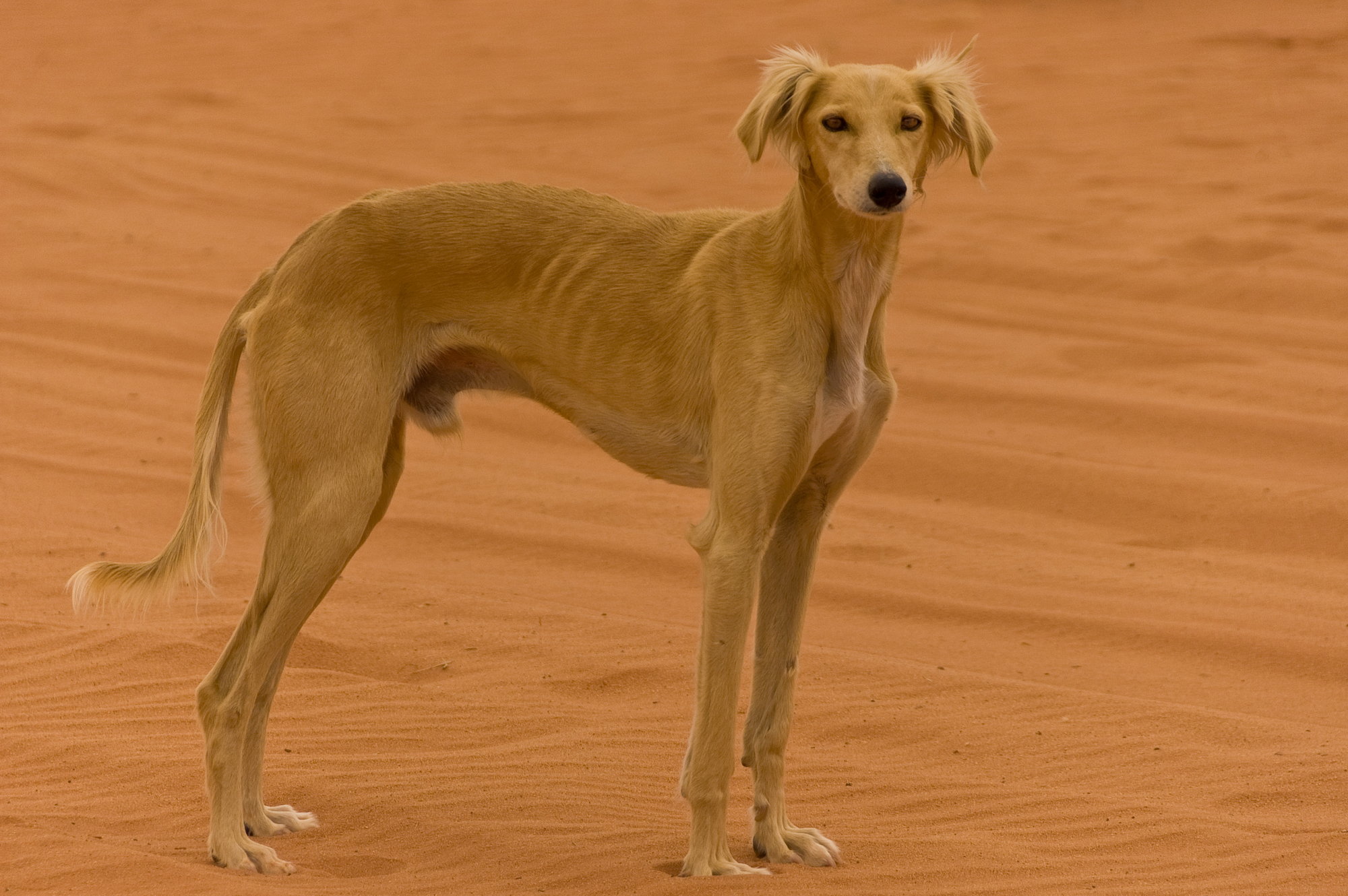
This 'saluki' or slender Persian Greyhound is a hunting dog. These trained, tufty-eared canines accompany their male masters across wild harshlands while seeking a wide range of desert prey: rabbits, birds, wildcats, gazelles and ibex.

Petra is Greek for stone. These remnants of the former Nabataean trading empire are scattered across a surprisingly wide area, which is watched over by security drones. Note that 70% of the site remains on excavated. Do not try and see it in one day: rookie mistake.
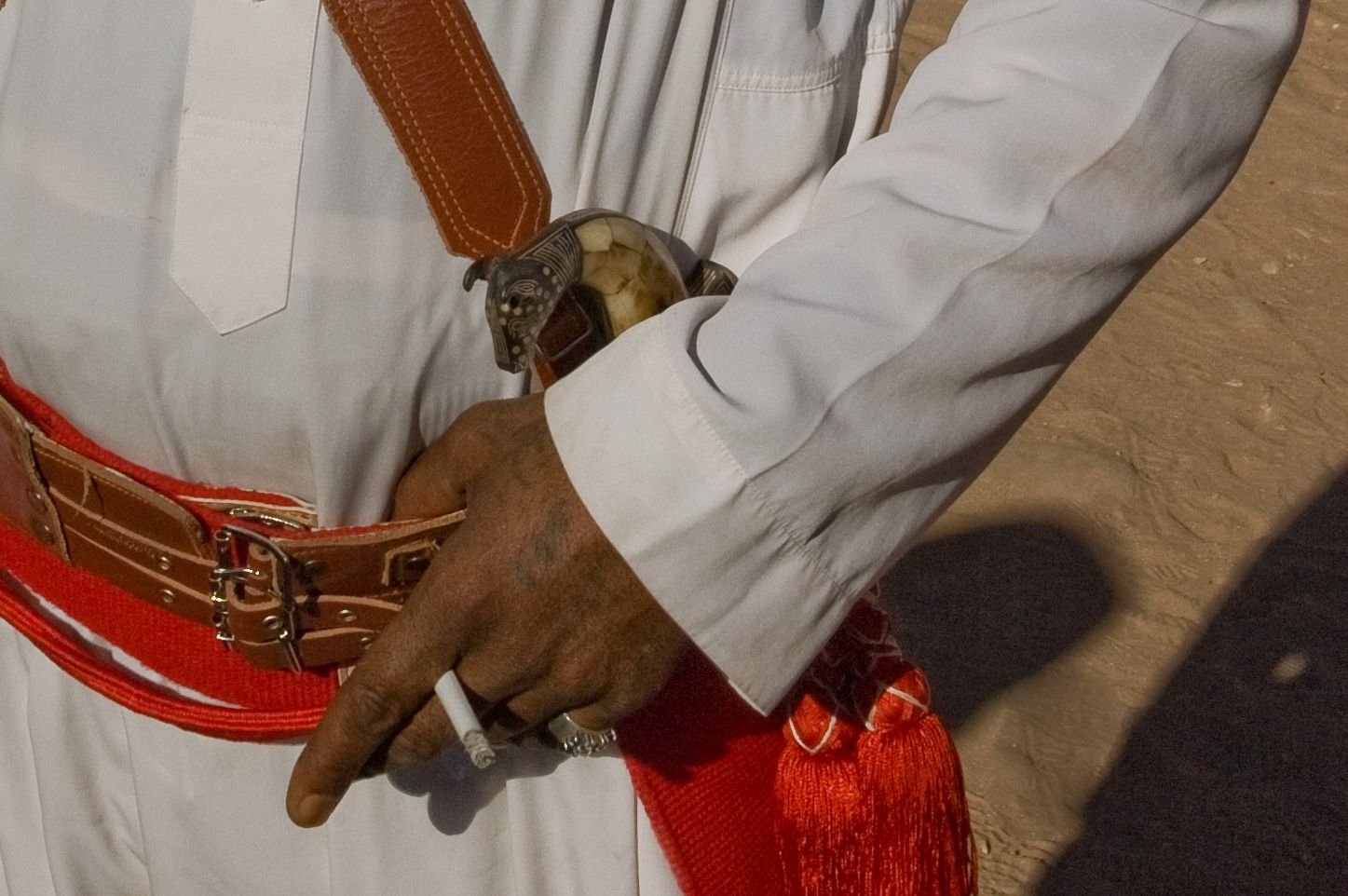
There is some debate as to whether all hand tatoos have been done while the men were in prison.
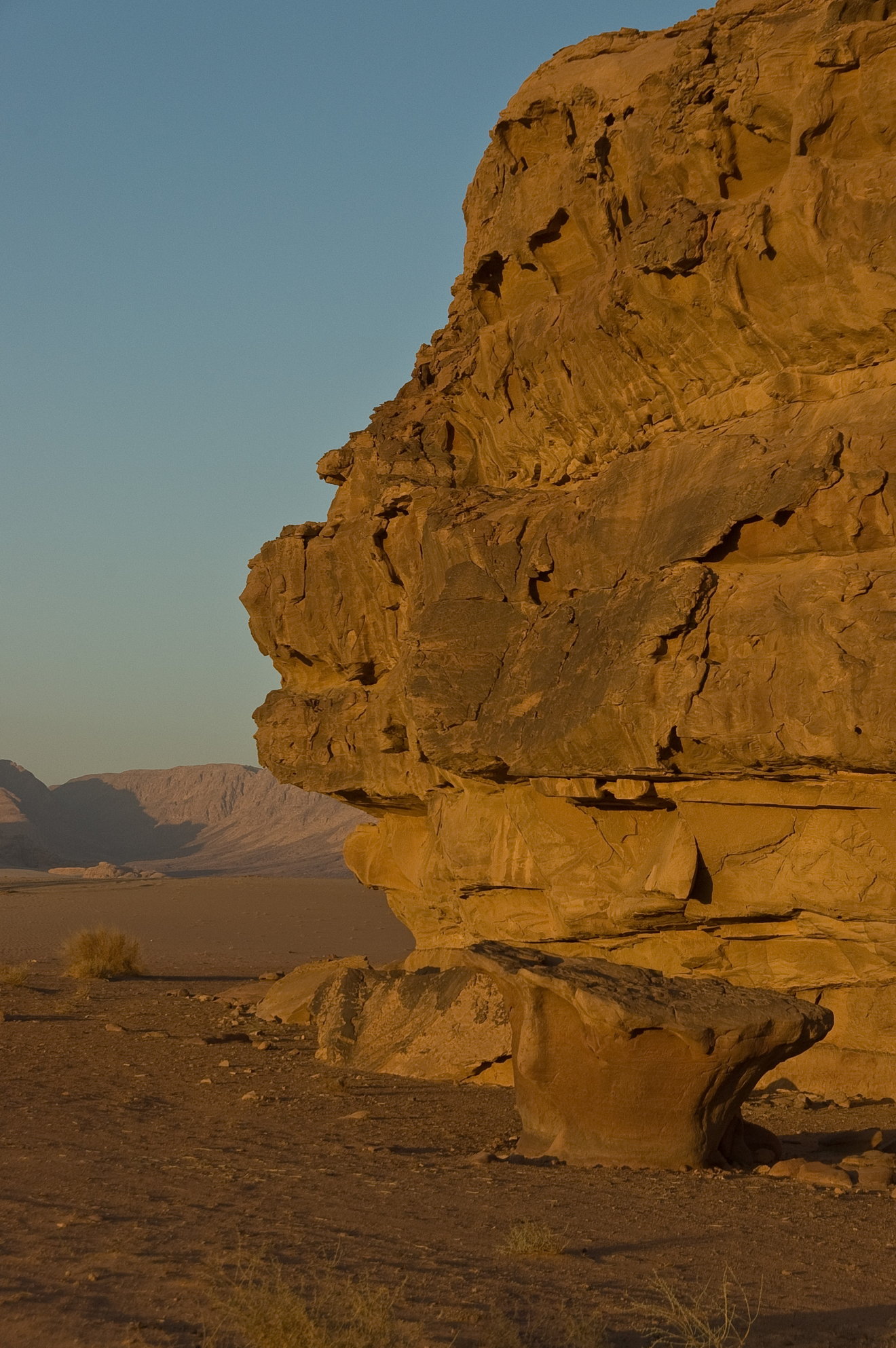
If ever a place deserved the adjectives 'pristine' and 'awesome' then Wadi Rum ('Valley of the moon') is surely it. Some liken it to the American Southwest. It is very conducive to a romantic kind of adventure travel.
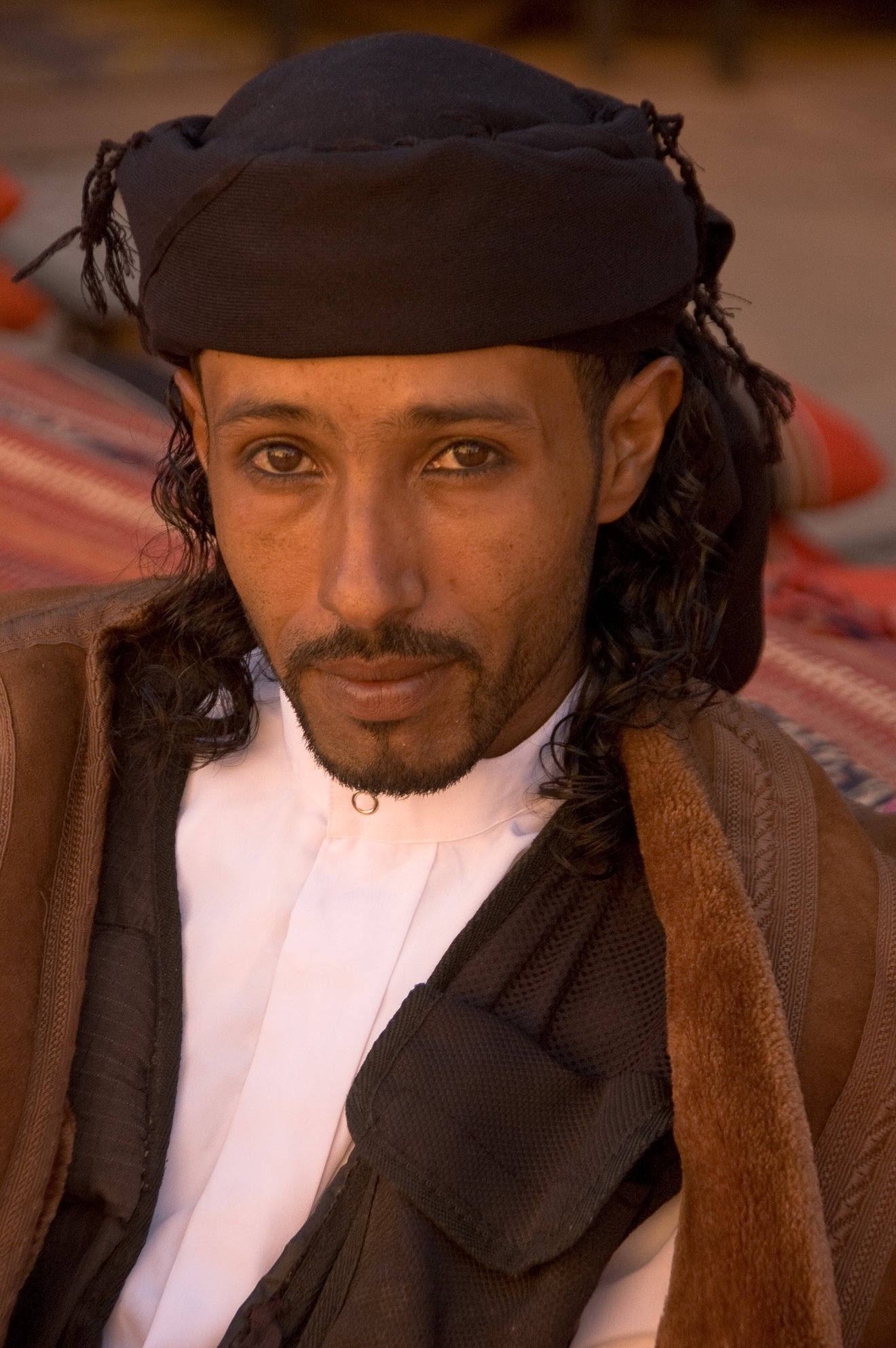
Atif bore the dignified bearing of the Amareen ('lion') tribe. We met this regal desert-dweller at one of Petra's more distant sites. Over tea, we chatted about the different Arab 'phelge' dialects, such as Lebanese and Syrian. He also wanted us to know that 'Iskander' ( Alexander the Great) had visited Petra.
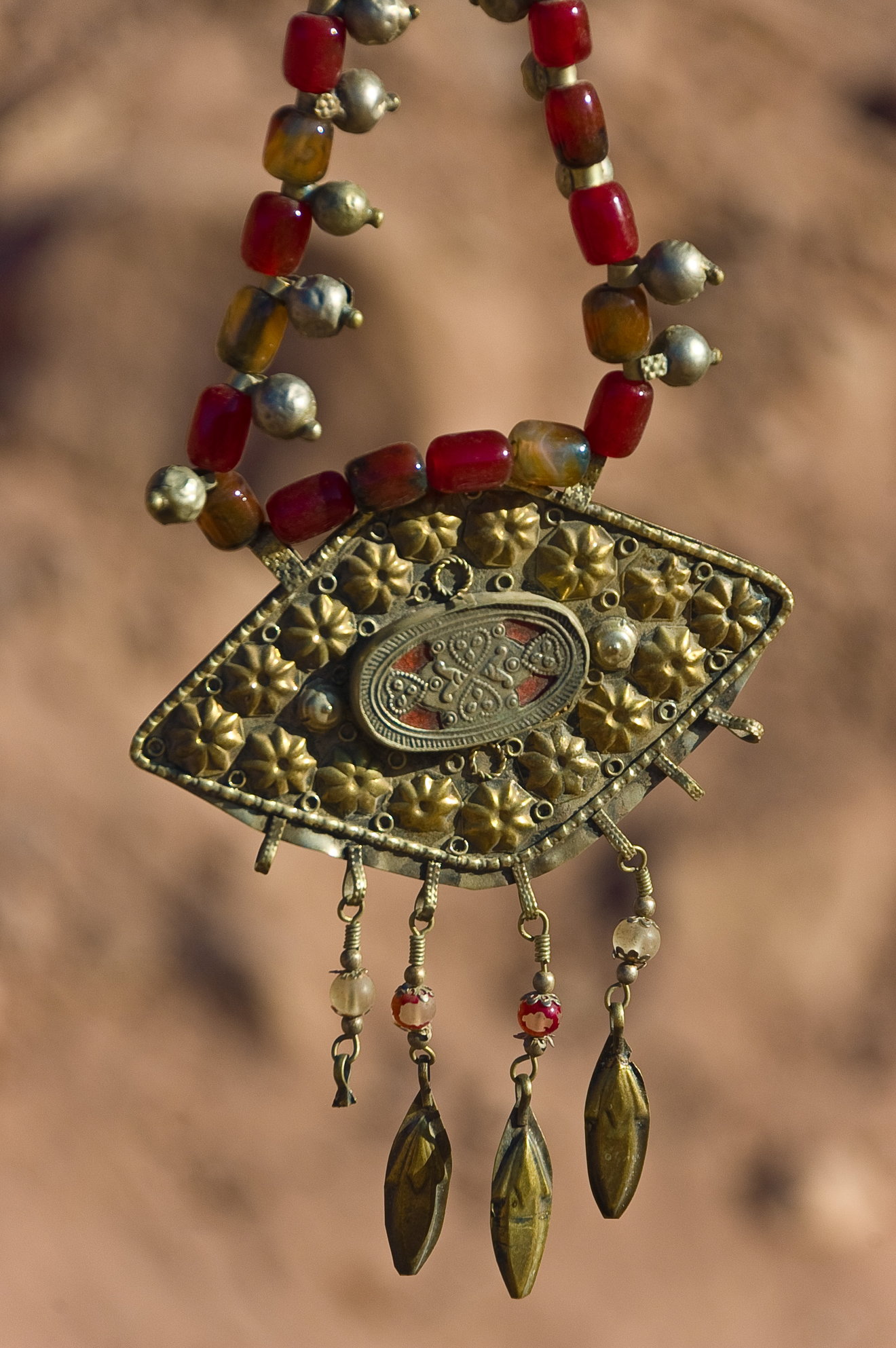
This hijab amulet was created as a protection against 'ayn' or evil eye.
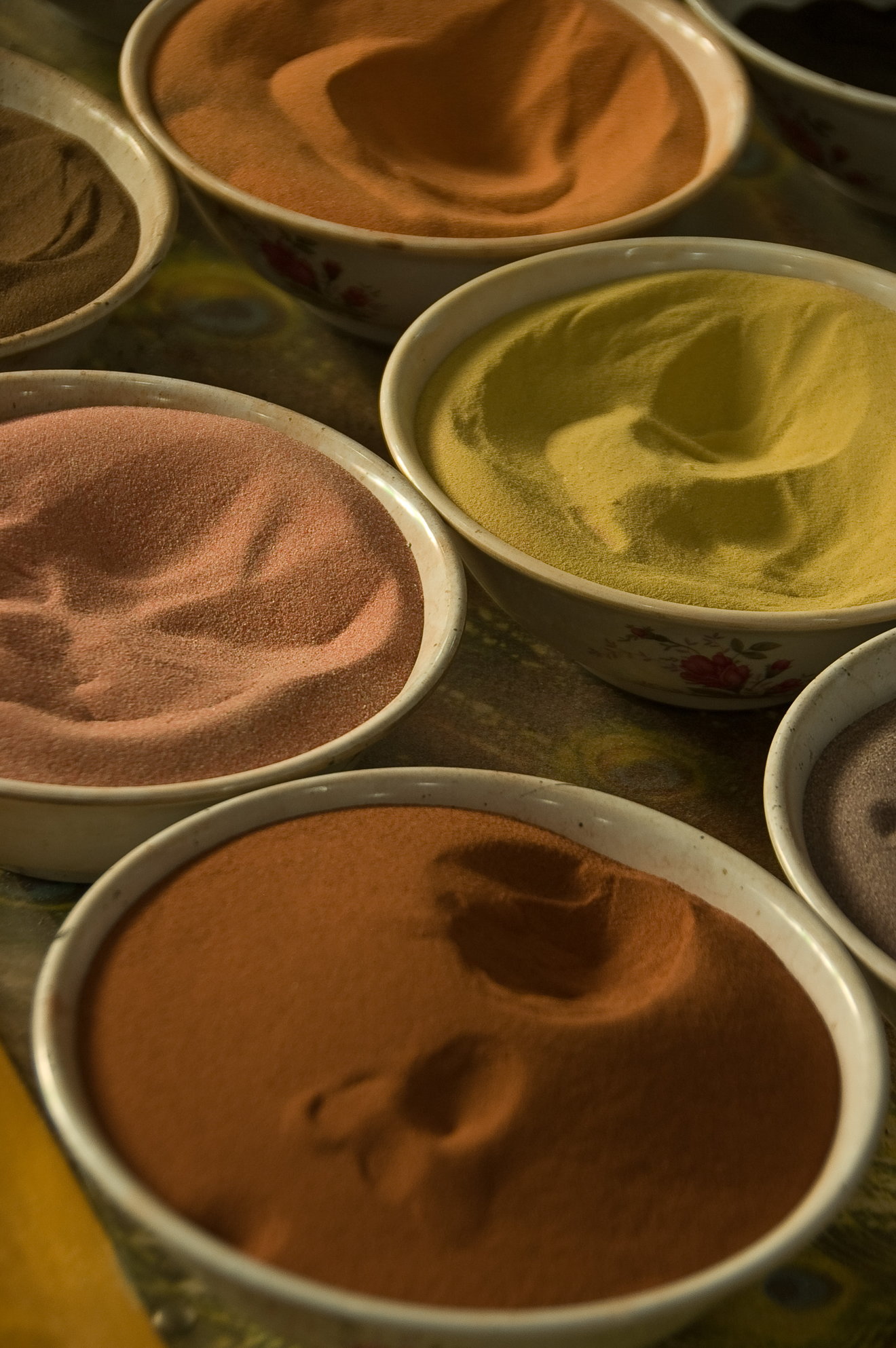
Tourist souvenirs attempt to convey the many-colored sands of the arid terrain. Shutterbugs and artists will enjoy the red swathes of sand, the spectacular granite and stunning sandstone.
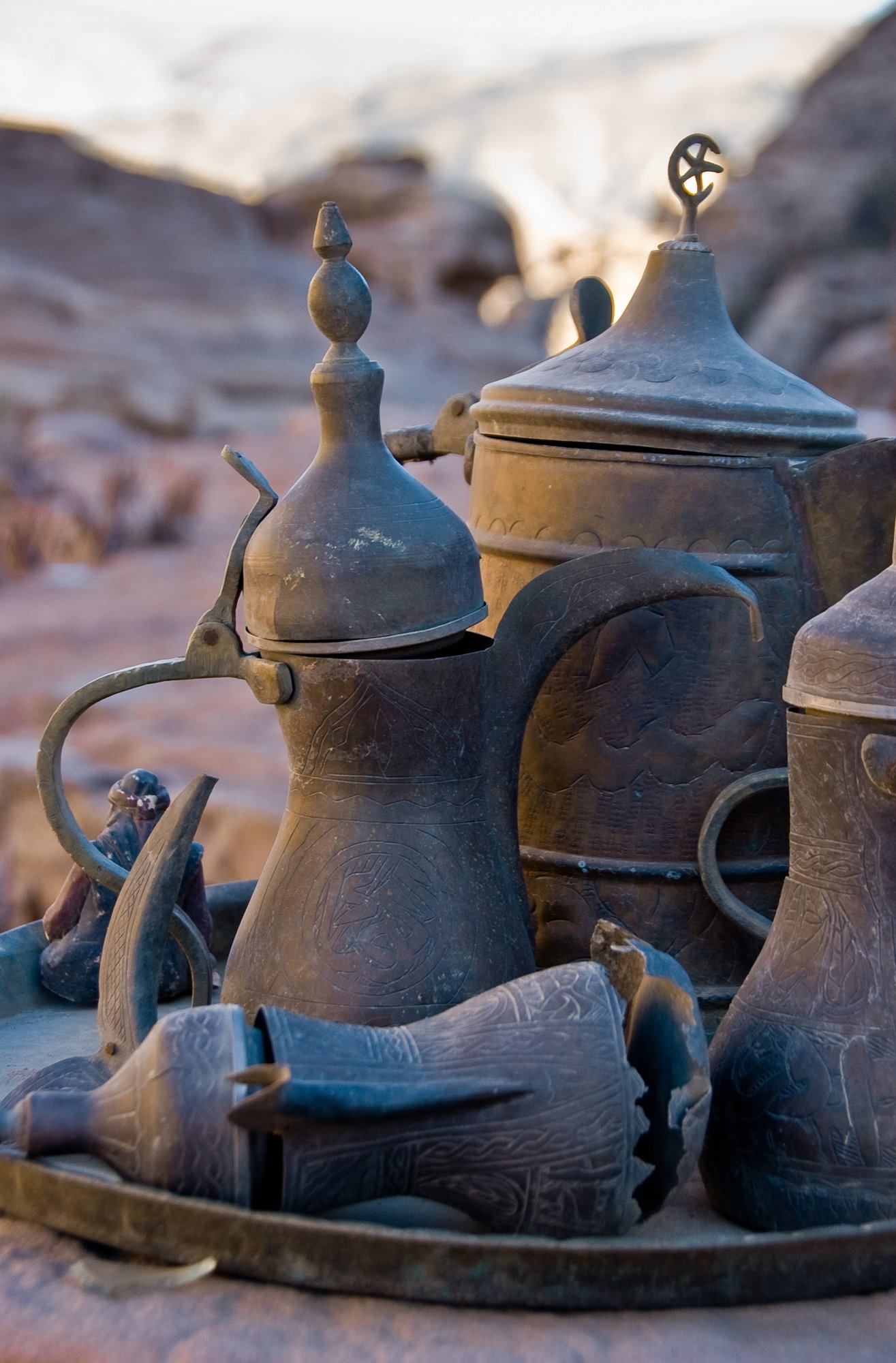
A collection of old 'ibreeg' and 'dallah' kettles.
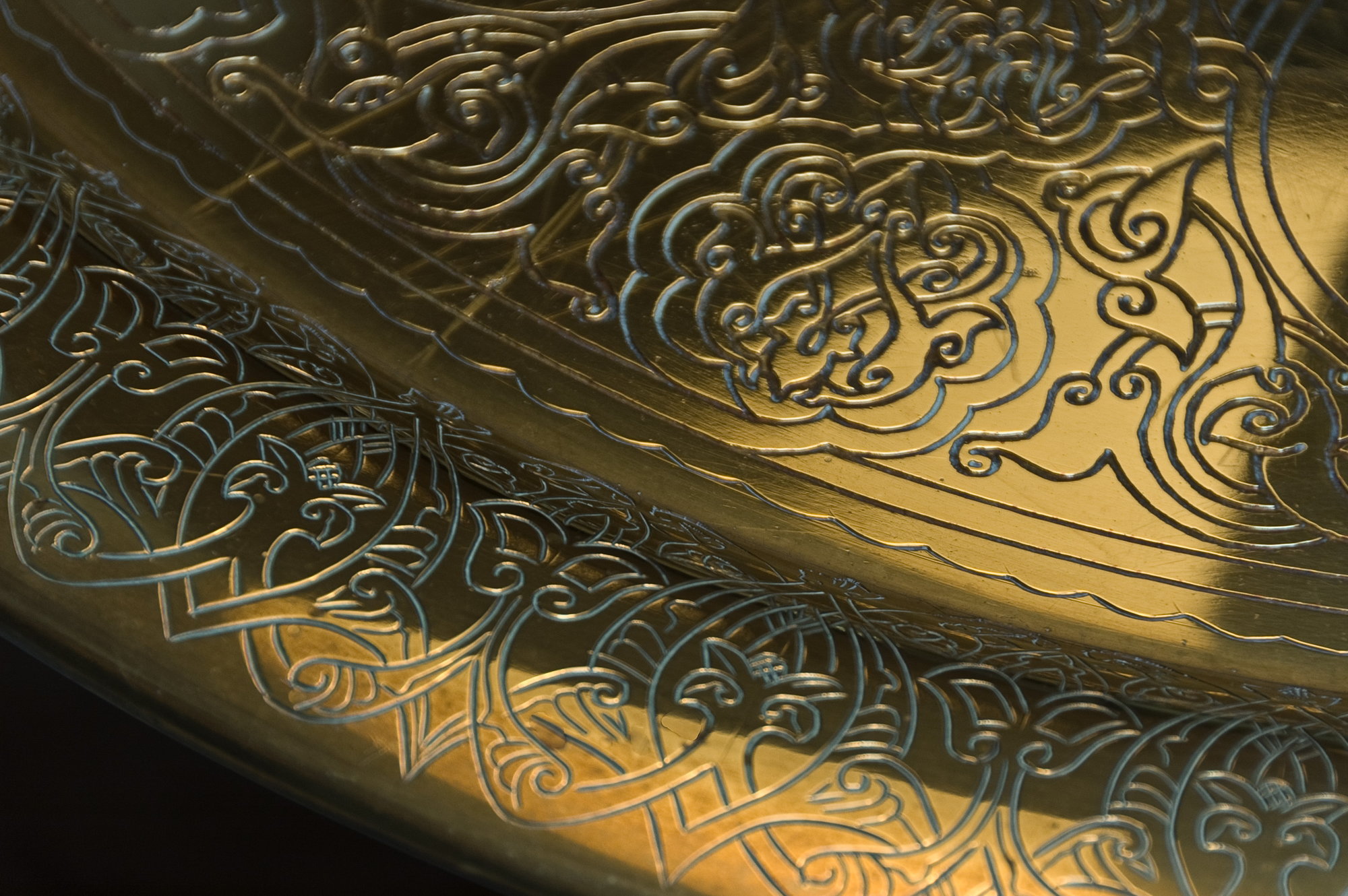
Fine craftsmanship.

For us, Petra's most compelling site is 'ad-Deir,' the so-called Monastery. It is reached by 900 somewhat-steep stairs. The Dec. '98 issue of National Geographic featured a spectacular photo taken of a Bedouin tribesman sitting atop the roof of middle dome. Yikes!
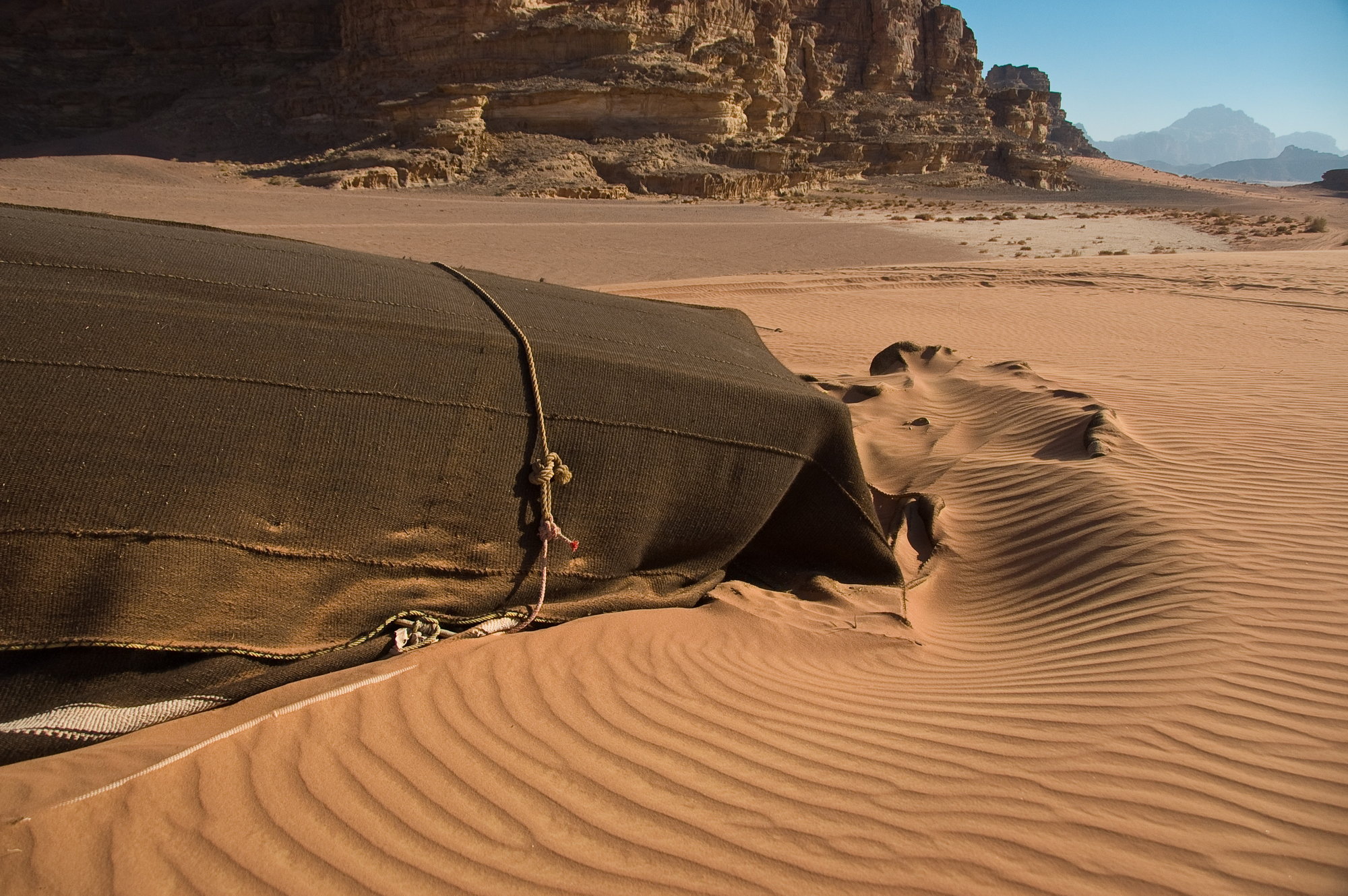
In Wadi Rum, we had a desert stay in an authentic 'bait al sha'er' or house of goat hair. Shown above, the spring-sheared goat hair roof or 'shugah'. Later in this TR, we'll describe the particulars of that tenting experience.

Some other Petra residents.

These water pipes go by a number of names: shisha, nagilah or most-commonly here: hubbly-bubbly. Apparently, aficionados add apple chips to their tobacco.

A tiny potion of the the ancient Talmudic rock art petroglyphs at Wadi Rum's Anfashiesh site. They were inscribed by camel caravans depicting their desert travel in about 700 BC.

Folk decor.
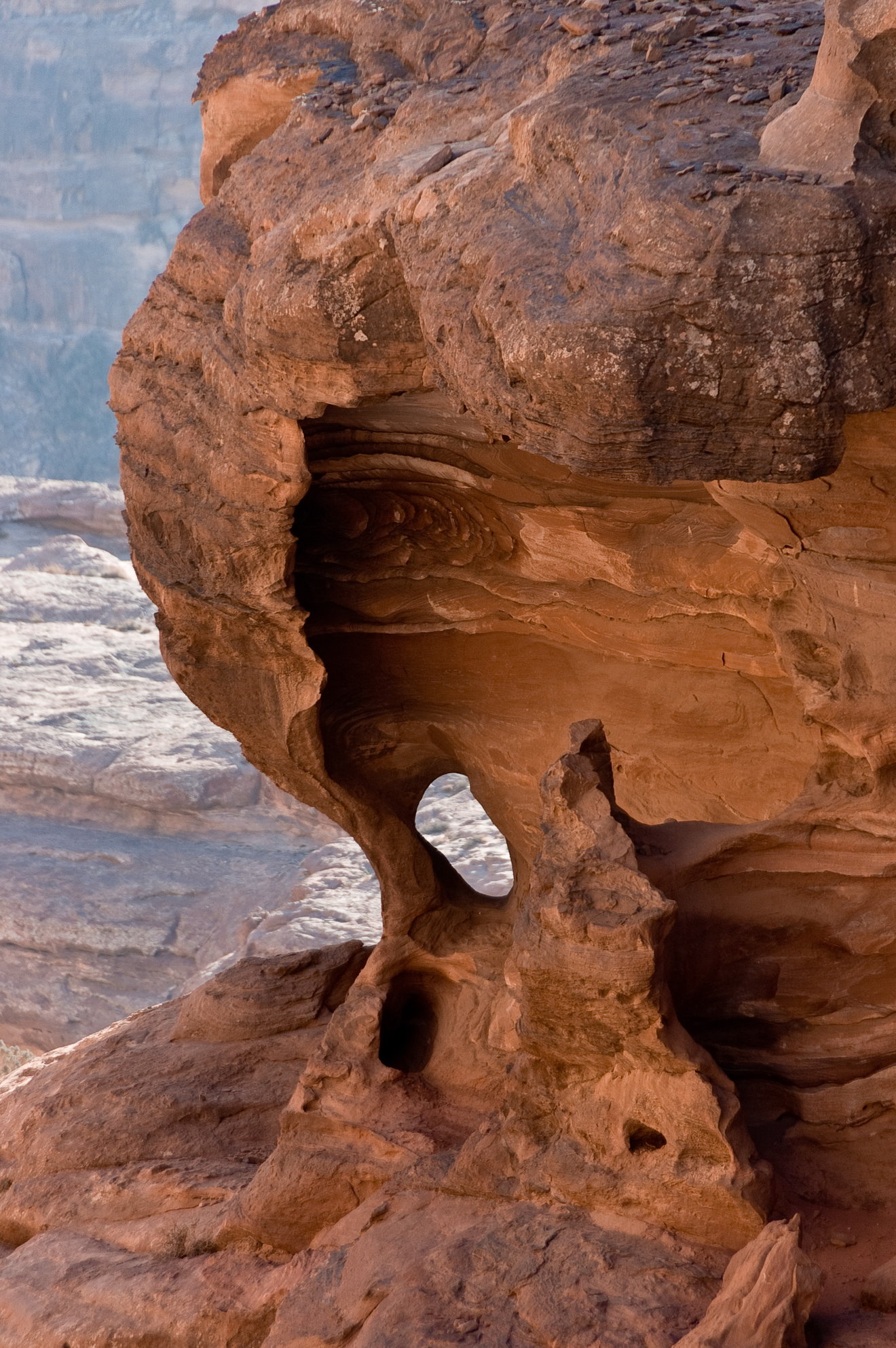
The seemingly alien geography is ever-present on a Jordanian desert trek.

The women of the Bani Hamada cooperative in Madaba town, are known for their colorful 'bsat' handwoven, pure-wool rugs. They get natural crimson dye from 'kermes' plants, plus various yellows from turmeric and 'kurkun'.
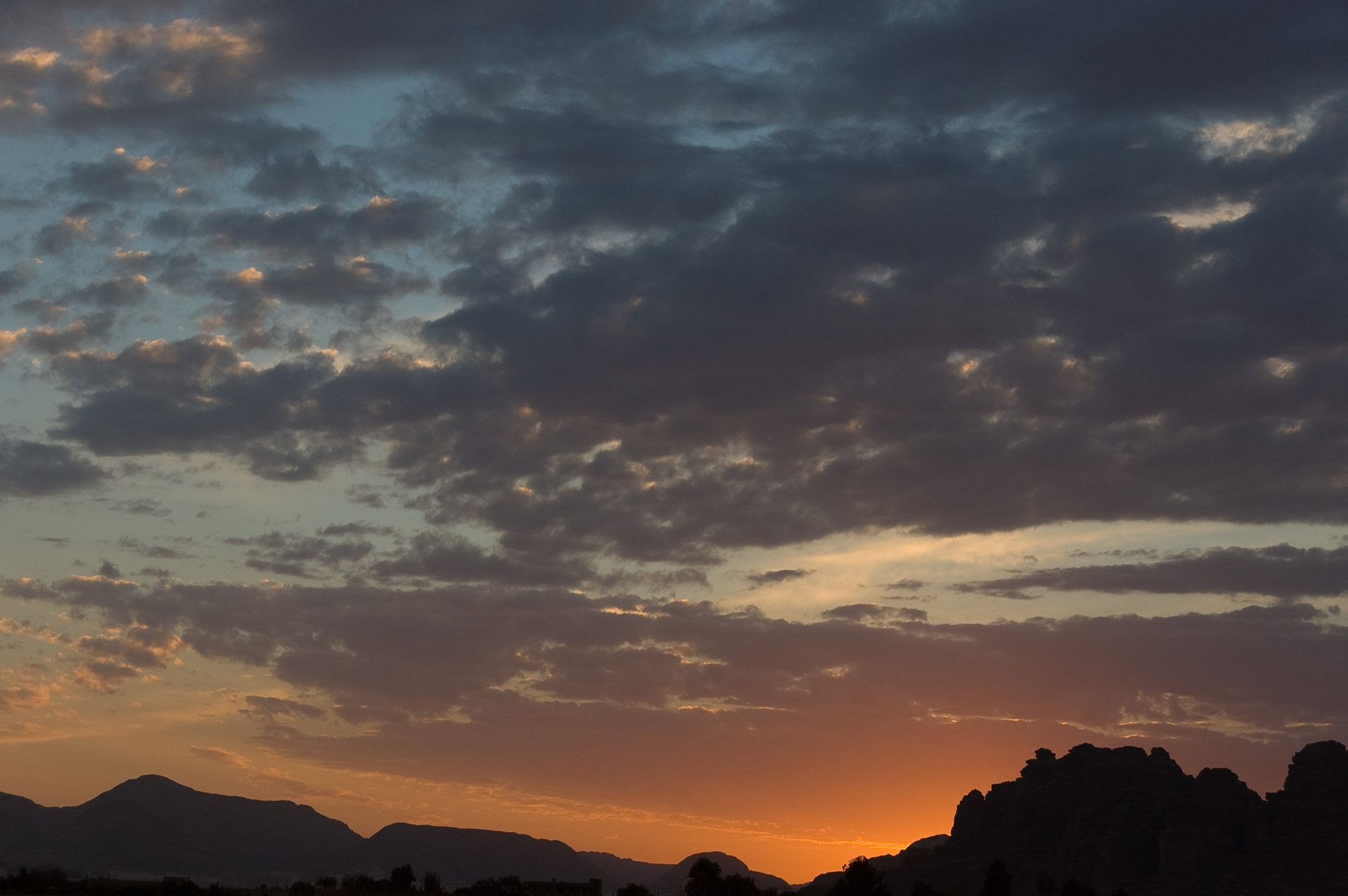
A Wadi Rum sunset. Now is a good time for our first musical interlude, a song for stargazers called 'Imanza'. It is by the musician 'Abdelli', actually from Algeria but for purposes of this TR, an honorary Jordanian. So please play this wonderful song, then imagine yourself sleeping beneath a million silver stars somewhere out in the Jordanian desert.
END OF OVERVIEW
Jordan is a small Muslim country with a population of six. About 5% of those folks are Christian. Unlike its wealthy neighbors, Jordan has negligible oil reserves. Its riches are decidedly tourist as Petra, realm of the Nabataeans, and Wadi Rum, realm of the Bedouin, rank as world-class travel destinations. *clicking on images may result in better viewing

The Jordanian tourism industry experienced a bizarre juxtaposition, when pre-covid numbers from cruise ships resulted in a new need for crowd management at Petra. The subsequent covid collapse meant that tourist dollars became a trickle.

This 'saluki' or slender Persian Greyhound is a hunting dog. These trained, tufty-eared canines accompany their male masters across wild harshlands while seeking a wide range of desert prey: rabbits, birds, wildcats, gazelles and ibex.

Petra is Greek for stone. These remnants of the former Nabataean trading empire are scattered across a surprisingly wide area, which is watched over by security drones. Note that 70% of the site remains on excavated. Do not try and see it in one day: rookie mistake.

There is some debate as to whether all hand tatoos have been done while the men were in prison.

If ever a place deserved the adjectives 'pristine' and 'awesome' then Wadi Rum ('Valley of the moon') is surely it. Some liken it to the American Southwest. It is very conducive to a romantic kind of adventure travel.

Atif bore the dignified bearing of the Amareen ('lion') tribe. We met this regal desert-dweller at one of Petra's more distant sites. Over tea, we chatted about the different Arab 'phelge' dialects, such as Lebanese and Syrian. He also wanted us to know that 'Iskander' ( Alexander the Great) had visited Petra.

This hijab amulet was created as a protection against 'ayn' or evil eye.

Tourist souvenirs attempt to convey the many-colored sands of the arid terrain. Shutterbugs and artists will enjoy the red swathes of sand, the spectacular granite and stunning sandstone.

A collection of old 'ibreeg' and 'dallah' kettles.

Fine craftsmanship.

For us, Petra's most compelling site is 'ad-Deir,' the so-called Monastery. It is reached by 900 somewhat-steep stairs. The Dec. '98 issue of National Geographic featured a spectacular photo taken of a Bedouin tribesman sitting atop the roof of middle dome. Yikes!

In Wadi Rum, we had a desert stay in an authentic 'bait al sha'er' or house of goat hair. Shown above, the spring-sheared goat hair roof or 'shugah'. Later in this TR, we'll describe the particulars of that tenting experience.

Some other Petra residents.

These water pipes go by a number of names: shisha, nagilah or most-commonly here: hubbly-bubbly. Apparently, aficionados add apple chips to their tobacco.

A tiny potion of the the ancient Talmudic rock art petroglyphs at Wadi Rum's Anfashiesh site. They were inscribed by camel caravans depicting their desert travel in about 700 BC.

Folk decor.

The seemingly alien geography is ever-present on a Jordanian desert trek.

The women of the Bani Hamada cooperative in Madaba town, are known for their colorful 'bsat' handwoven, pure-wool rugs. They get natural crimson dye from 'kermes' plants, plus various yellows from turmeric and 'kurkun'.

A Wadi Rum sunset. Now is a good time for our first musical interlude, a song for stargazers called 'Imanza'. It is by the musician 'Abdelli', actually from Algeria but for purposes of this TR, an honorary Jordanian. So please play this wonderful song, then imagine yourself sleeping beneath a million silver stars somewhere out in the Jordanian desert.
END OF OVERVIEW
Last edited by zebec; Mar 21st, 2022 at 05:22 PM. Reason: yallah yallah yallah
#3
Original Poster
Join Date: Jan 2008
Posts: 7,514
Likes: 0
Received 0 Likes
on
0 Posts
Thank you Abdelli, for your evocative music. So this second section will feature Petra, the monumental high point of the Nabataean kingdom. Wadi Rum will follow later, in part three.
For many, it is Petra's arresting sandstone landscape that they never forget. Beautifully swirling striations and vivid patterns abound, designed in a wide range of stripes. Abstract patterns of eroded, naturally-tinted stone covers cliffs, surrounds tomb doorways and spreads across temple ceilings. The exquisitely hand-hewn caves, tunnels and fašades were wrought from this rock. Some lay unfinished.

A dreamy 'al falq' or sunrise near Petra. A Lost City-quality pervades beneath towering mountains.
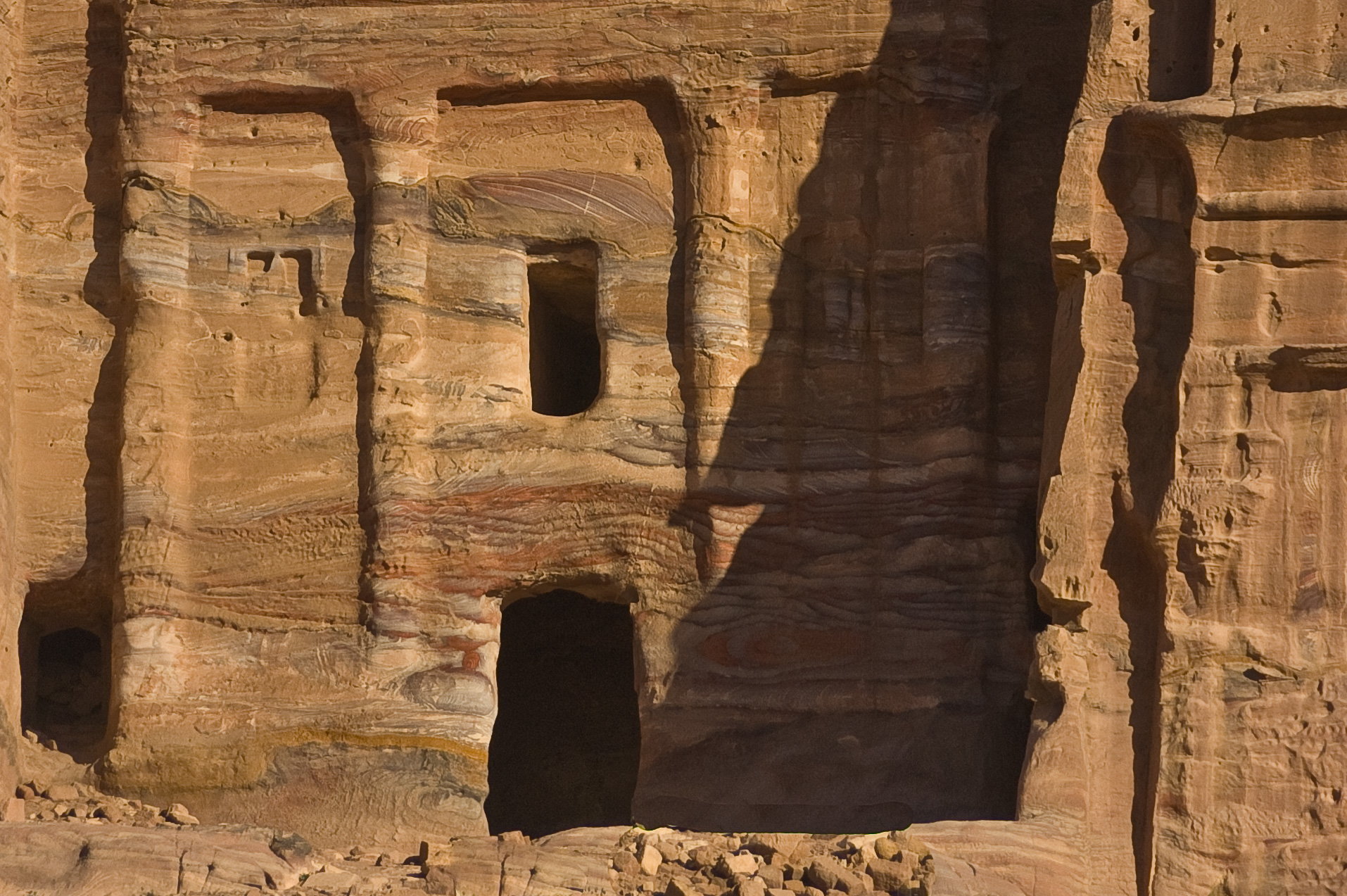
The site is not without accidental dangers. Flash floods and also falling rock falls have taken traveler lives. The Muessra tomb collapsed a few weeks prior to our arrival. At least one tourist fell to their death while taking a dangerous selfie high above the iconic Treasury 'Al Kazneh'.

This textured land seems like an art gallery. Abstract patterns of eroded, naturally-tinted stone form multi-colored displays. Brilliant bands of russet wonder are matched by carmine and rosy red sections. Elsewhere, chocolate, salmon, mustard, ham and curry. Whether pale or strong, simple or complex, the artistic visuals bleed into each other.

The points in color concentration are rich in iron oxide and magnesium, remnants from ancient Gondwanaland 550 million years ago.
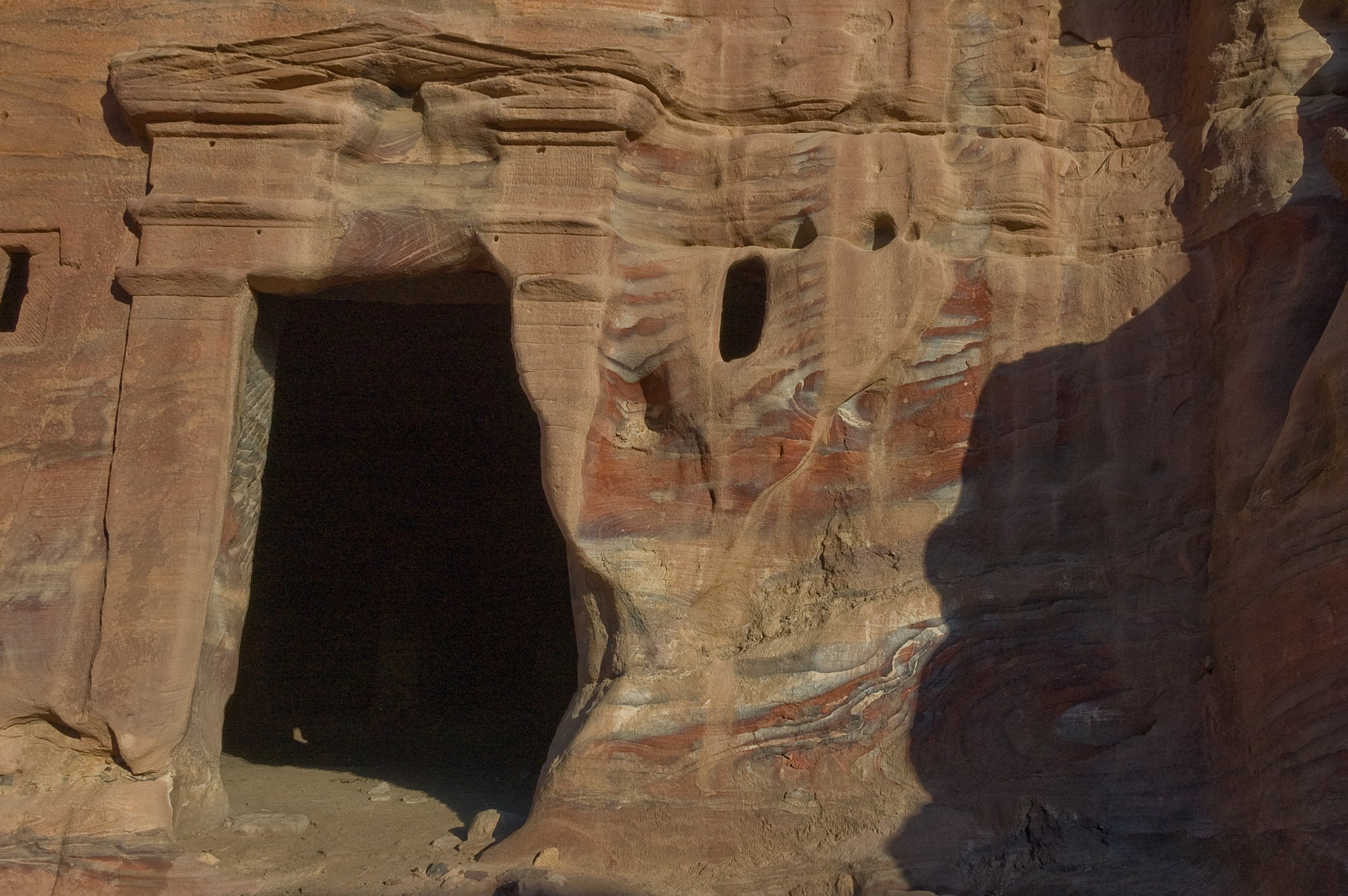
A tomb entrance. Geologists refer to these iridescent rock rhythms as 'paragrams': erosion lines matched with color tonal variance.

'I Married a Bedouin' is one good book recommendation, chronicling how a Dane married a local man. Their adult son now runs a Petra souvenir stand.
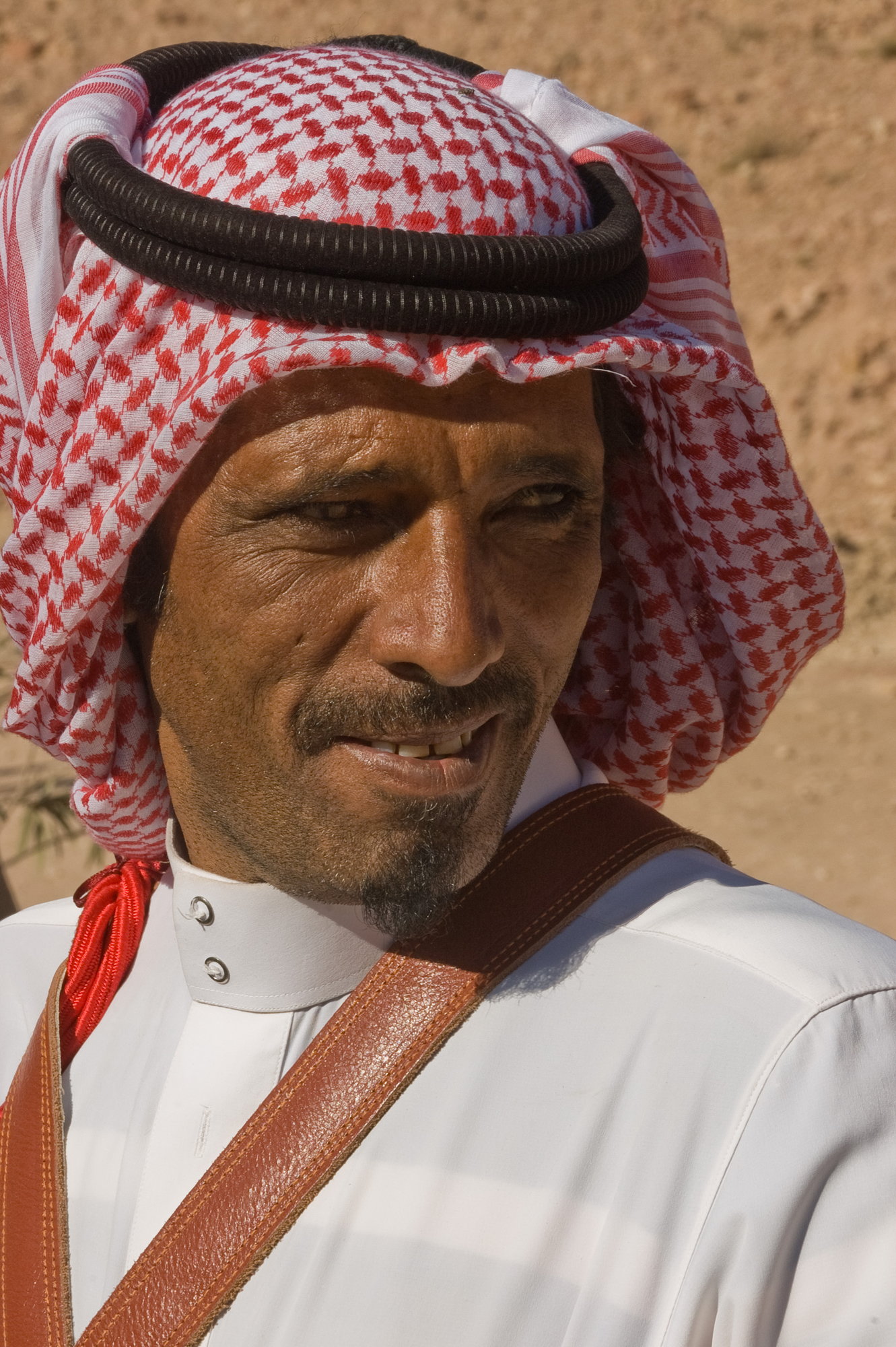
Tourism is utterly crucial here, and folks like this policeman are hired to keep order.
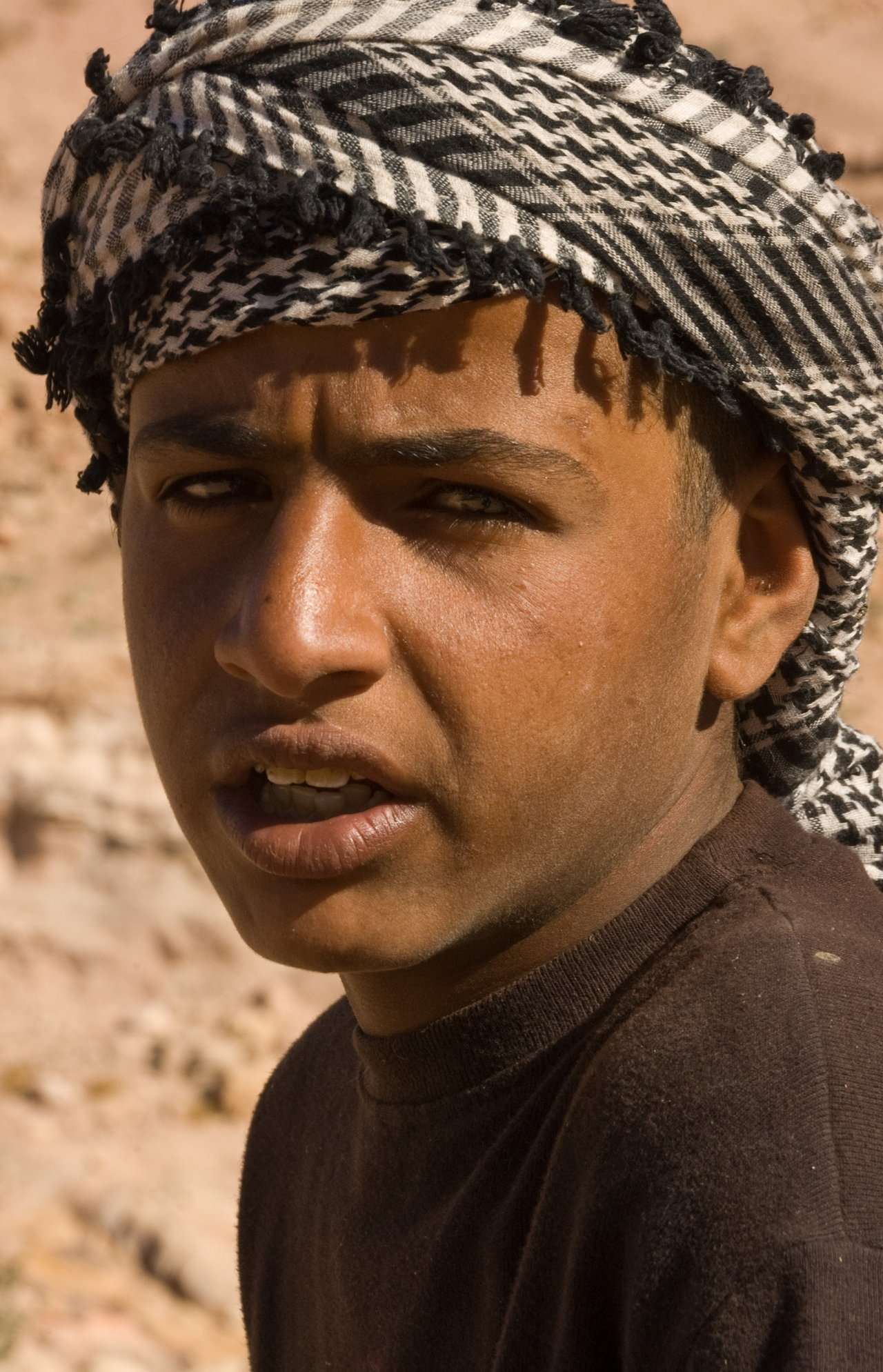
But teens like Solomon (shown here) remain confused about whether it is worth it to complete their education, or to instead immediately plant roots in some sort of tourism industry position. This young man joins his colleagues from the nearby hardscrabble village of Um Sayhoun, to offer donkey rides to tourists.
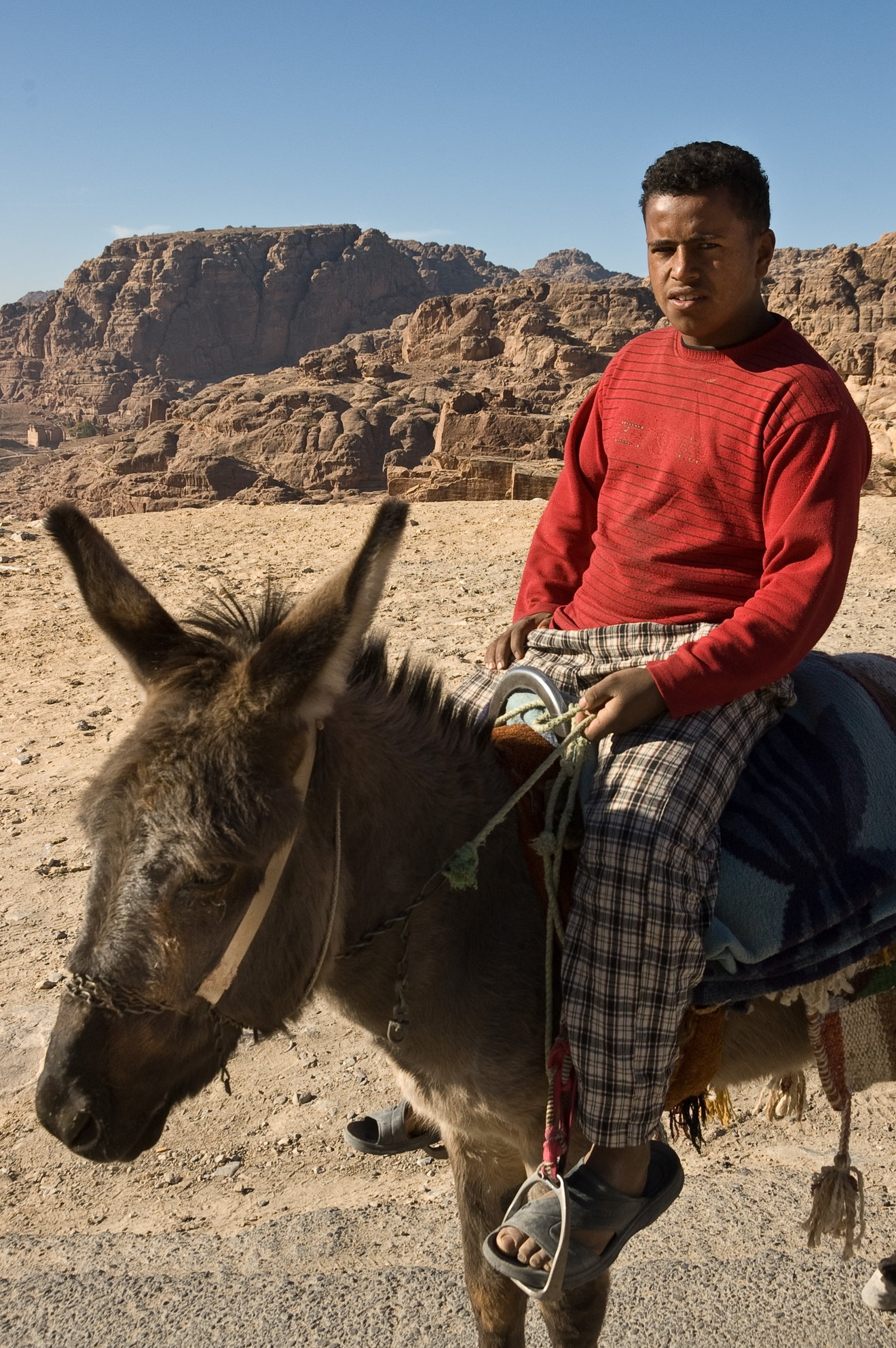
Solomon's pal, another ('shebab') teen keenly aware of the limitations of local career opportunities.

There is a kind of back entry to Petra, a less-known route from Beida village into Siq al Berid (i.e. 'cold canyon'--due to greater shade), aka little Petra.
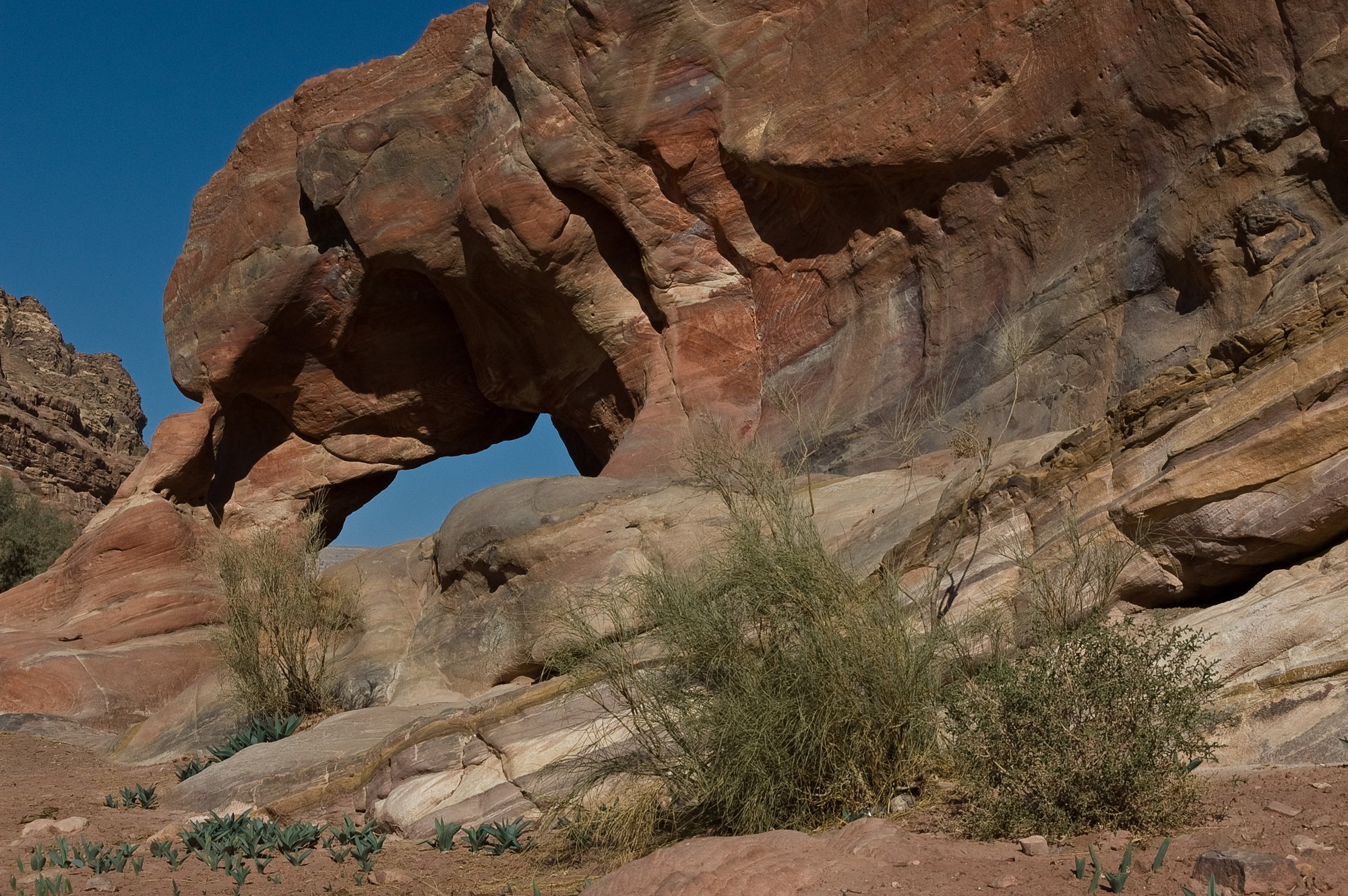
Although hardly a secret, Little Petra is worth the extra effort.

There, another monumental dreamland awaits travelers, composed of clay-colored rock and ramparts of redness.
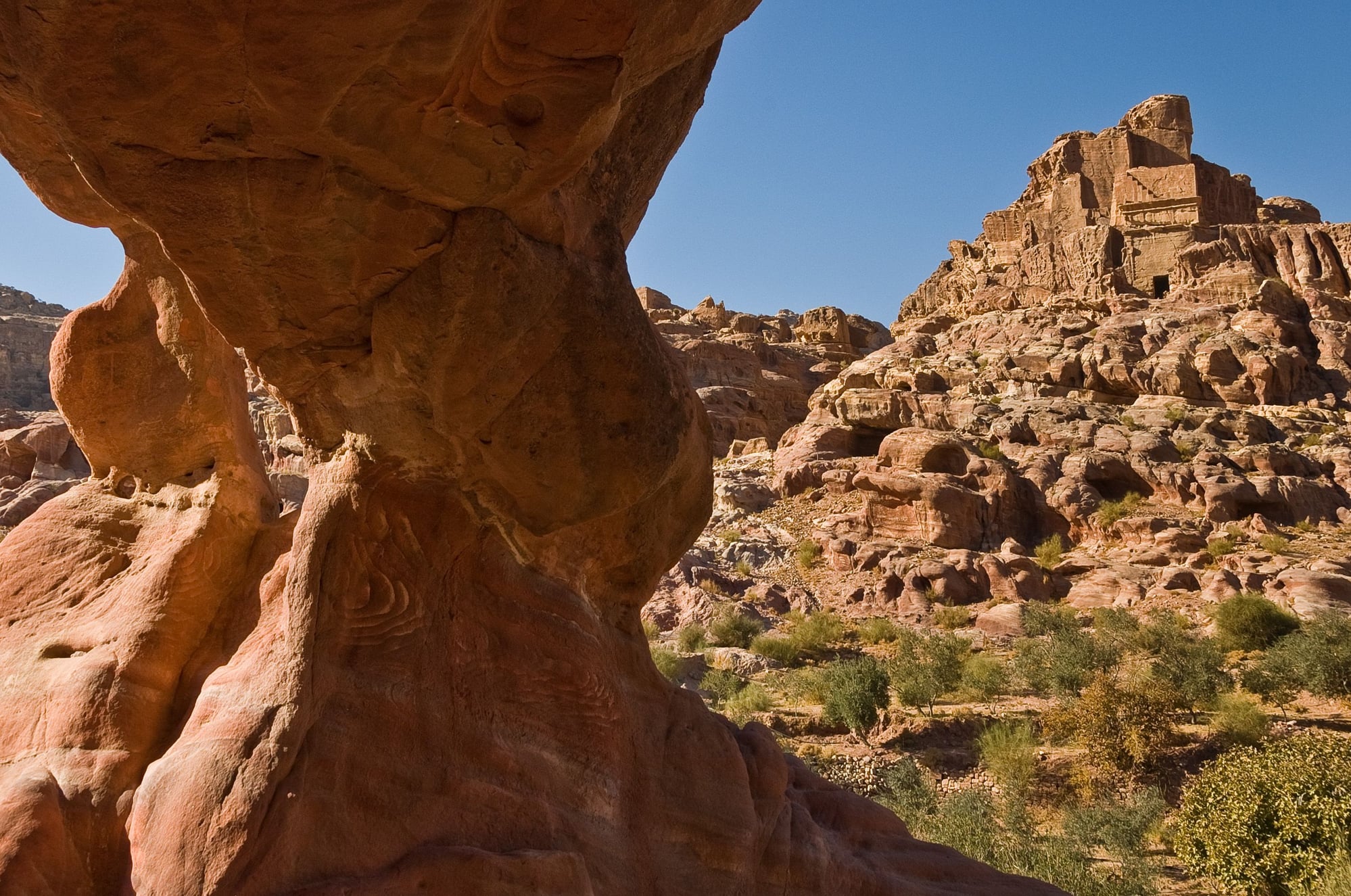
As elsewhere, tombs in all stages of completion are ready to explore.
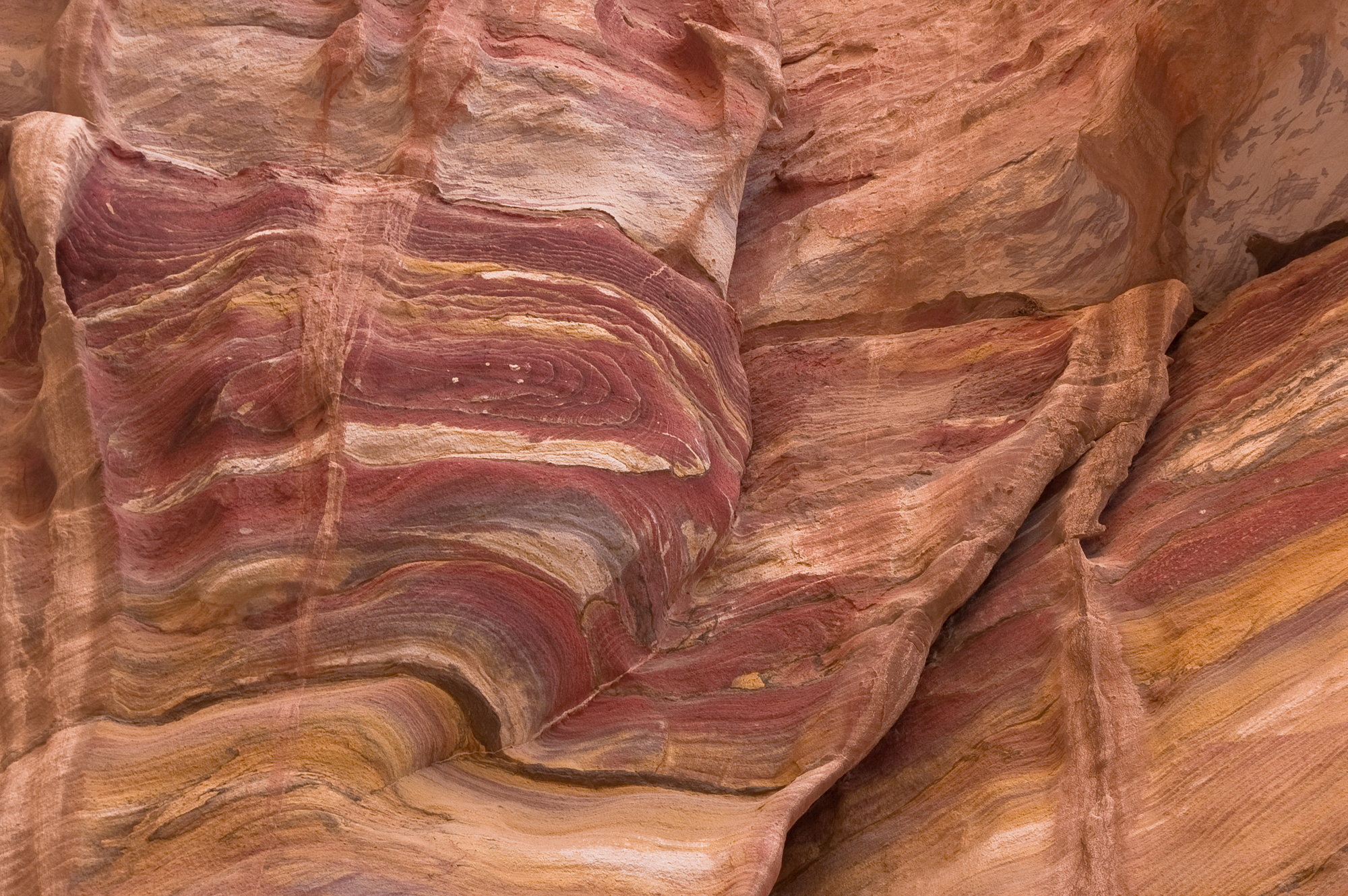
Martian?
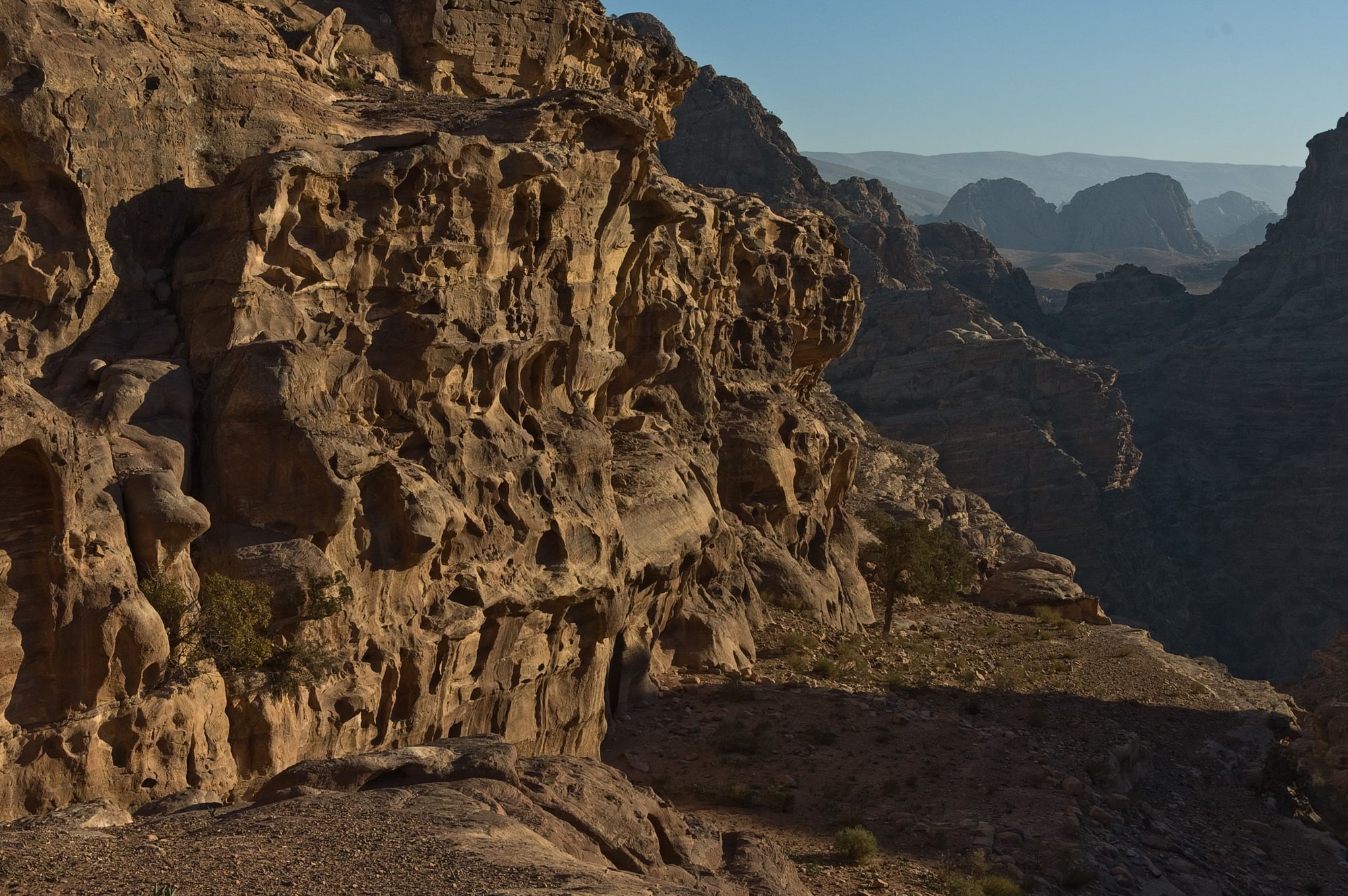
View from al Deir area. Either direction ('kif-kif') is good!
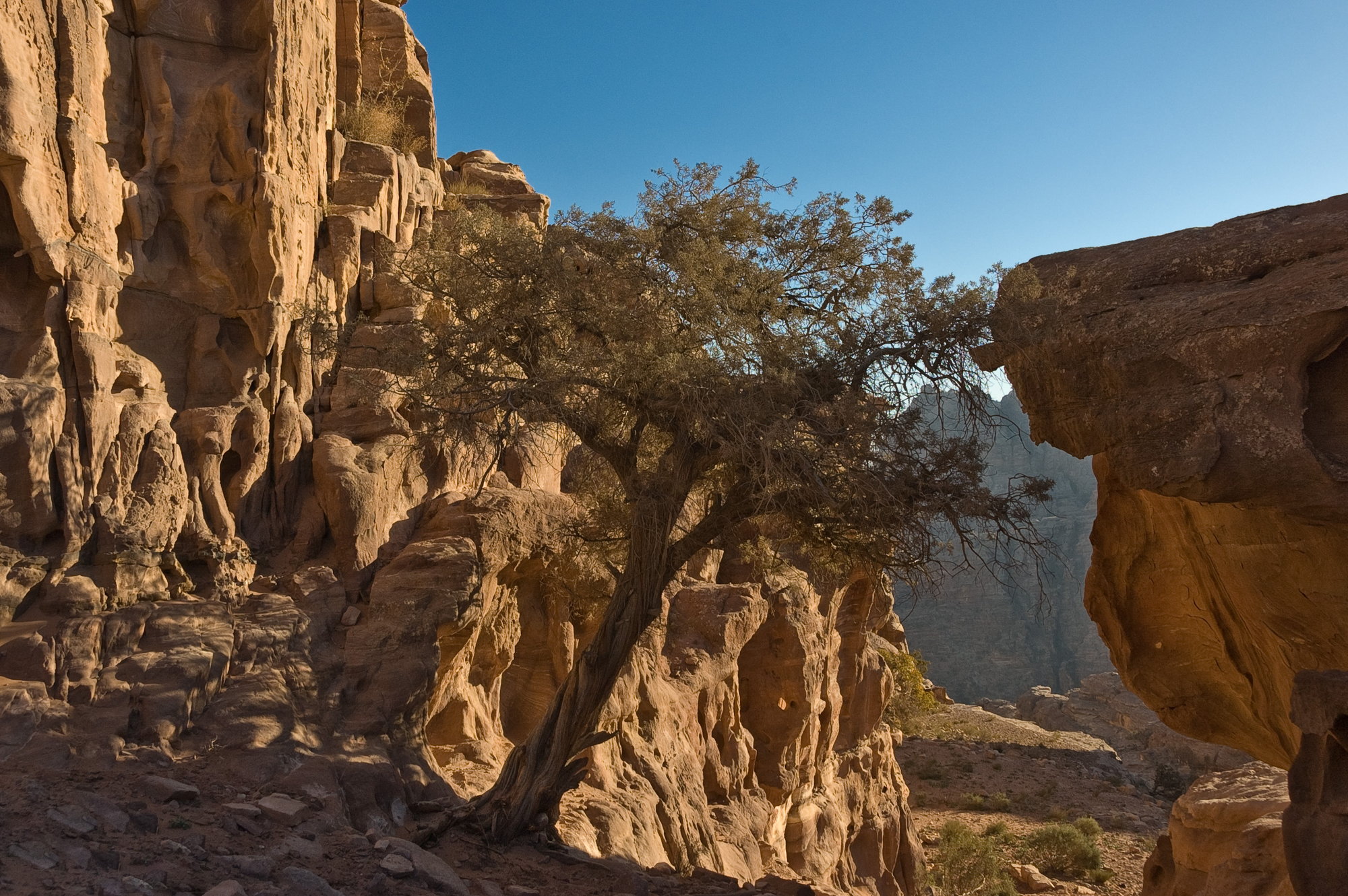
Alternate view.

Our path took us to Wadi Farasa ('butterflies'), where we met some Bdoul tribe youths assisting their grandparents. The 'hajeh' grandma shown here insisted on trading my carpal tunnel wrist support sleeve for her portrait--fair enough! Her aged hubbie seemed 'kharifa' or senile, as he tried to sell us what he claimed were ancient Roman coins. Here, hajeh wears a long, black madraga over her body, with a mandeel atop her head.
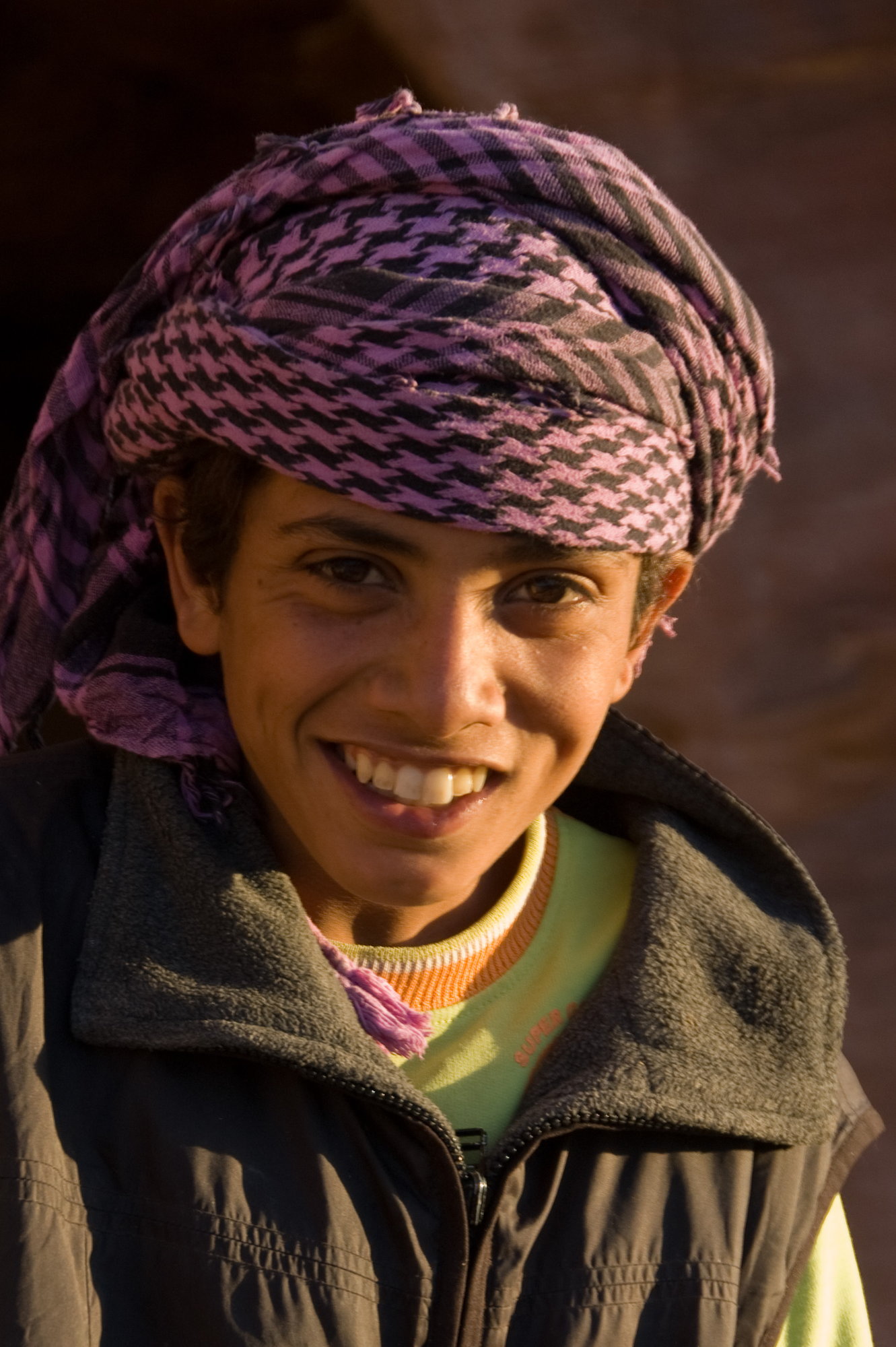
Her good-natured grandson, who helped granny to put that wrist-sleeve on. Turned out that she'd had a recent fall off their donkey (see next foto). He then invited us us to join them in a stroll.
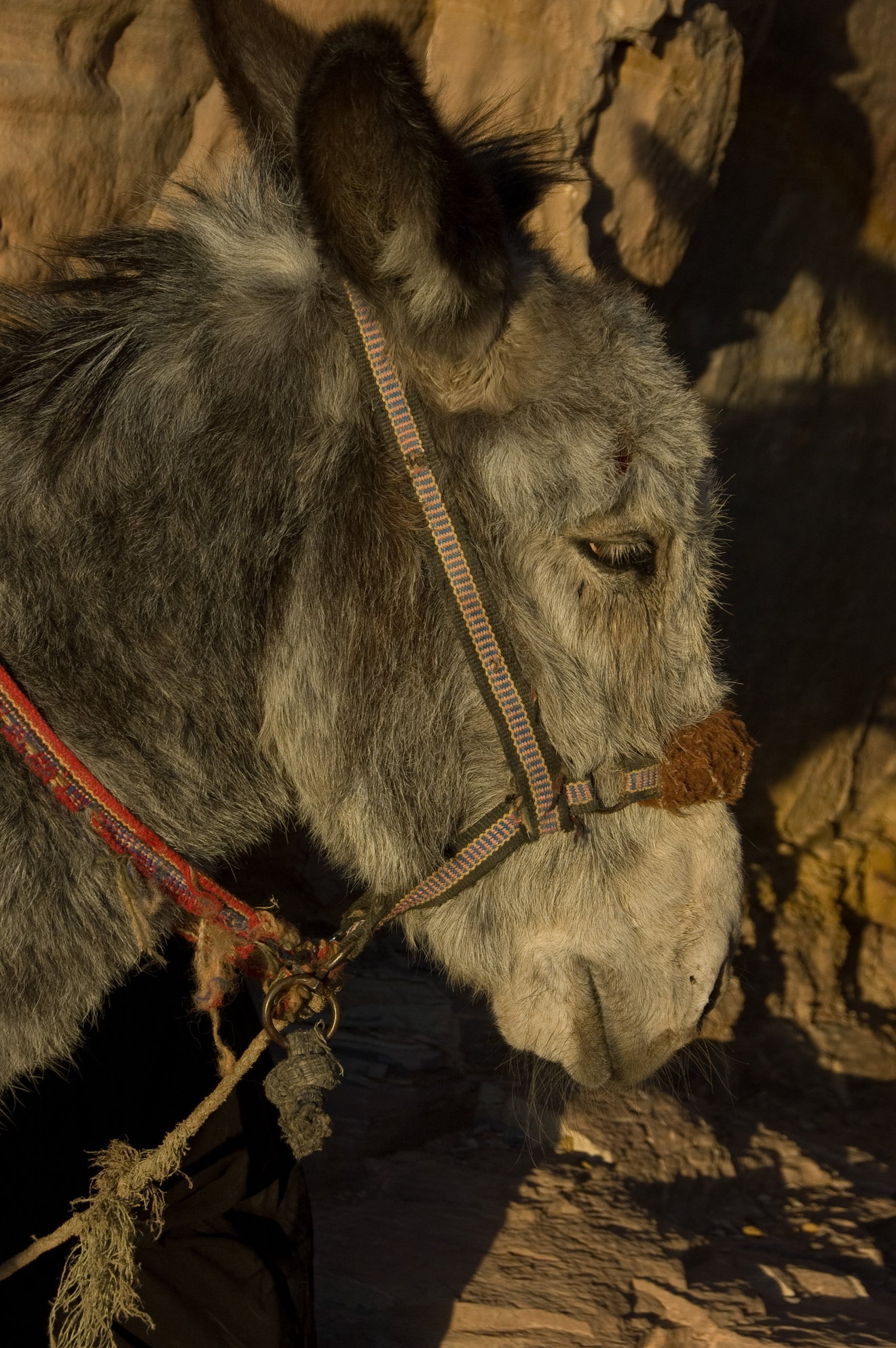
The family donkey, Koo-koo, was apparently the culprit.
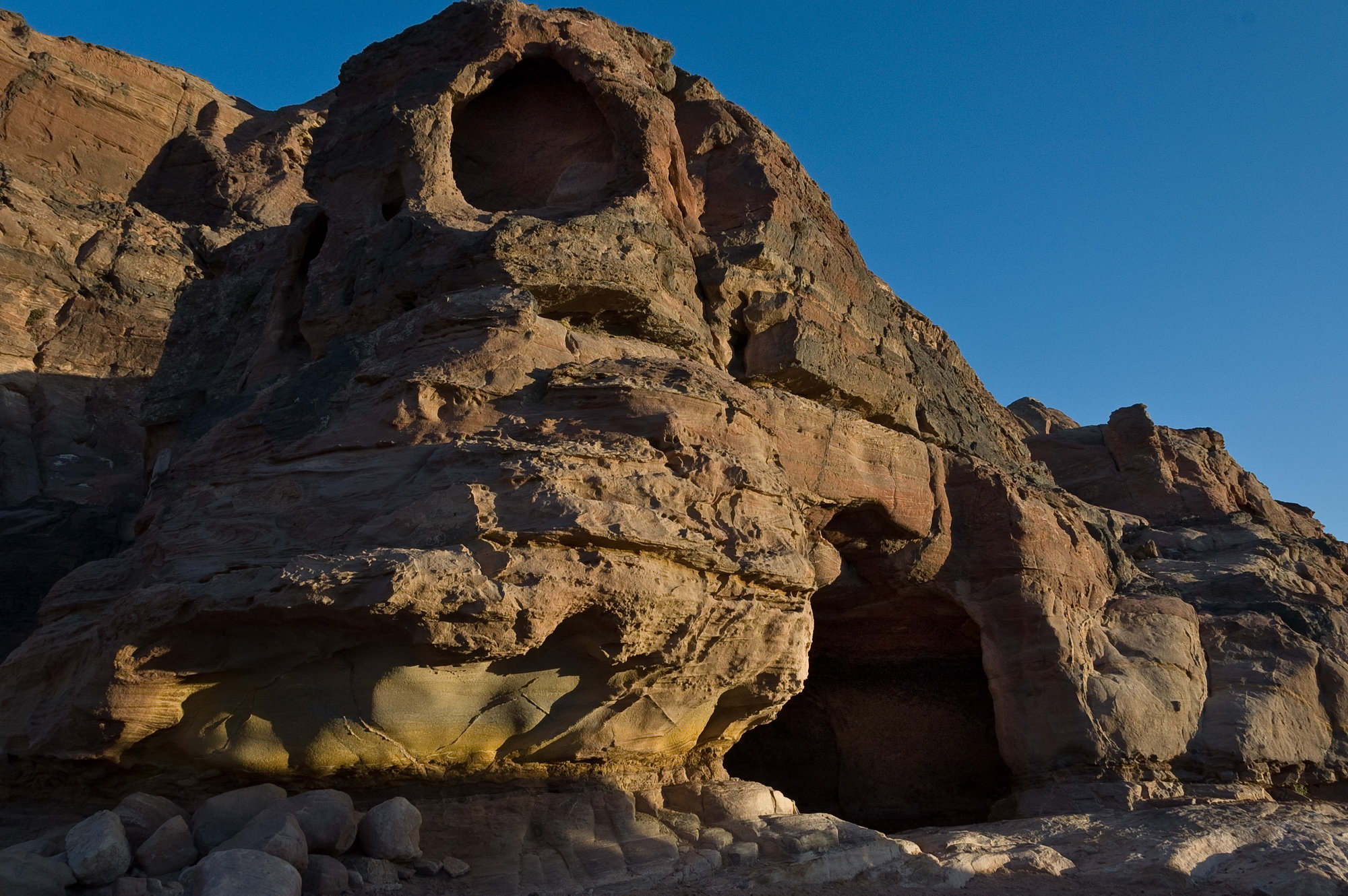
The family took us past a sort of natural storage cave. Their neighbourhood had a few other families who'd somehow succeeded in remaining in Petra, whereas many others were forced to leave.

This was their 'zreibeh' or animal pen, another cave that was probably once a tomb.
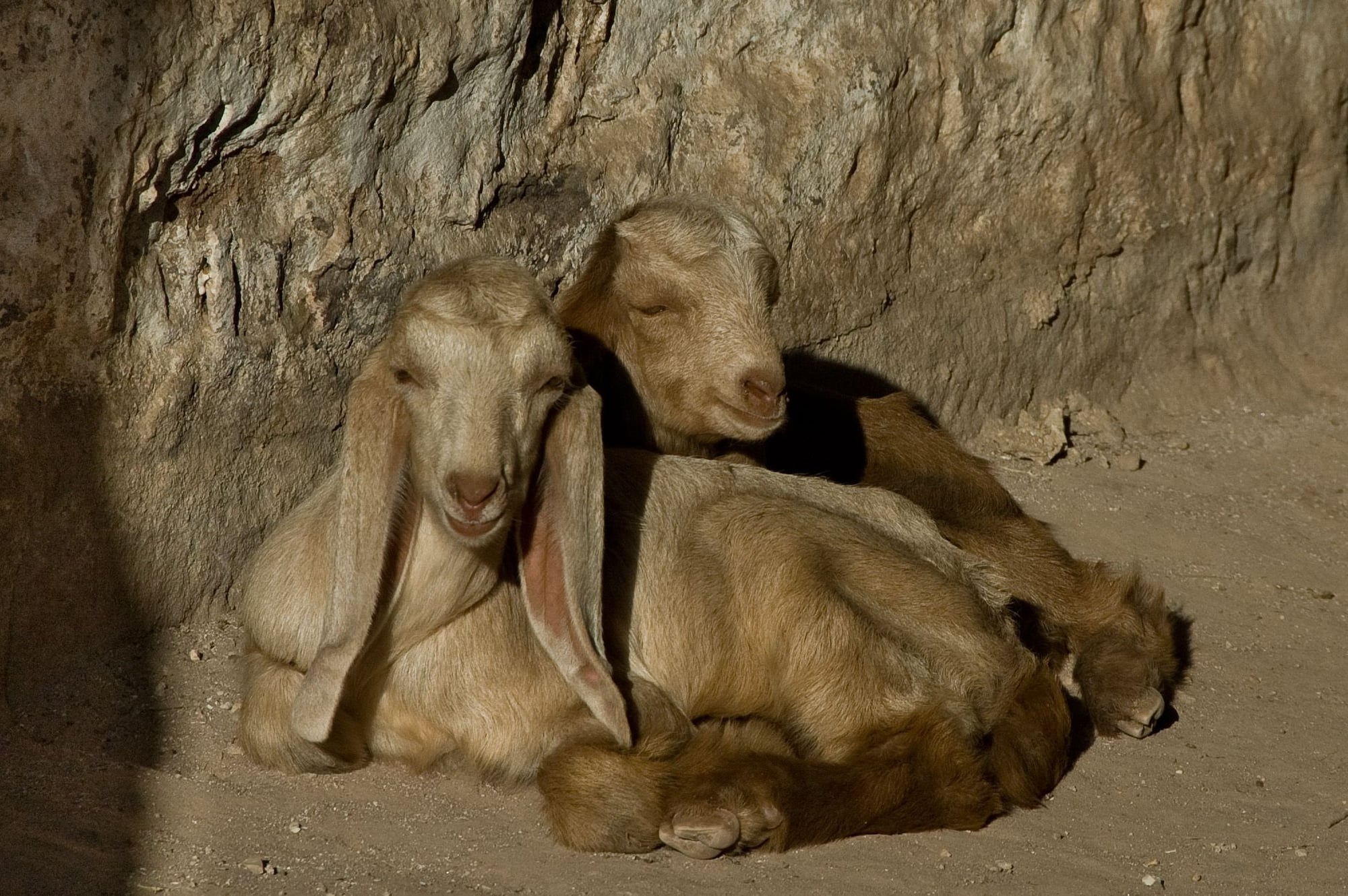
Inside the zreibeh shelter.
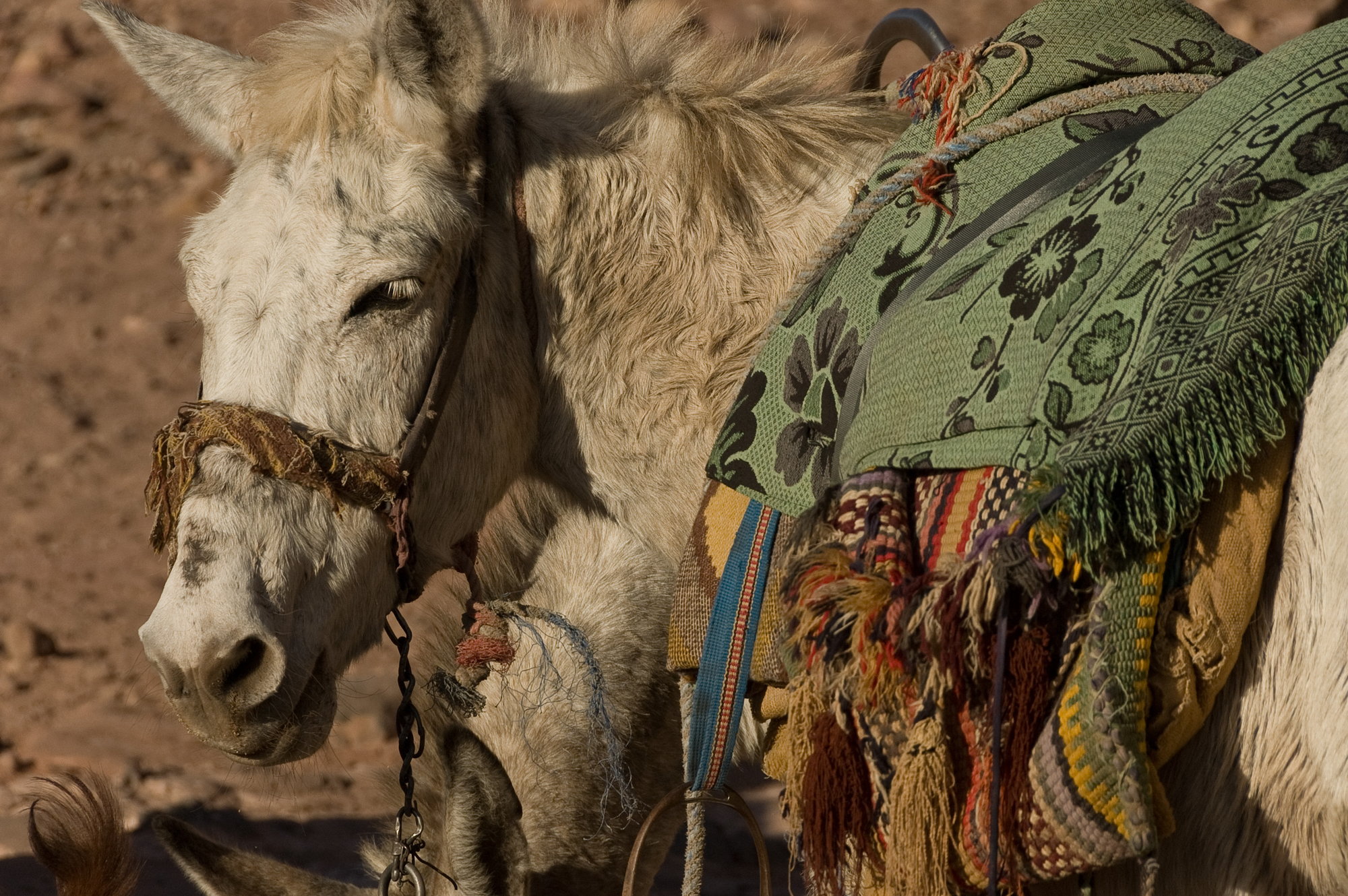
The family mule would be a valuable possession.
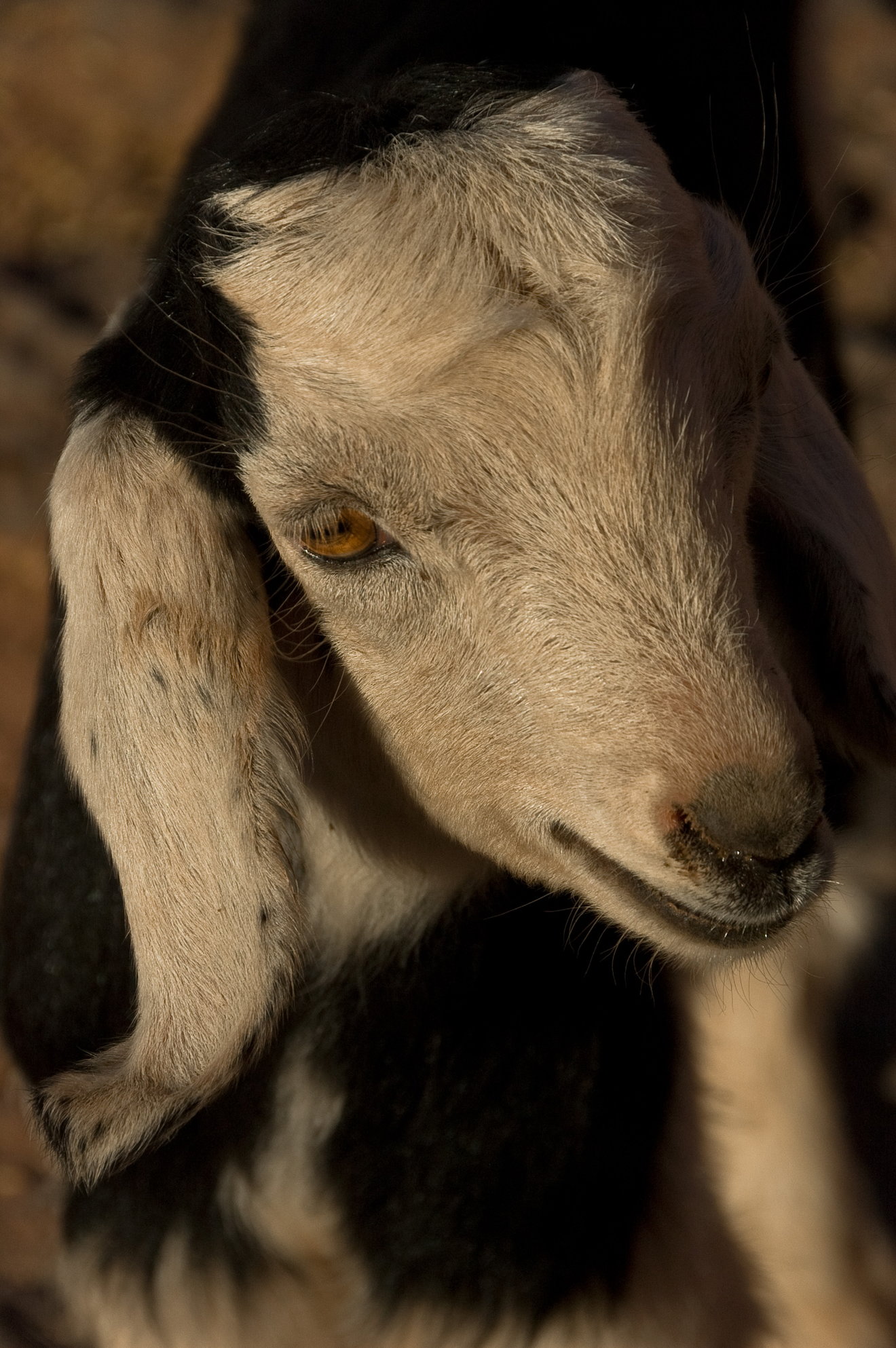
Another long-eared youngin' in the cave, safe from wolves.

A proud ram, possibly stoned after eating his fave local 'ratam' shrub--its white flowers have a psychedelic effect. The family would try to keep him from eating their 'j. anubis' plants because those were useful to grind, then mix with water to make a natural soap.
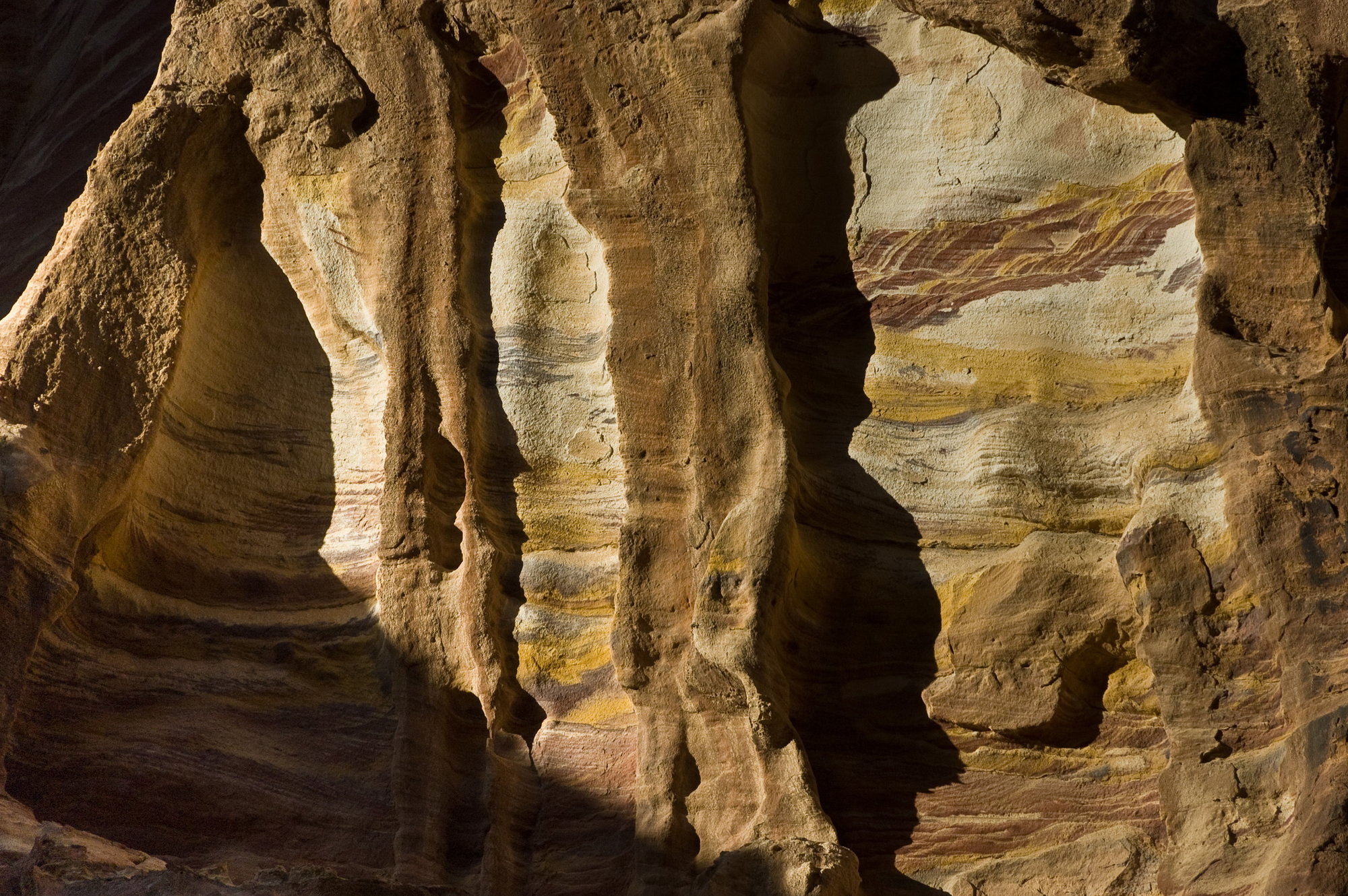
This was Mrs Z's fave wall in Little Petra.
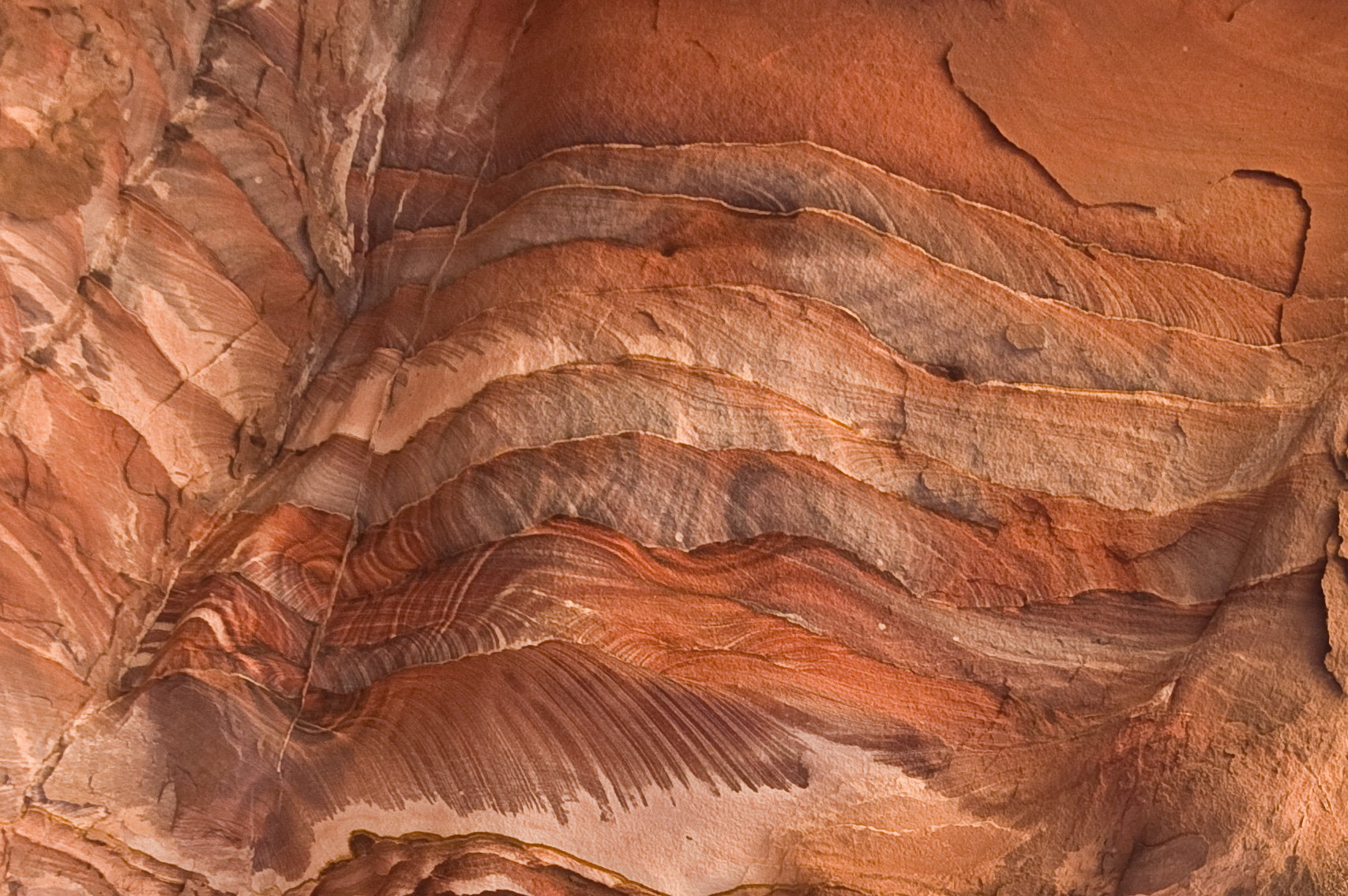
This was mine, a ceiling actually.
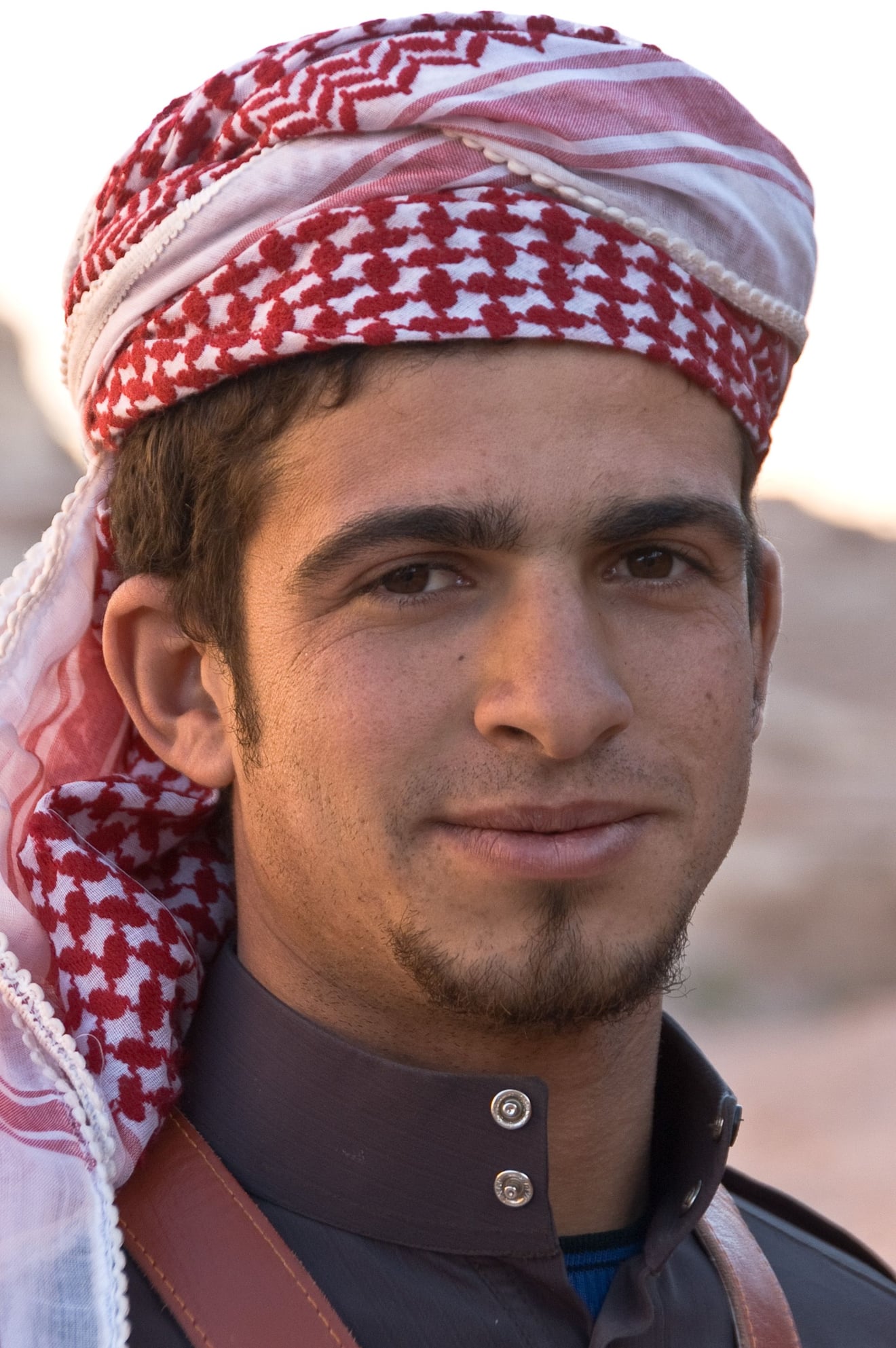
Another friendly local.
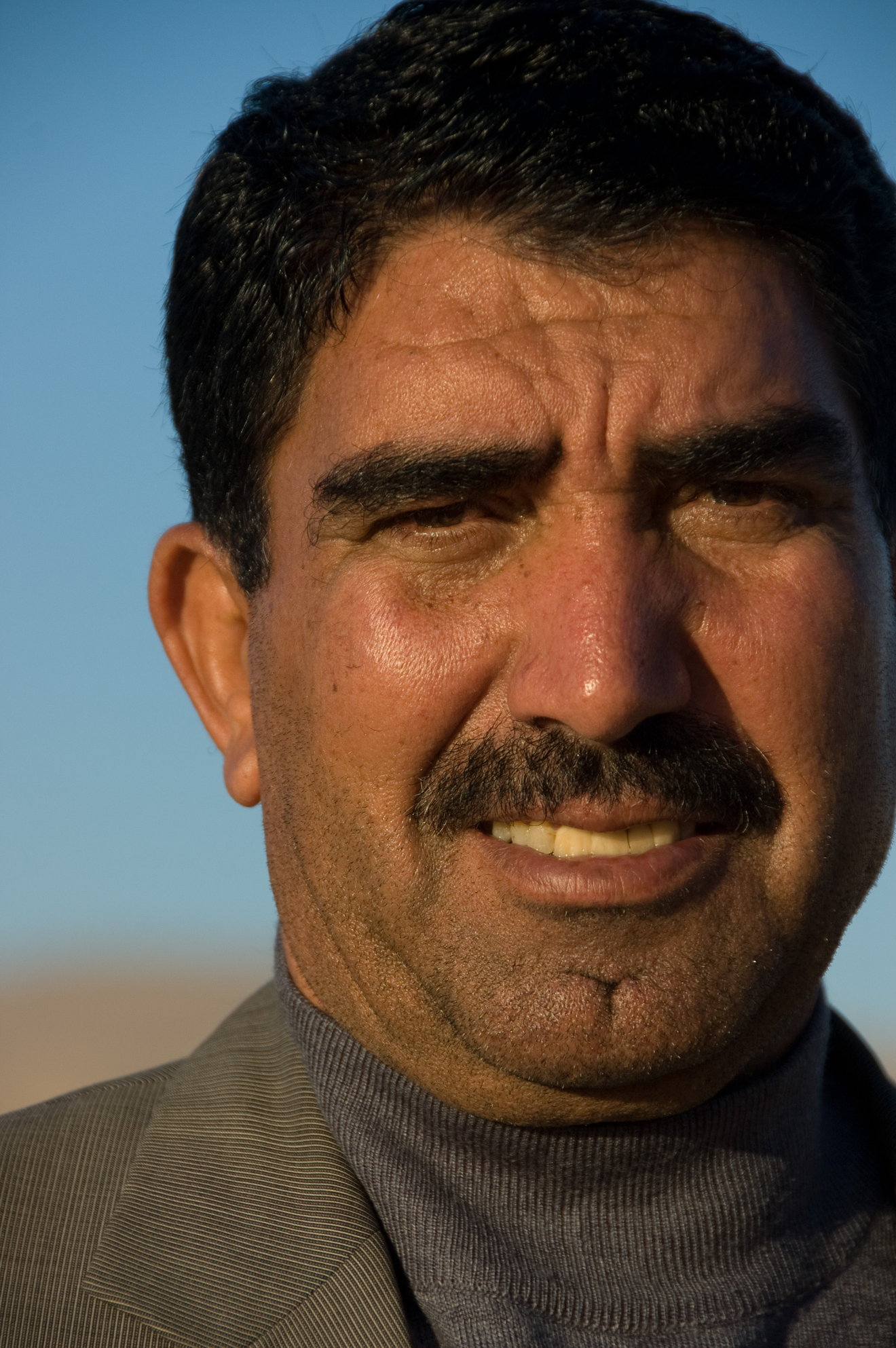
Khalid Falahat is a local taxi driver who more than once went above and beyond. In the tradition of local cabbies, he refused to allow his left ear to be photographed.

A dreamy sunset near Petra. *Time for more music, maybe two?
For many, it is Petra's arresting sandstone landscape that they never forget. Beautifully swirling striations and vivid patterns abound, designed in a wide range of stripes. Abstract patterns of eroded, naturally-tinted stone covers cliffs, surrounds tomb doorways and spreads across temple ceilings. The exquisitely hand-hewn caves, tunnels and fašades were wrought from this rock. Some lay unfinished.

A dreamy 'al falq' or sunrise near Petra. A Lost City-quality pervades beneath towering mountains.

The site is not without accidental dangers. Flash floods and also falling rock falls have taken traveler lives. The Muessra tomb collapsed a few weeks prior to our arrival. At least one tourist fell to their death while taking a dangerous selfie high above the iconic Treasury 'Al Kazneh'.

This textured land seems like an art gallery. Abstract patterns of eroded, naturally-tinted stone form multi-colored displays. Brilliant bands of russet wonder are matched by carmine and rosy red sections. Elsewhere, chocolate, salmon, mustard, ham and curry. Whether pale or strong, simple or complex, the artistic visuals bleed into each other.

The points in color concentration are rich in iron oxide and magnesium, remnants from ancient Gondwanaland 550 million years ago.

A tomb entrance. Geologists refer to these iridescent rock rhythms as 'paragrams': erosion lines matched with color tonal variance.

'I Married a Bedouin' is one good book recommendation, chronicling how a Dane married a local man. Their adult son now runs a Petra souvenir stand.

Tourism is utterly crucial here, and folks like this policeman are hired to keep order.

But teens like Solomon (shown here) remain confused about whether it is worth it to complete their education, or to instead immediately plant roots in some sort of tourism industry position. This young man joins his colleagues from the nearby hardscrabble village of Um Sayhoun, to offer donkey rides to tourists.

Solomon's pal, another ('shebab') teen keenly aware of the limitations of local career opportunities.

There is a kind of back entry to Petra, a less-known route from Beida village into Siq al Berid (i.e. 'cold canyon'--due to greater shade), aka little Petra.

Although hardly a secret, Little Petra is worth the extra effort.

There, another monumental dreamland awaits travelers, composed of clay-colored rock and ramparts of redness.

As elsewhere, tombs in all stages of completion are ready to explore.

Martian?

View from al Deir area. Either direction ('kif-kif') is good!

Alternate view.

Our path took us to Wadi Farasa ('butterflies'), where we met some Bdoul tribe youths assisting their grandparents. The 'hajeh' grandma shown here insisted on trading my carpal tunnel wrist support sleeve for her portrait--fair enough! Her aged hubbie seemed 'kharifa' or senile, as he tried to sell us what he claimed were ancient Roman coins. Here, hajeh wears a long, black madraga over her body, with a mandeel atop her head.

Her good-natured grandson, who helped granny to put that wrist-sleeve on. Turned out that she'd had a recent fall off their donkey (see next foto). He then invited us us to join them in a stroll.

The family donkey, Koo-koo, was apparently the culprit.

The family took us past a sort of natural storage cave. Their neighbourhood had a few other families who'd somehow succeeded in remaining in Petra, whereas many others were forced to leave.

This was their 'zreibeh' or animal pen, another cave that was probably once a tomb.

Inside the zreibeh shelter.

The family mule would be a valuable possession.

Another long-eared youngin' in the cave, safe from wolves.

A proud ram, possibly stoned after eating his fave local 'ratam' shrub--its white flowers have a psychedelic effect. The family would try to keep him from eating their 'j. anubis' plants because those were useful to grind, then mix with water to make a natural soap.

This was Mrs Z's fave wall in Little Petra.

This was mine, a ceiling actually.

Another friendly local.

Khalid Falahat is a local taxi driver who more than once went above and beyond. In the tradition of local cabbies, he refused to allow his left ear to be photographed.

A dreamy sunset near Petra. *Time for more music, maybe two?
Last edited by zebec; Mar 21st, 2022 at 09:46 PM. Reason: yallah yallah yallah
#8
Thanks Zebec! We were so lucky to complete our trip to Egypt and Jordan in January 2020 as COVID was arriving.
We loved all of Jordan and hope to return. You captured it so beautifully with your photos! Your portraits of Jordanians are especially beautiful.
We loved all of Jordan and hope to return. You captured it so beautifully with your photos! Your portraits of Jordanians are especially beautiful.
#9
Original Poster
Join Date: Jan 2008
Posts: 7,514
Likes: 0
Received 0 Likes
on
0 Posts
Thank you Schmerl & HT!
FUN FACT: it seems that the Nabataeans were soooooo into acquisition that public fines awaited those Petra residents who did not increase their annual yields!
Jayzus.
FUN FACT: it seems that the Nabataeans were soooooo into acquisition that public fines awaited those Petra residents who did not increase their annual yields!
Jayzus.
#10
Original Poster
Join Date: Jan 2008
Posts: 7,514
Likes: 0
Received 0 Likes
on
0 Posts
SIDEBAR: this is the khuff or Camel section. No discussion of desert travel would be complete with some portrayal of theses ships of the desert ('safnat al sahra'). They can go 50 days without water as they traverse the sands. The most prevalent kind in Jordan are dromedaries, a swift breed with one hump ('sanam'). Others are trained as thoroughbred racers. Every inch of a camel is somehow utilized, hence their description as 'attalah' or gifts from God.
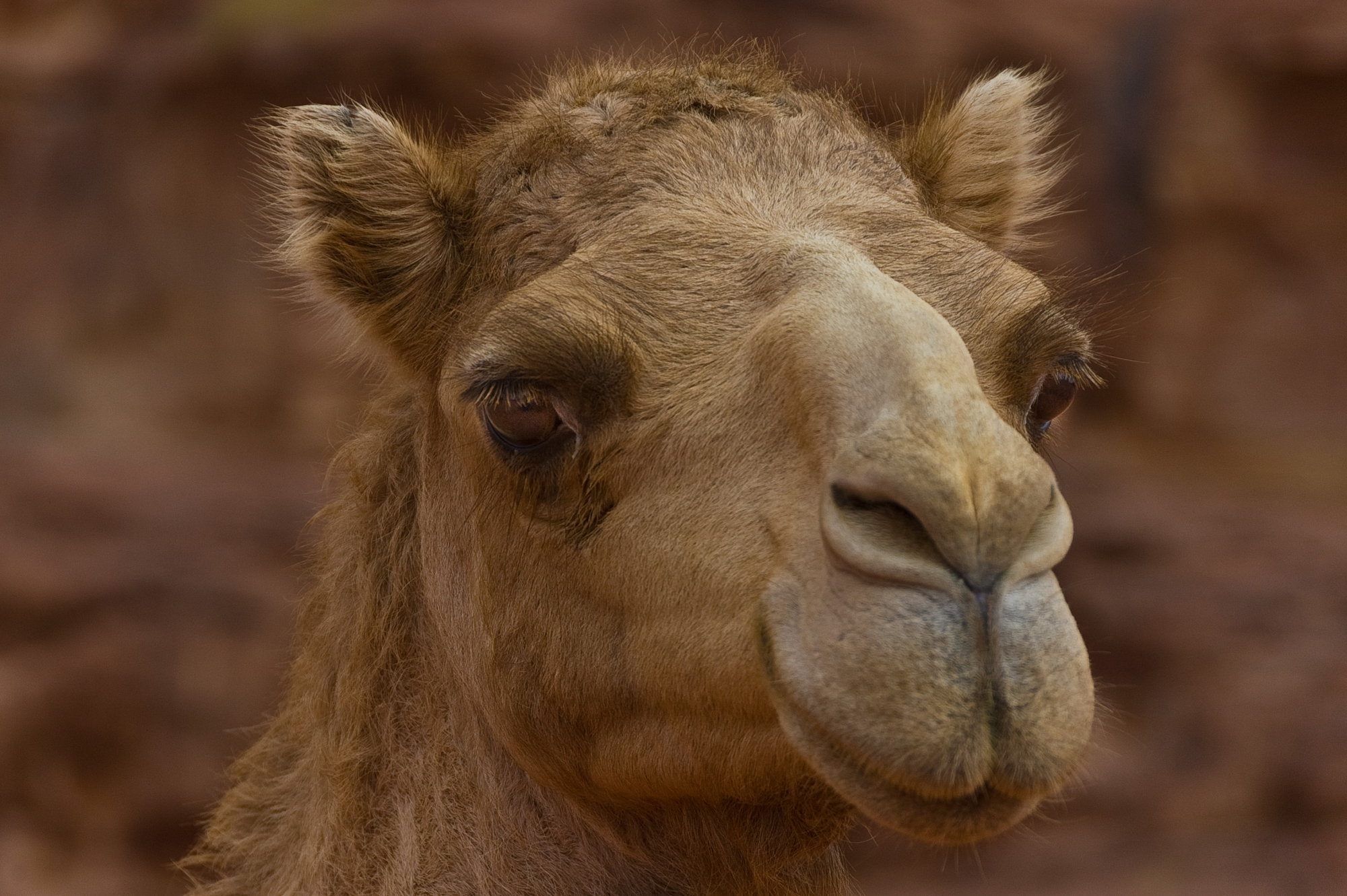
This 'naqa' or mama camel, was lovingly looked after by locals. She was the most common color, brown or 'hamra'. Seen here, her snout ('burtam'), nose bridge ('arnun') and forehead ('hijaj'). I will now describe her every eyelash and...(NO! NO! NO! We're good Zebec! Mkay?---editors)
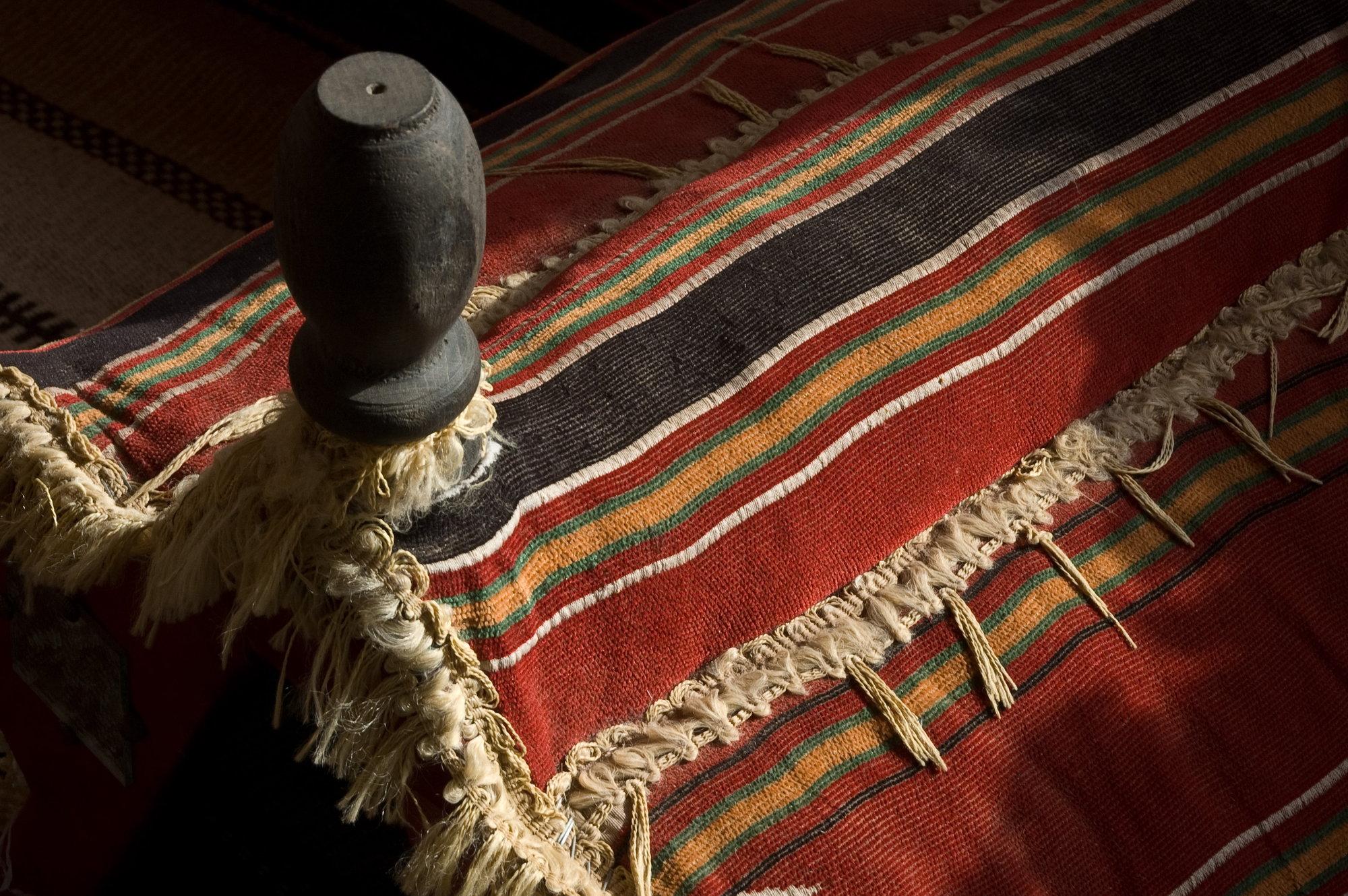
A striking 'shadad' camel saddle.

Another ancient rock inscription, showing a human rider atop his camel's 'sulb'. Had it been able to depict accurate colors, the black 'malha' and white 'wadha' types would've been interesting to see.
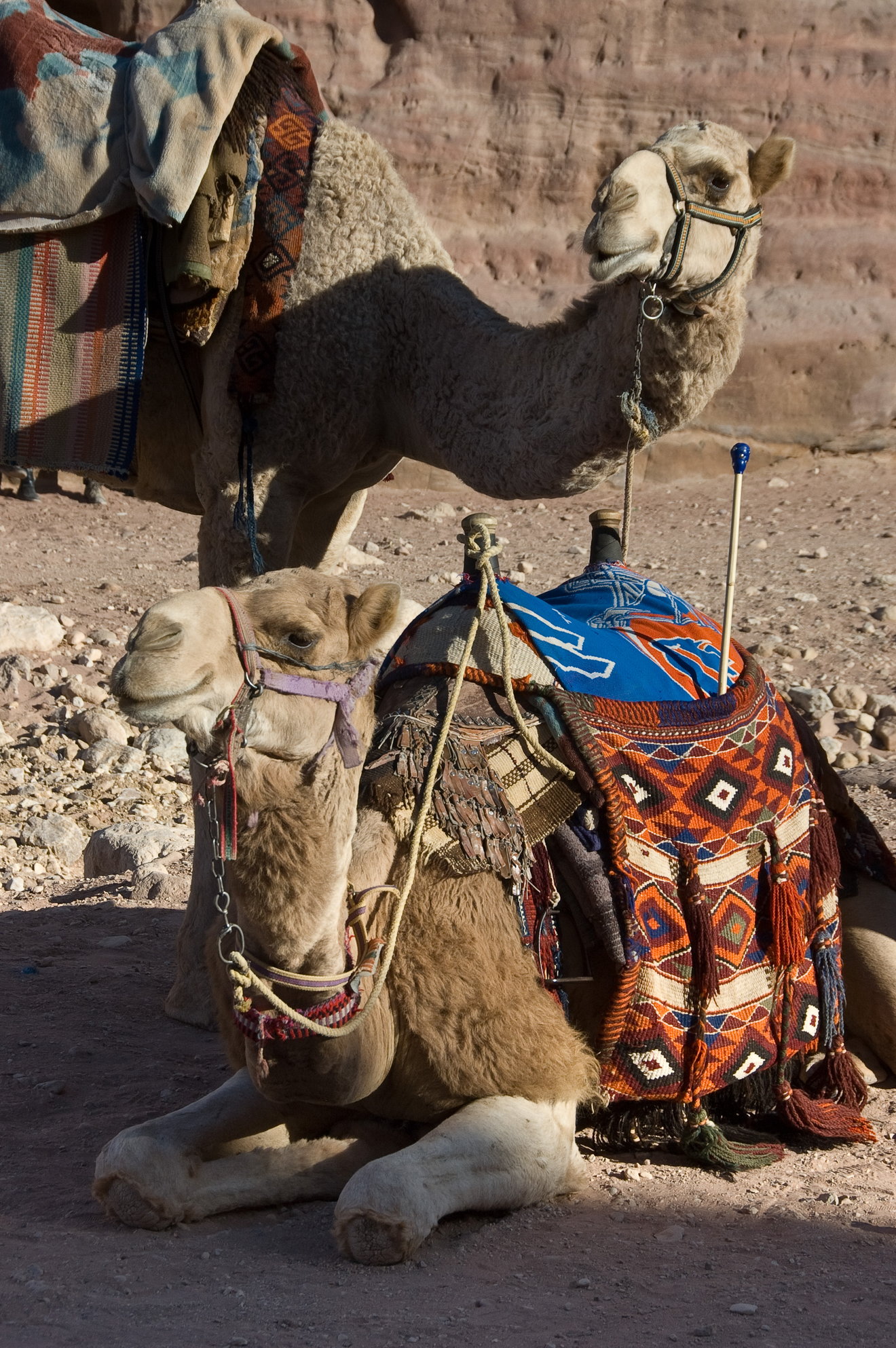
Camels will spit, but this pair seemed like amiable sorts.

We brought back this camel skull, in order to later donate it to our school's brand-new Science Lab.

Not sure whether some of these thick wool items are associated with camels or whether they're 'batanyah' blankets?? Movies: besides the obvious classic *'Lawrence of Arabia', there exists another more modern production depicting that same time period: 'Theeb'. That film shows a young bedu boy's misadventures through the desert. *note that Lawrence eventually came to regret his role in that contentious war, admitting that his ulterior motives did not serve the needs of local people.

This 'naqa' or mama camel, was lovingly looked after by locals. She was the most common color, brown or 'hamra'. Seen here, her snout ('burtam'), nose bridge ('arnun') and forehead ('hijaj'). I will now describe her every eyelash and...(NO! NO! NO! We're good Zebec! Mkay?---editors)

A striking 'shadad' camel saddle.

Another ancient rock inscription, showing a human rider atop his camel's 'sulb'. Had it been able to depict accurate colors, the black 'malha' and white 'wadha' types would've been interesting to see.

Camels will spit, but this pair seemed like amiable sorts.

We brought back this camel skull, in order to later donate it to our school's brand-new Science Lab.

Not sure whether some of these thick wool items are associated with camels or whether they're 'batanyah' blankets?? Movies: besides the obvious classic *'Lawrence of Arabia', there exists another more modern production depicting that same time period: 'Theeb'. That film shows a young bedu boy's misadventures through the desert. *note that Lawrence eventually came to regret his role in that contentious war, admitting that his ulterior motives did not serve the needs of local people.
#11
Original Poster
Join Date: Jan 2008
Posts: 7,514
Likes: 0
Received 0 Likes
on
0 Posts
Our good friends from NY, Kev and Teresa, were present at Petra during a similar flash flood a few years prior to this one in 2018. See @ roughly the 11 min. mark and you'll understand the dangers. Back in '63, an entire group of French tourists lost their lives in a Petra flash flood.
#12
Join Date: Apr 2006
Posts: 9,654
Likes: 0
Received 0 Likes
on
0 Posts
Amazing photos! We visited Jordan right before the pandemic broke out and your photos make me long to return. I can't imagine how difficult it must have been for those areas so reliant on tourism these last couple of years.
#13
Original Poster
Join Date: Jan 2008
Posts: 7,514
Likes: 0
Received 0 Likes
on
0 Posts
Thank you too KT, and what a coincidence that both you and HT above, managed to get your trips in, just under the covid 'wire'. I'm glad that it worked out for you both.
So now we change the channel to Wadi Rum. Such stunning landscape. Now that the pandemic seems to be waning, there will be plenty of new willing prisoners there, deep in the desert. A timeless Zen atmosphere is evident. Few places in Jordan demand as much exploration as this protected area of unspoiled natural beauty. Locals call it 'harra' or rocky desert. Vast cliffs and canyons, epic vistas plus dramatically-bulging rock formations are spread throughout these desert plains bordering Saudi Arabia. It can be hard to believe that all this is natural landscape and not some brooding geography of alien origin. As in Petra, unique tafoni can be found, born of an ancient seabed which once carved the elements into otherworldly honeycomb. Visitors will salute Mother Nature and her consort Time ('jawan'), for creating such unique, differentially-weathered wonders. Wadi Rum's secluded sites are reached by 4WD jeeps and pickups, horses, camels and also by bus #11 (get it? stick legs). Hikers enjoy this place. Enough already--I'm beginning to sound like a travel brochure. Let's return to fotos.

Those interested in going horseback might contact Sue at her 'Bait Ali Camp' in nearby Shakharia--she is an expert rider.

Shutterbugs are advised to place their cameras inside a good quality bag or container here. A single grain of sand can mess up your desert trek adventure.

On our first day in Wadi Rum, we helped to tow out an elderly couple whose vehicle had got stuck in the sand back during 'saabah' or sunrise. They'd been there for hours. They were a thankful but superstitious pair, from an age when hot-iron branding and drinking wildcat blood were norms. As recently as '98, Wadi Rum saw an honor killing-stabbing.
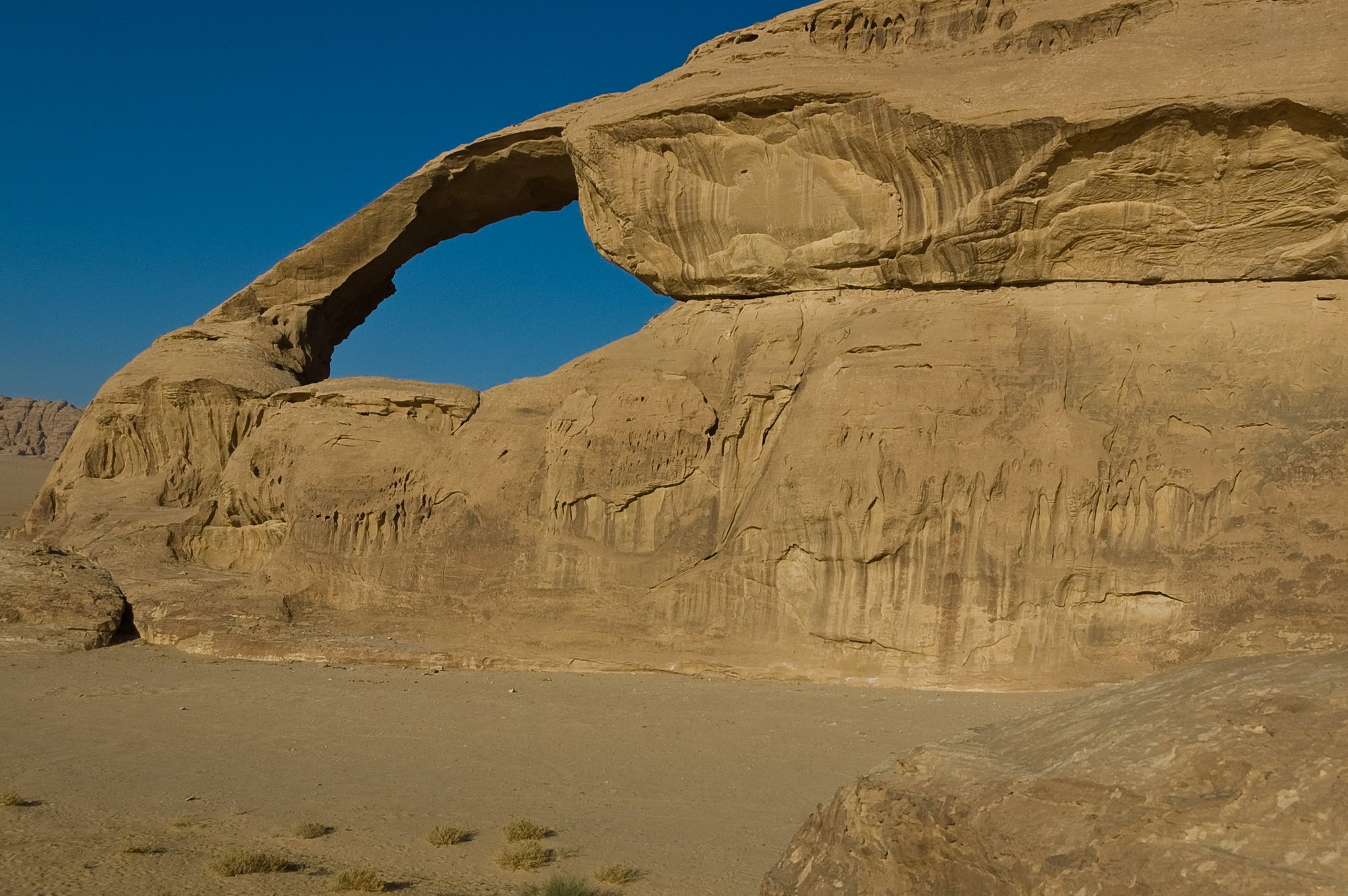
Picturesque bridge-arches are cliche images in Wadi Rum. Pictured here is the natural Jebel Kharaz (translation: 'full memory card'), found along the stony Sabah route.
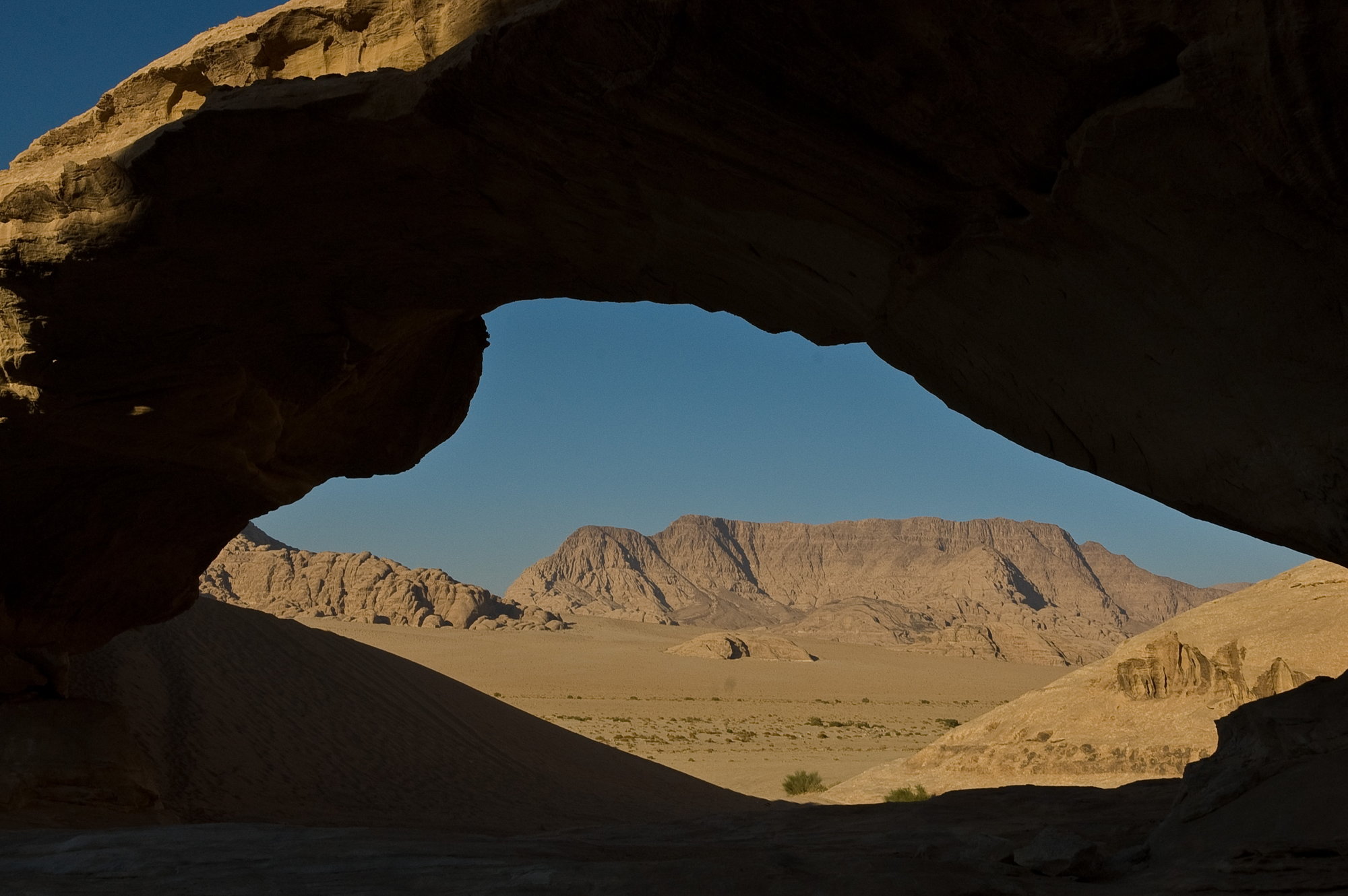
From inside the same spot, we see Abu al-Fodor in the distance. Other such arches include Um Fruth.

There are no Petra-esque elaborate tombs recalling the Nabatean past in Wadi Rum, but the rockscapes more than make up for that. Off-road jeep tours are a great way to enjoy Wadi Rum plus its equally-impressive outskirts. Note that locals tend to buy their vehicles across in Saudi Arabia, due to punitive local taxes. Toyotas are popular.
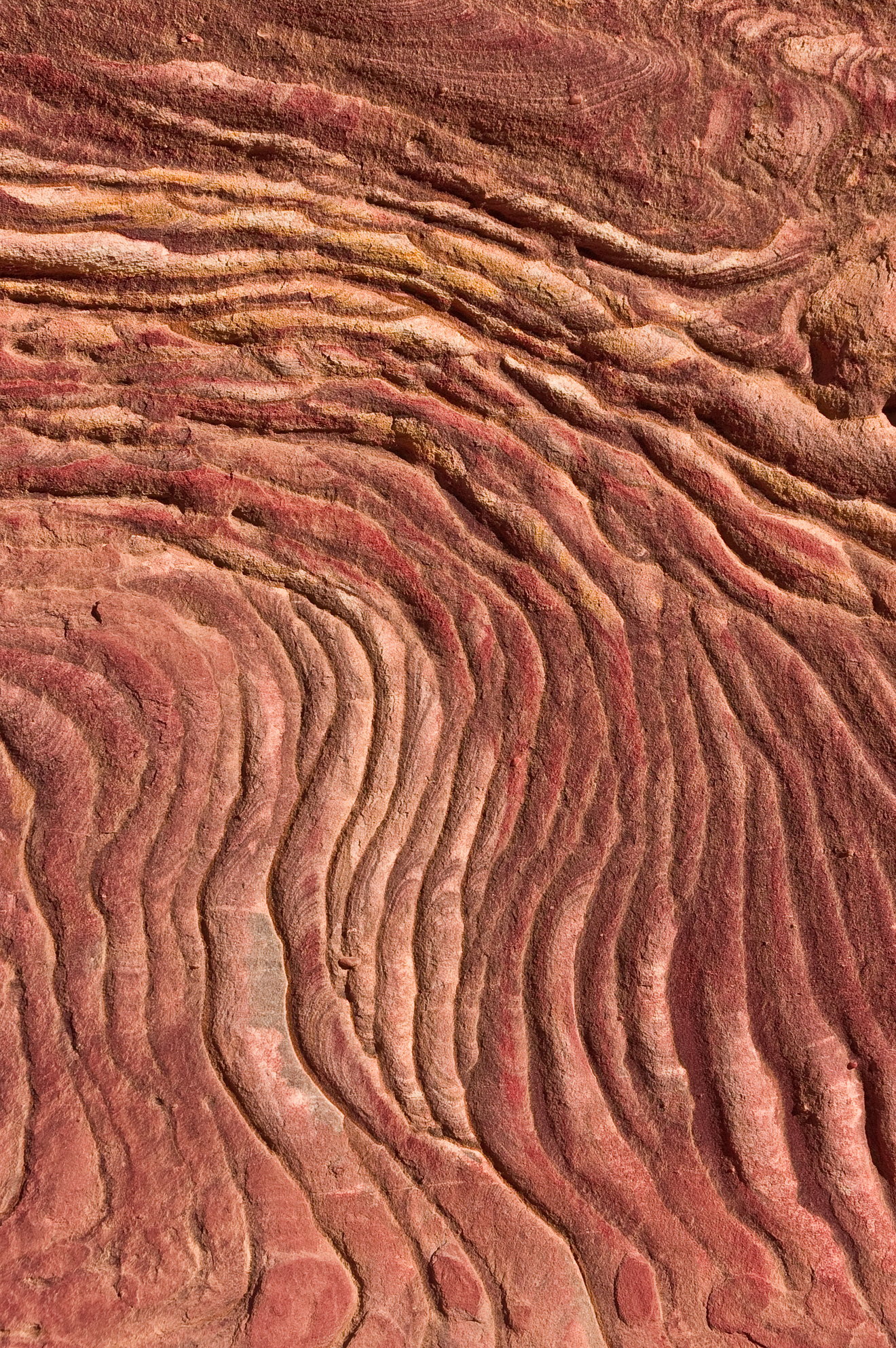
One such example. My wife enjoyed painting some watercolor abstracts, with the irony that abstract shapes had been provided all around her!
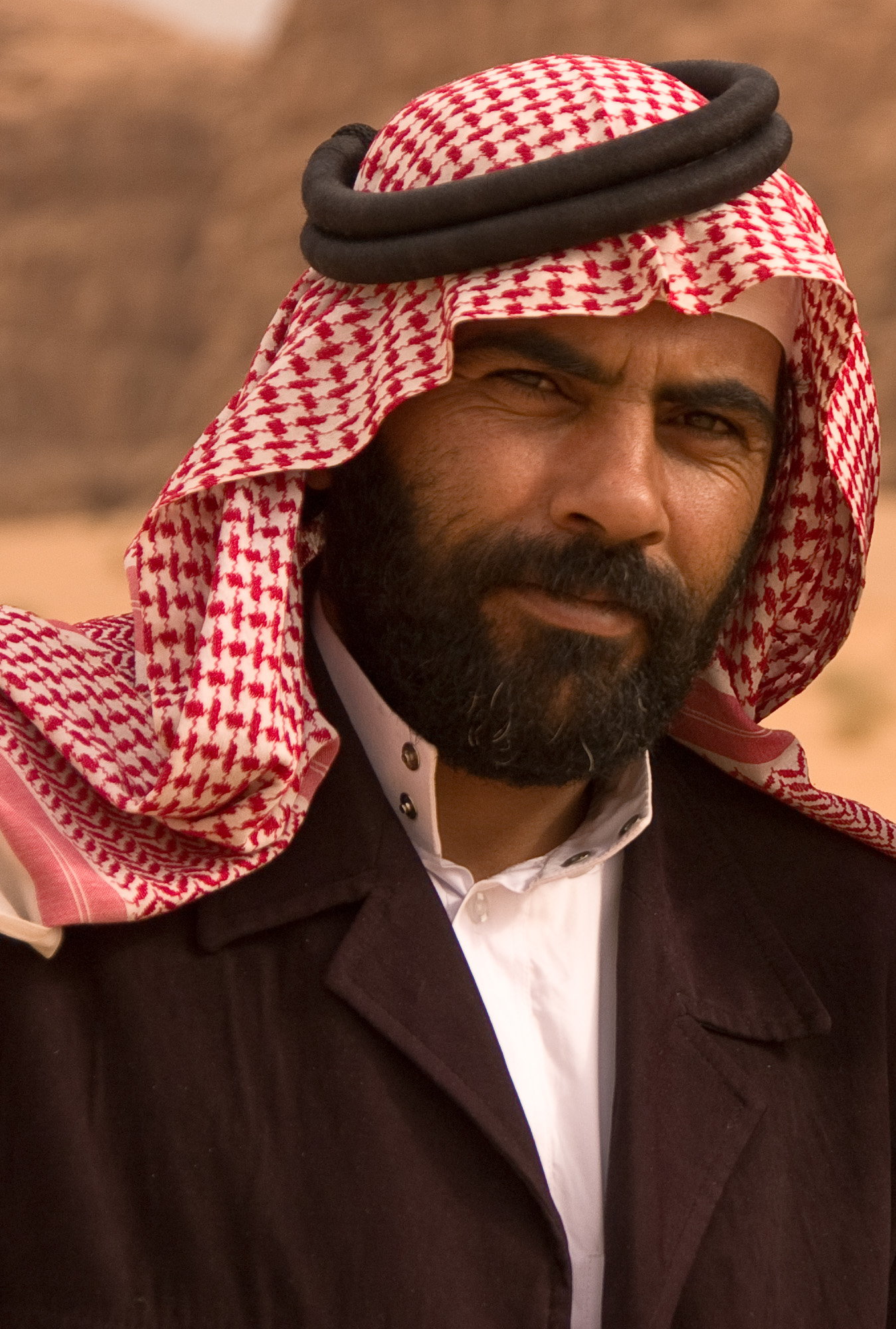
For our nights camping under the stars, we'd booked with ex-policeman Obeid Naser Al-Amareh. We'd done so because his Azzabi Bedouin Life camp had excellent reviews. Obeid was of the Zuweydeh tribe, which is based in Diseh village. Unfortunately he was in Amman with a sick relative, so he left his ruggedly handsome brother Awad (shown here) in charge of the tent. He was assisted by Obeid's 19 yr old son Nial. Awad explained that he was fond of 'vitamin C'=ciggies.
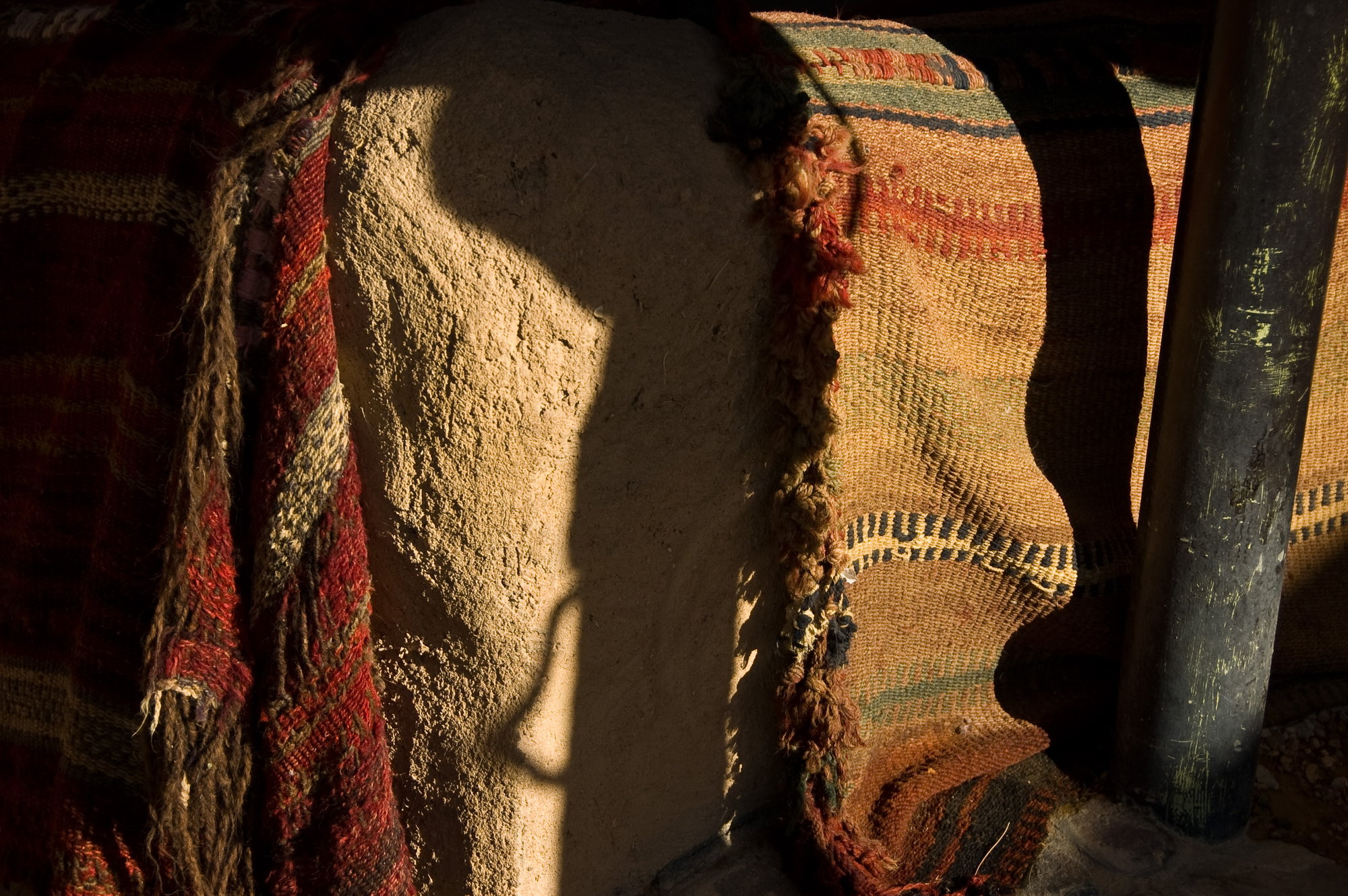
Some blankets next to the 'amoud' support pole. The six poles throughout the tent each had different names. As evening ('masa') approached, propane heaters allayed our concerns about the desert winter cold. My wife brought out her precious stargazing charts.
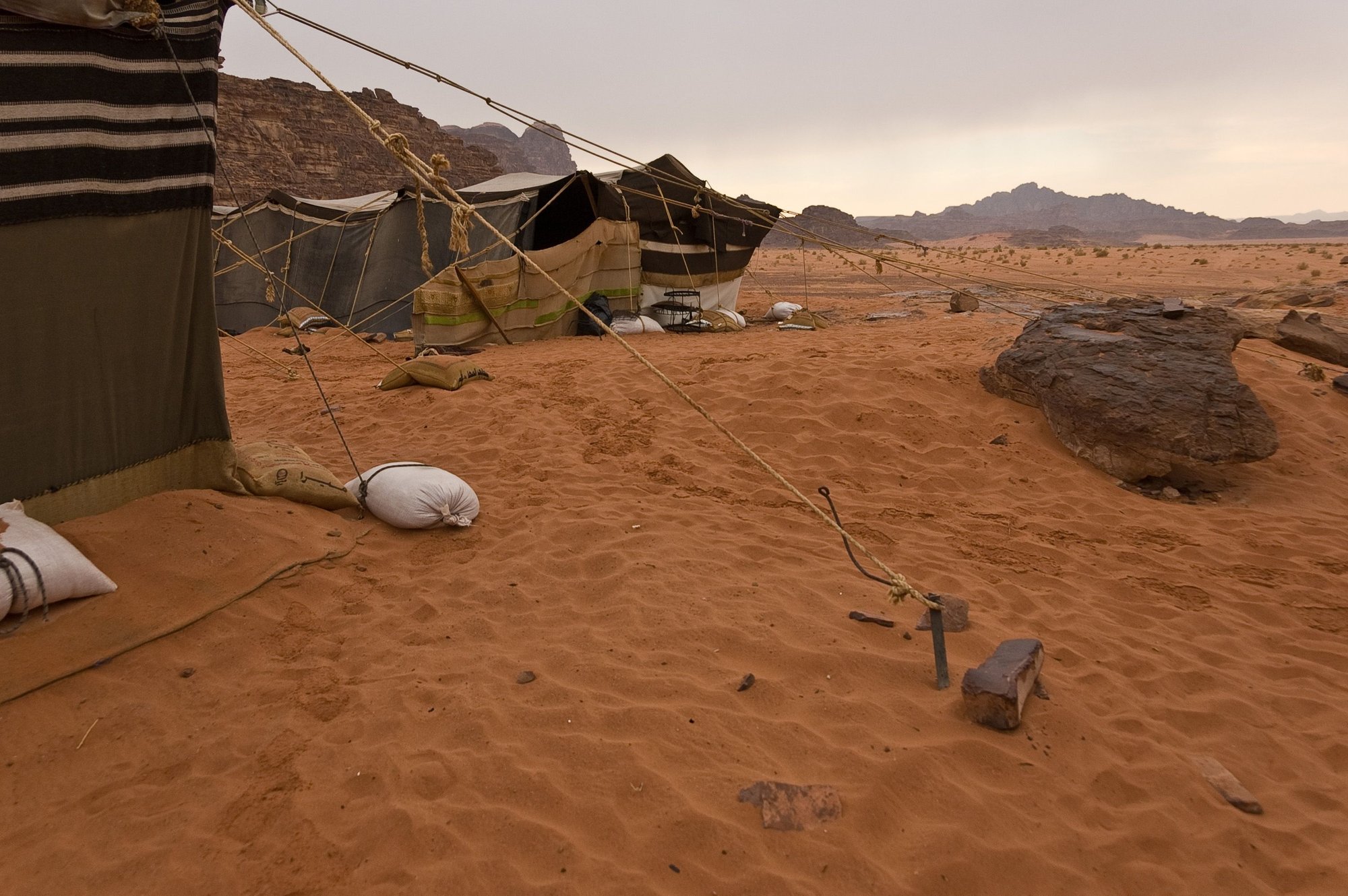
When we arrived there at the site near Wadi Um Ishrin in the Khor al Ajram range, there were a handful of other travelers just leaving. Note how the front guy ropes ('habel') were secured with sandbags. An old British dynamite box was being recycled to weigh down another rope.

We were there around Xmas, so the foliage tended to be extra-dry. Tree types included 'tarta' and 'ghoda'. Acacias bleed a dark-red sap which is put to use. Another tree had pine-style, dill-scented needle leaves. *Credit Mrs Z's superb photo-editing talent for this one, as well as many other shots shown here.

This alien rocky outcrop served as the camp WC plus its generator and storage area. Campers should bring LARGE flashlights. The neck-pencil ones that Mrs Z and I brought were useless during um, wee-hour visits.

Seen here are 'hashim' brushwood, 'samr' kindling and 'arfaj' firewood. All were essential to make fresh tea.
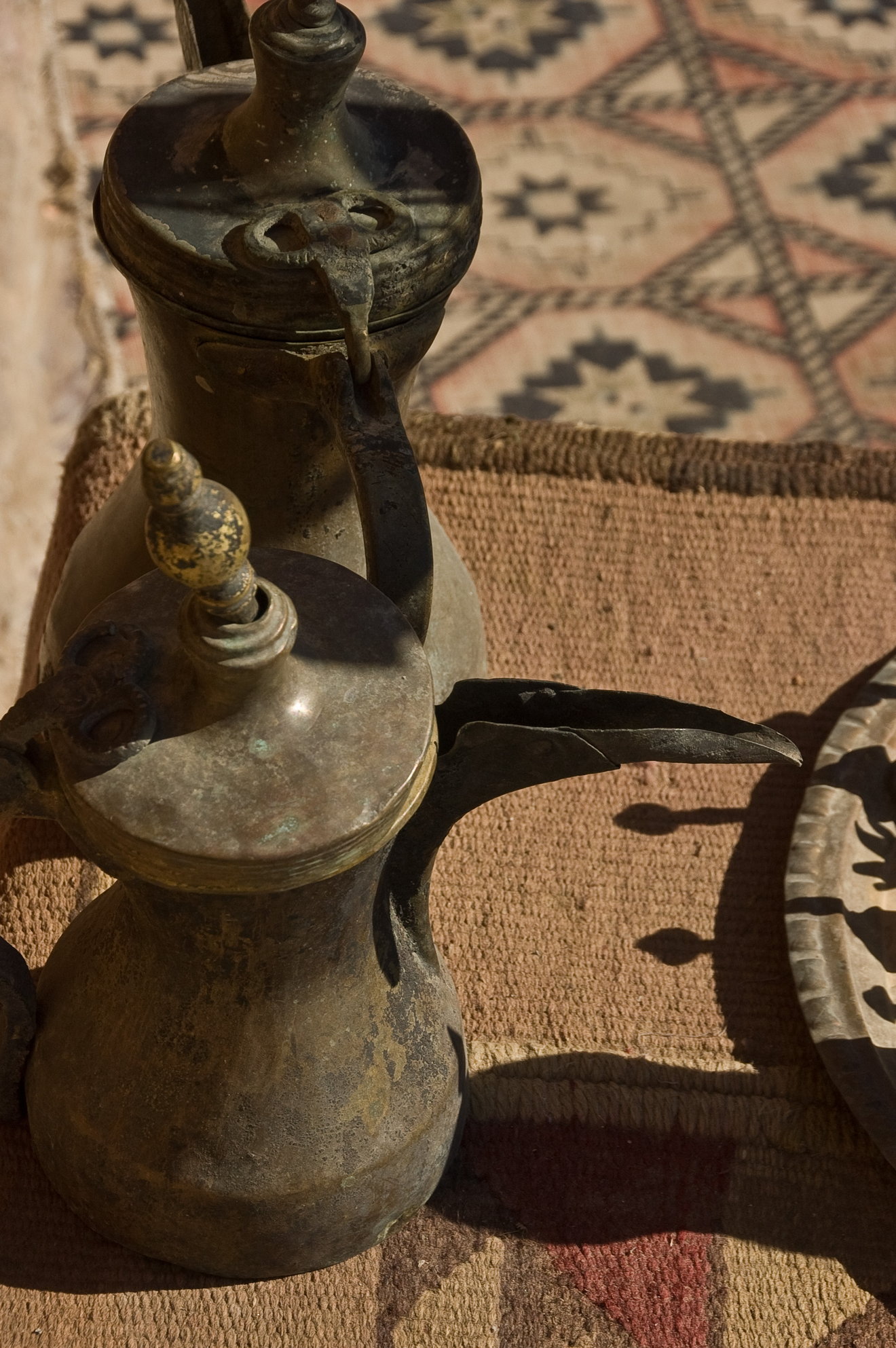
Wild sage ('sheih') is not only made into a 'zaaki' delicious tea, but is also prized for making indigo blue dye. Breakfast ('fatour') by assistant Abdi, also included labanah yogurt with flat pita bread and date syrup. Dinner: 'maglouba'-style chicken. Abdi wore a stylish black Calvin Klein hat. *Nial also presented us with a bottle of fine red local 'St. George wine, similar in taste to that from nearby Bakka valley. He did so 'because otherwise guests will assume that we are not civilized.'
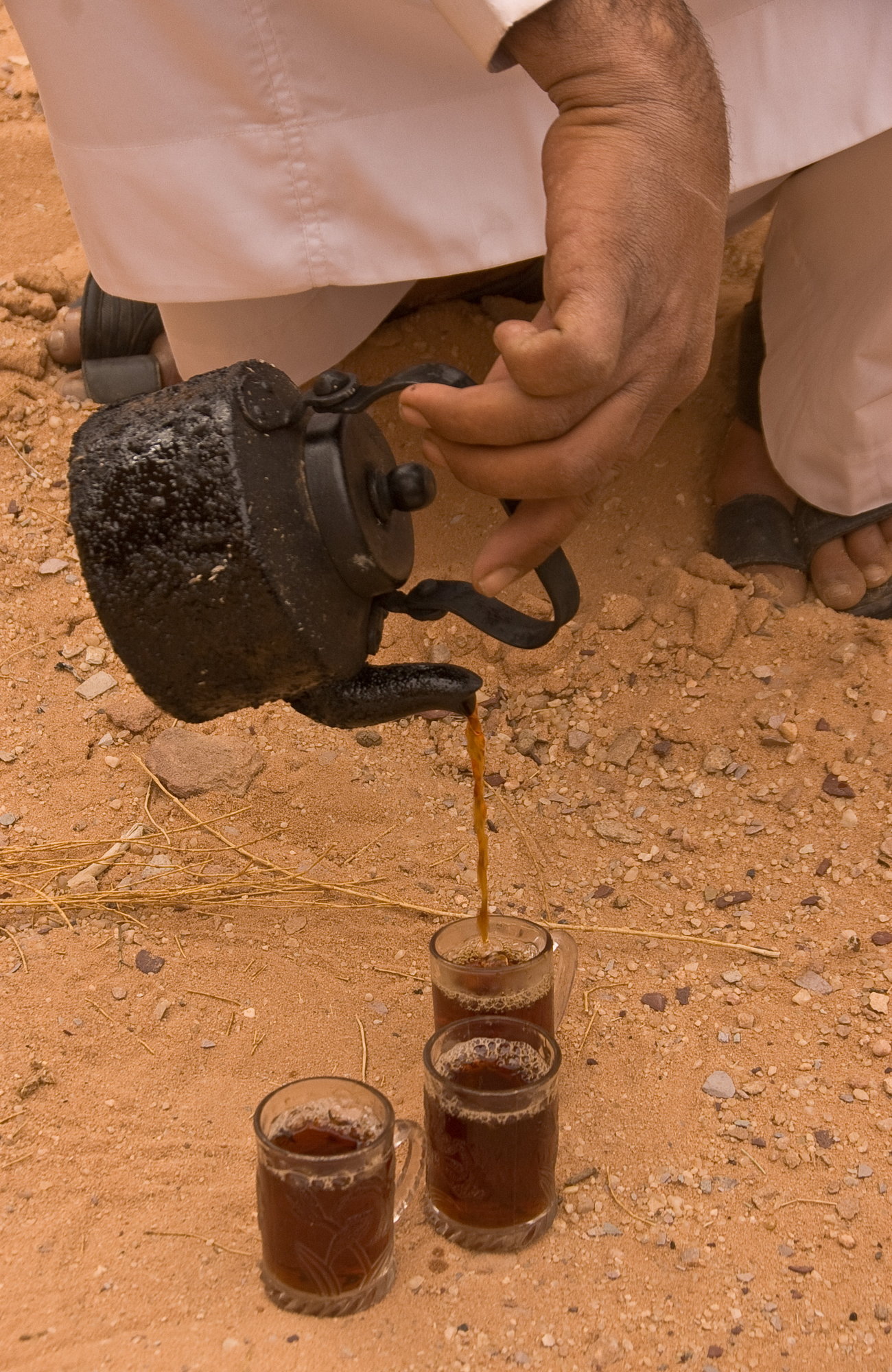
Sting could've had his 'Tea in the Sahara' just as well in Wadi Rum. Our first tea was in Barrah canyon, near Jebel Abu Judayda. These glasses are 'kaseh'. Tip: Maamoul Deemah brand whole wheat date cookies go especially well with tea.

Bark from the sidr-nabk tree was used to make the natural red dye used with the tassel on the right.
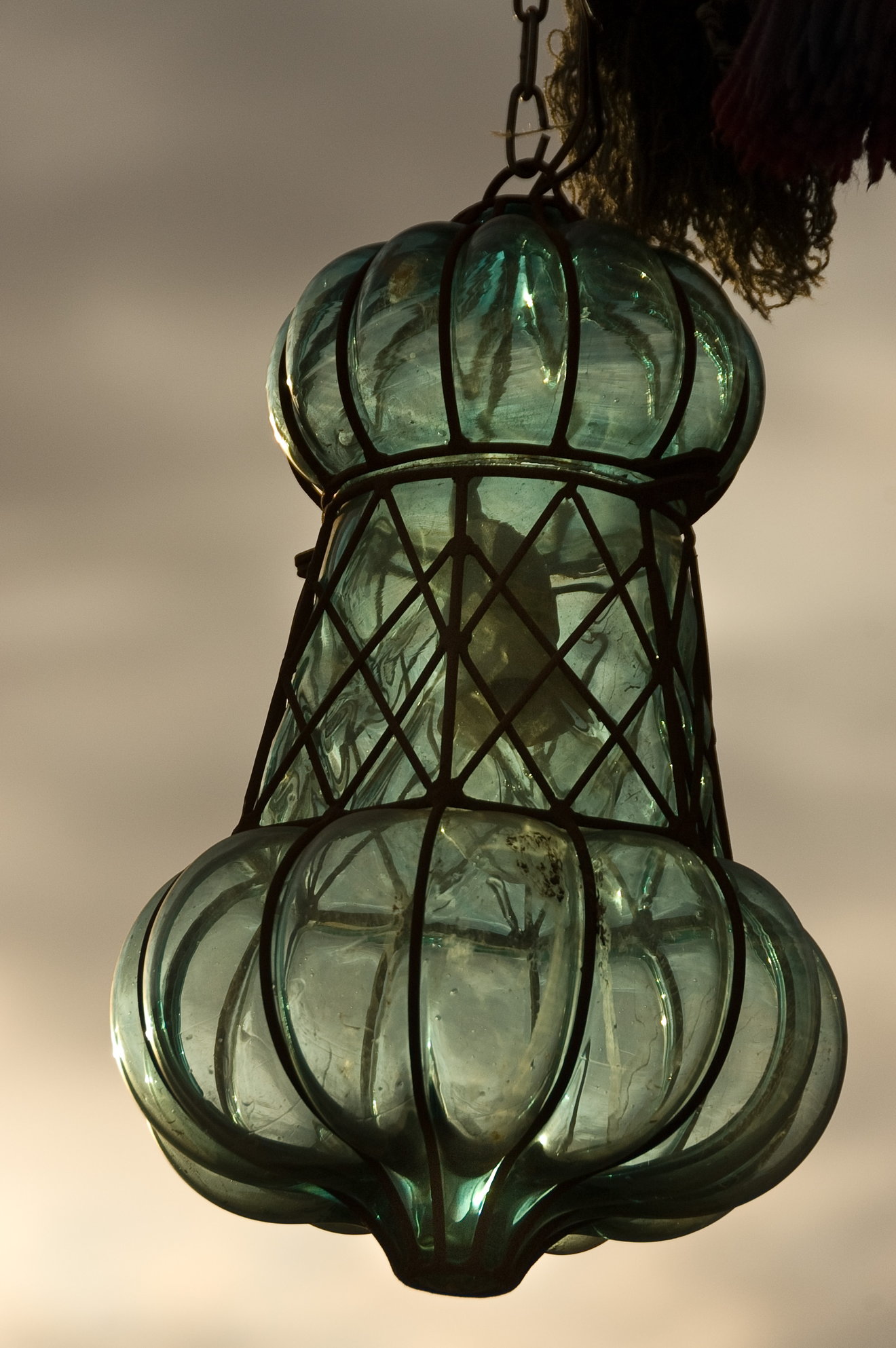
A beautiful lamp made by the Swalhiyeen tribe.

Mrs Z relaxes with Nial, our host Obeid's 19 yr old son (i.e. Awad's nephew). They are in the 'magad' sitting area, by the 'jurad' fireplace. Nial made us promise not to tell his uncle, or Allah Forbid his dad, about his smoking cigarettes. To this day, Jordanian youths will not smoke in front of their elders. Nial's fave place was the port of Aqaba, where everyone his age favors jeans over trad clothing.

Awad wears the traditional long white gown-shirt called a 'thobe'. If worn above his ankles, that'd denote his devoted religiosity. Atop his thobe, he sports a black 'abaya'. His red-white head-cover is an 'amagh', essential for any desert dweller. Some call it instead a 'koufeyah'. The black coil cord surrounding it is known as an 'agal'.
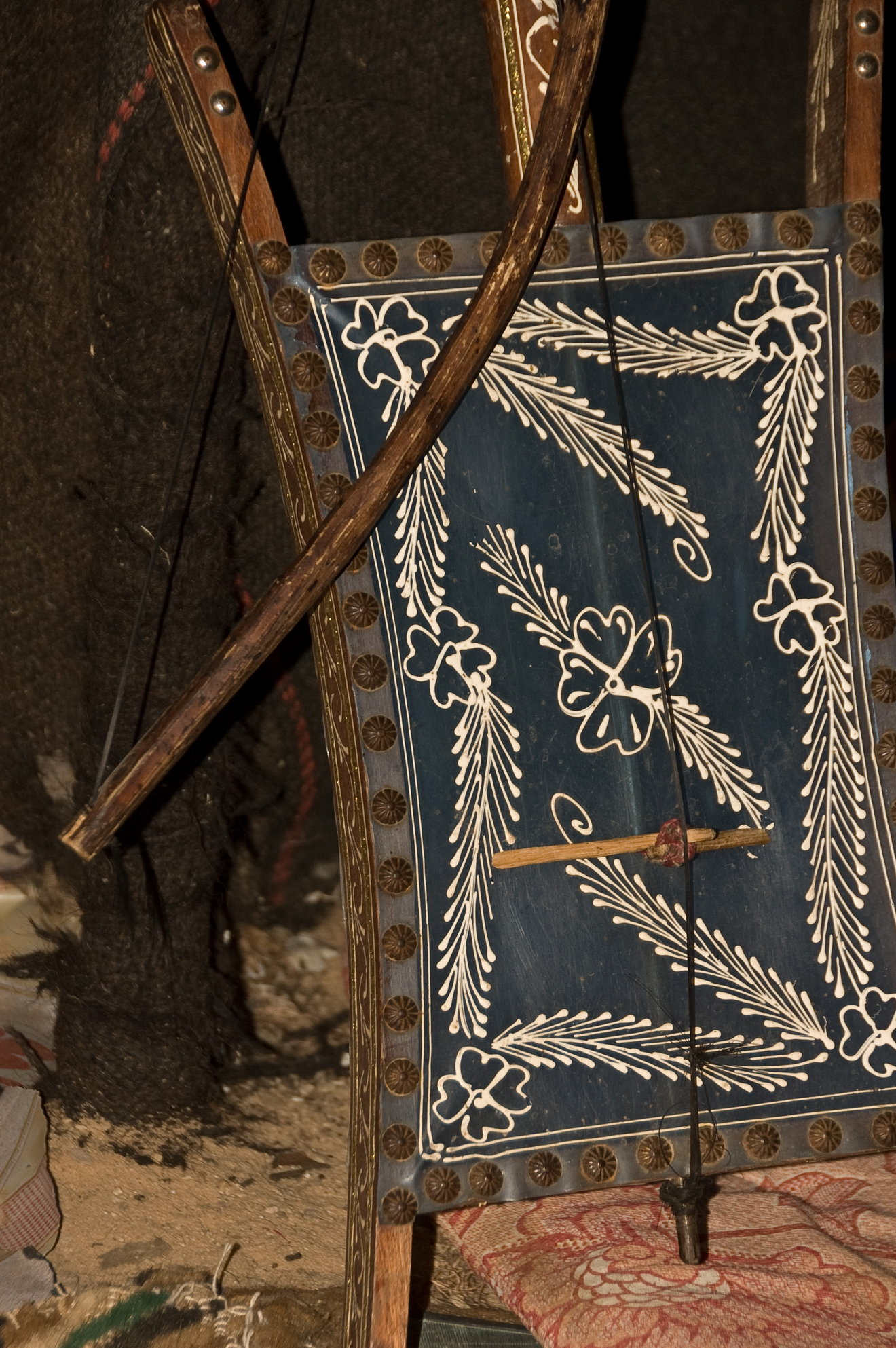
Obeid and Awad's brother invited us over to his own home tent a few kms away, in order to drink 'gahwa' (coffee with coriander) and listen to him play the rababah instrument. It had a quad-shaped soundbox made of goat skin.
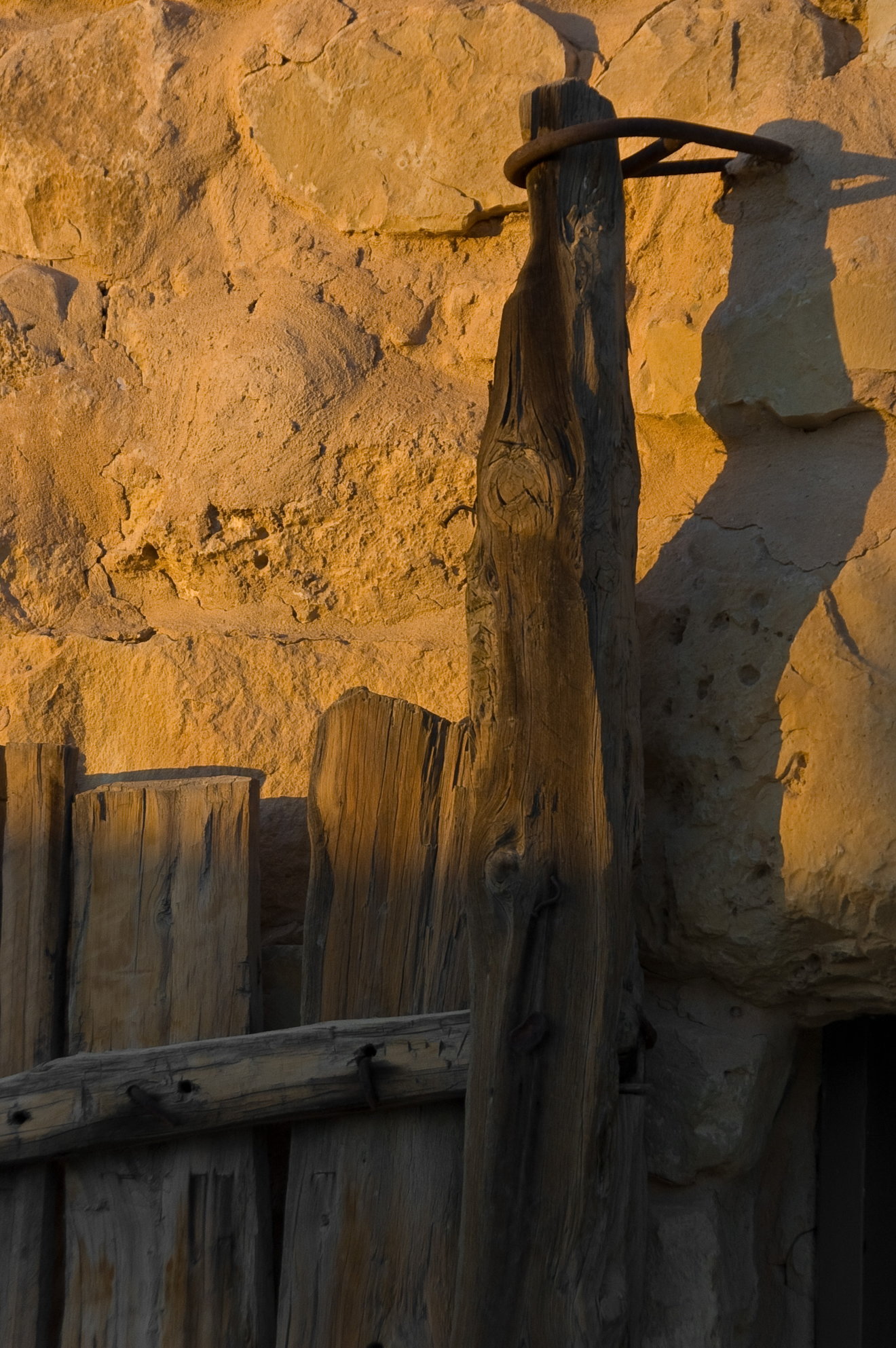
Each home has clearly-designated areas, which often put males and females and livestock in separate sections.
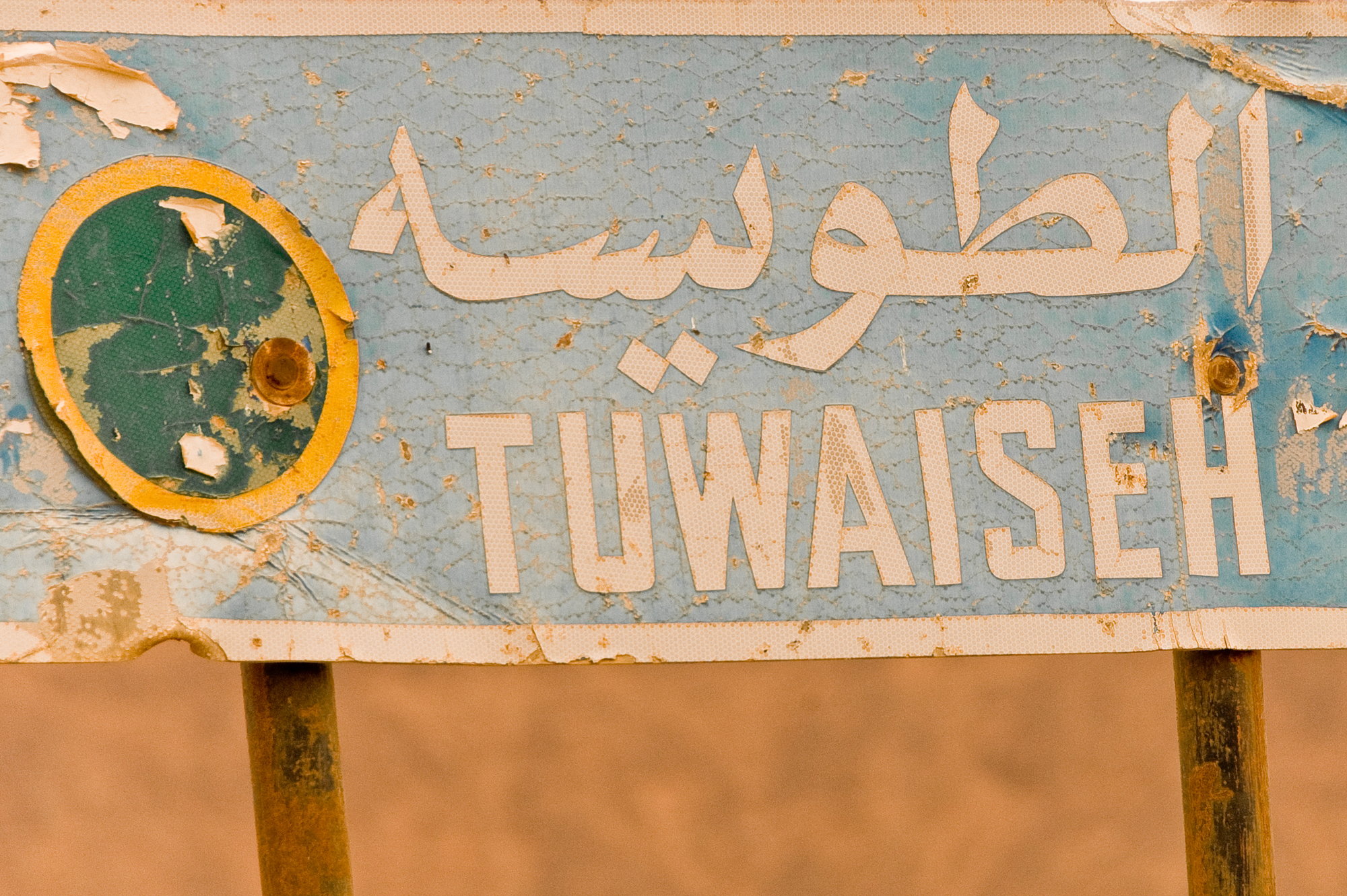
Awad did something kind after hearing about our interest in touring schools. With little warning and less explanation, he raced us over to the nearby all-male King Talal Miltary school (est. 1960). It was located next to the original, pre-war Badia Desert Patrol HQ in Tuwaiseh, a hamlet close to Diseh Village. I was severely underdressed, having assumed that we were bound for another desert drive!
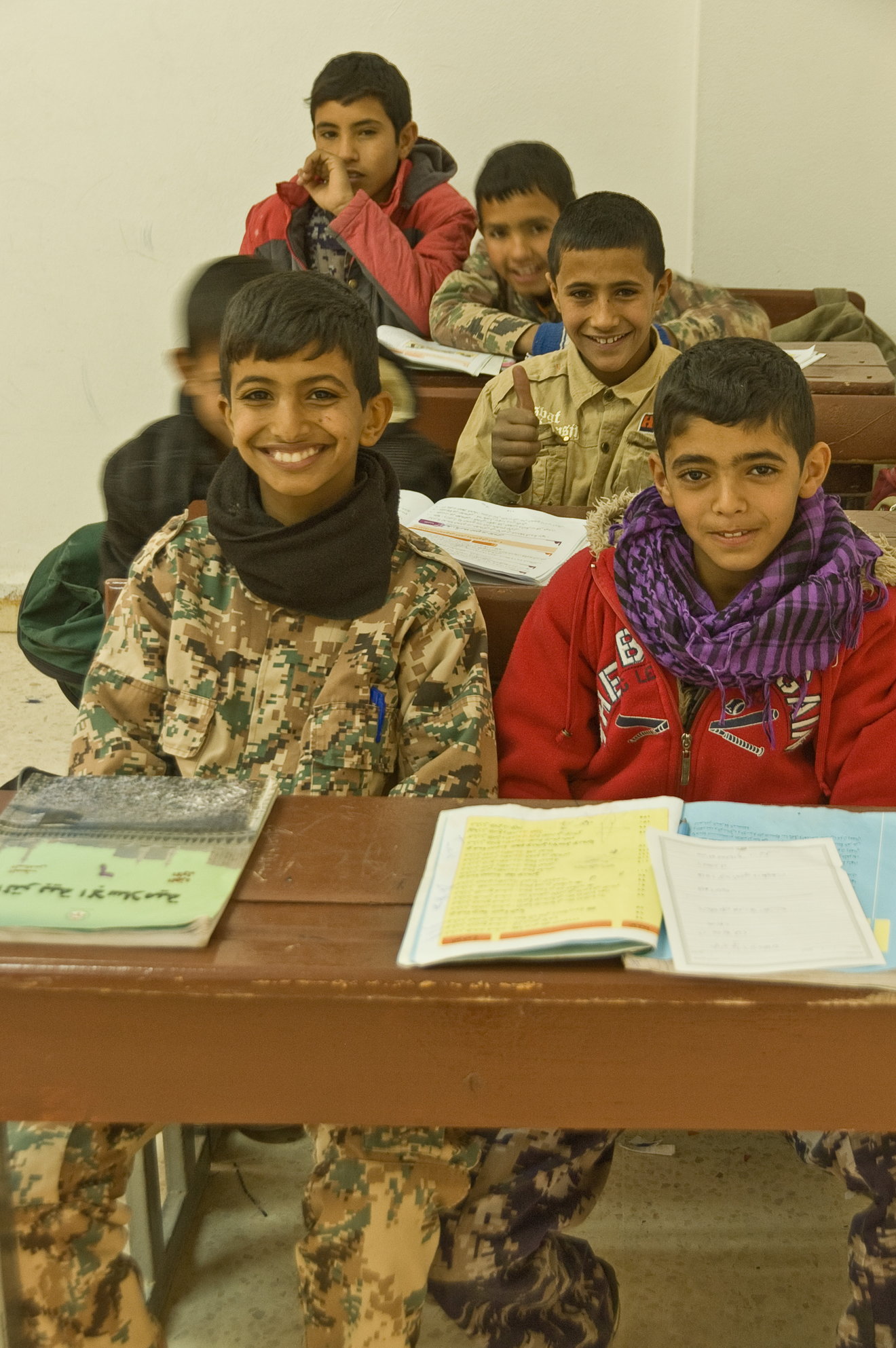
After learning that the students had to tend to the neighbouring tomato field, I told the boys that I'd been born on a tomato farm. Mrs Z noticed that some of the youngest kids had been rewarded for correct answers by having gold stars affixed to their foreheads! We were gifted 2 books: one by Queen Noor and also a history of Jerusalem. In return, I bookmarked 7 of the most fun educational game websites from my own class, in their Computer Lab.
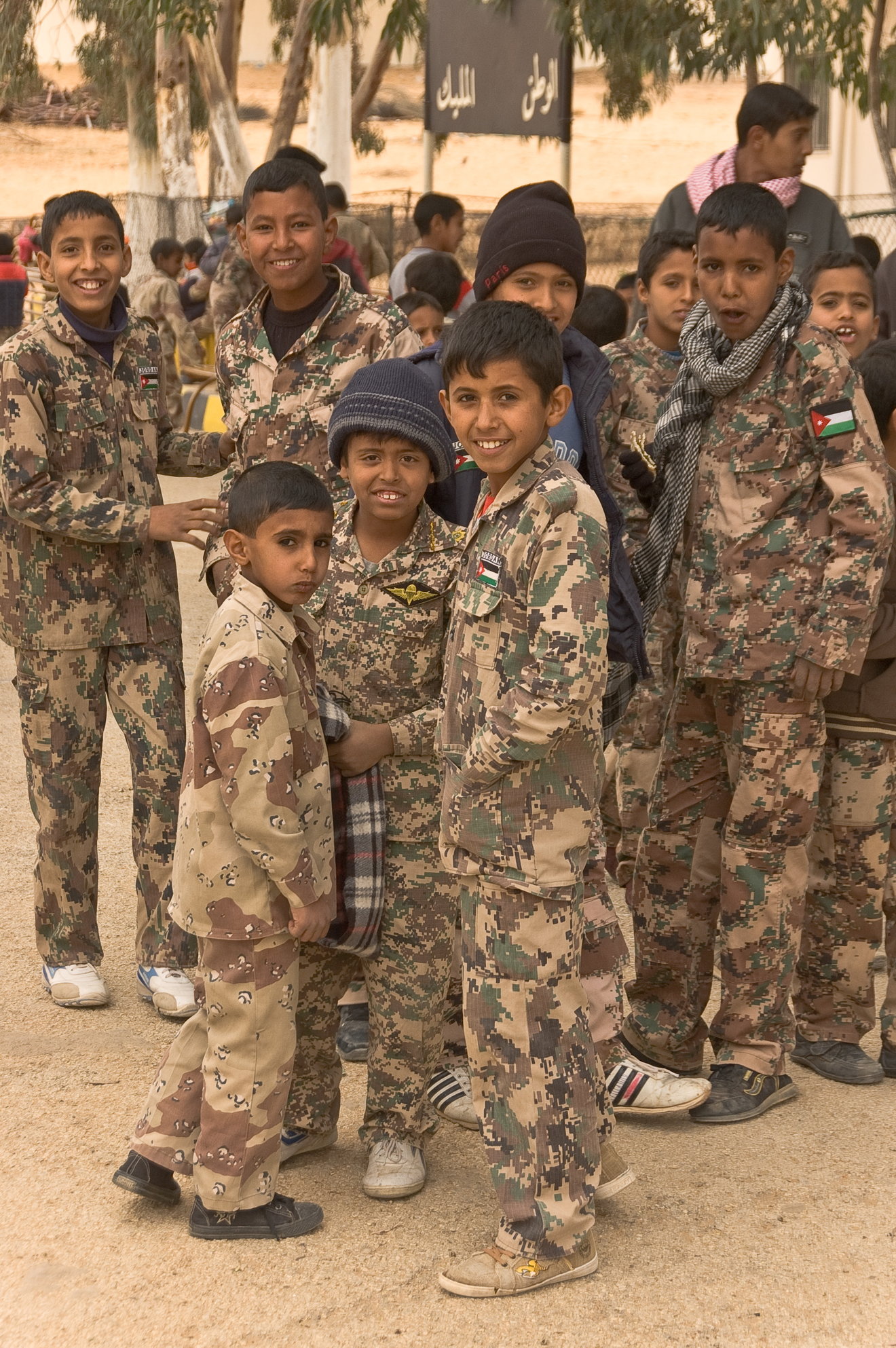
The commencement of Recess was signaled by some of the loudest and most jarring Arab pop ever recorded, blaring through the school's PA horns. These students would eventually grow to join the army with its 100,000 members or the 34,000 reservists.
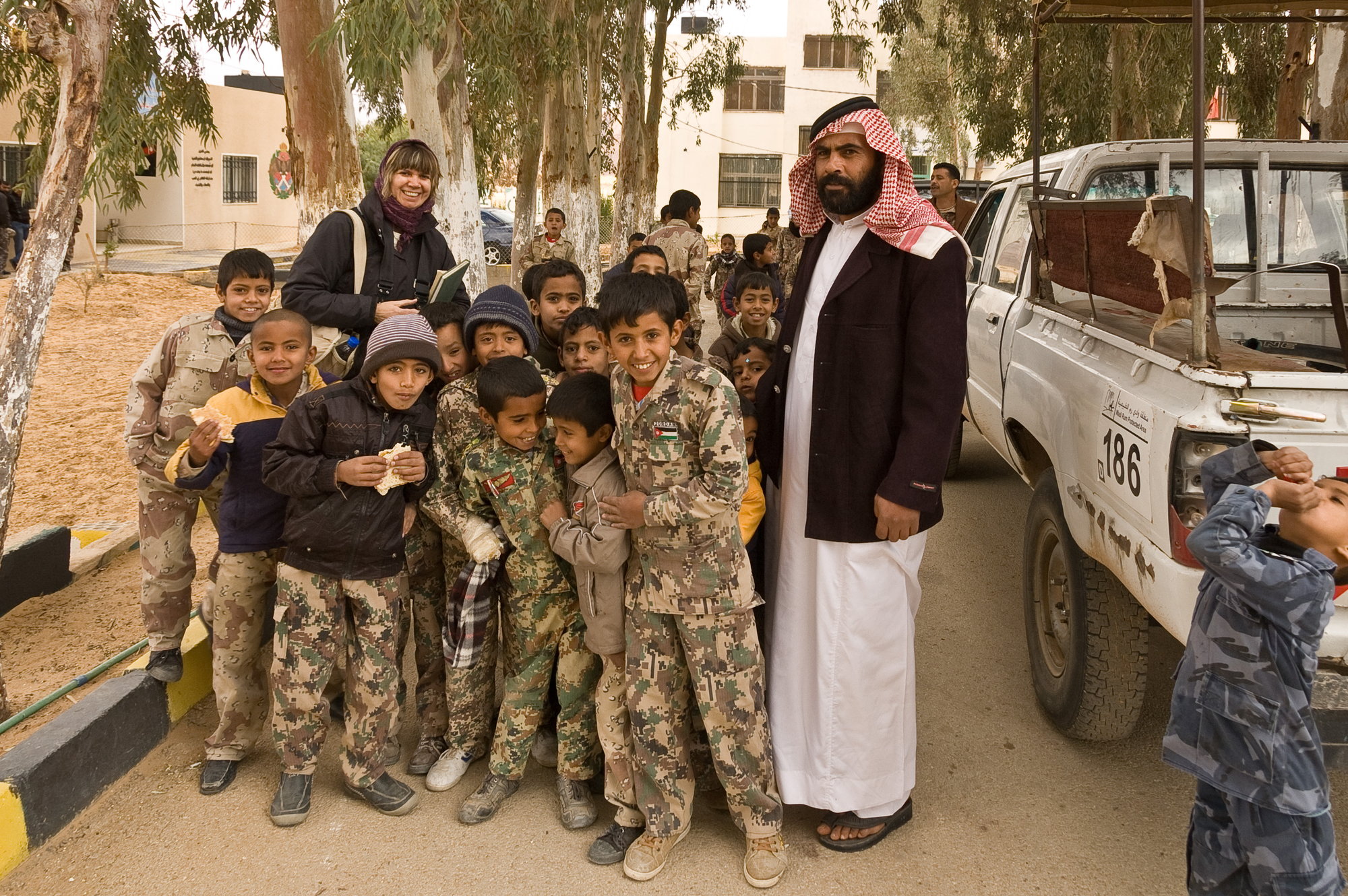
At first we were intimidated by the serious demeanor of Headmaster-Principal Major Maher Qabasi (not shown), but we eventually warmed to each other. Two things resulted. First, he arranged for his teacher wife's class in Aqaba to join the International Pen Pal club that I ran in all of my Toronto schools. He then sought our assistance in his new pet project as a tech inventor. His latest gadget was an ingenious wristwatch device designed to alert hearing-and-visually-impaired folks about fire.
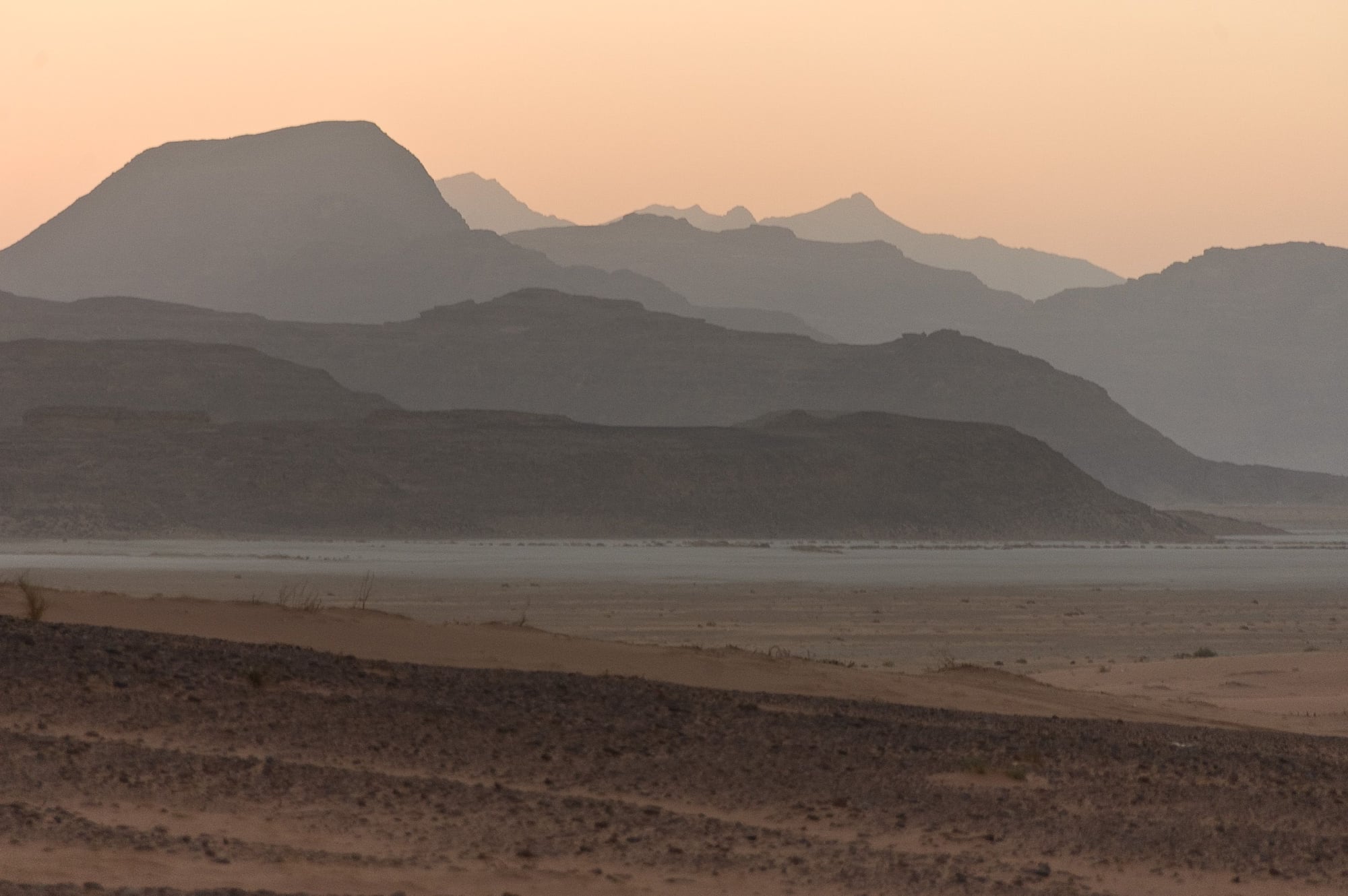
Parallels. **Btw, we did as promised for Major Qabasi. We thereafter took his invention project-idea to the CNIB (Canadian National Institute for the Blind) in Toronto, a place well-known to Fodorite and volunteer GoddessToGo! Unfortunately, they were not as interested in the new technology as we'd all hoped.

En route to Jebel Makra.
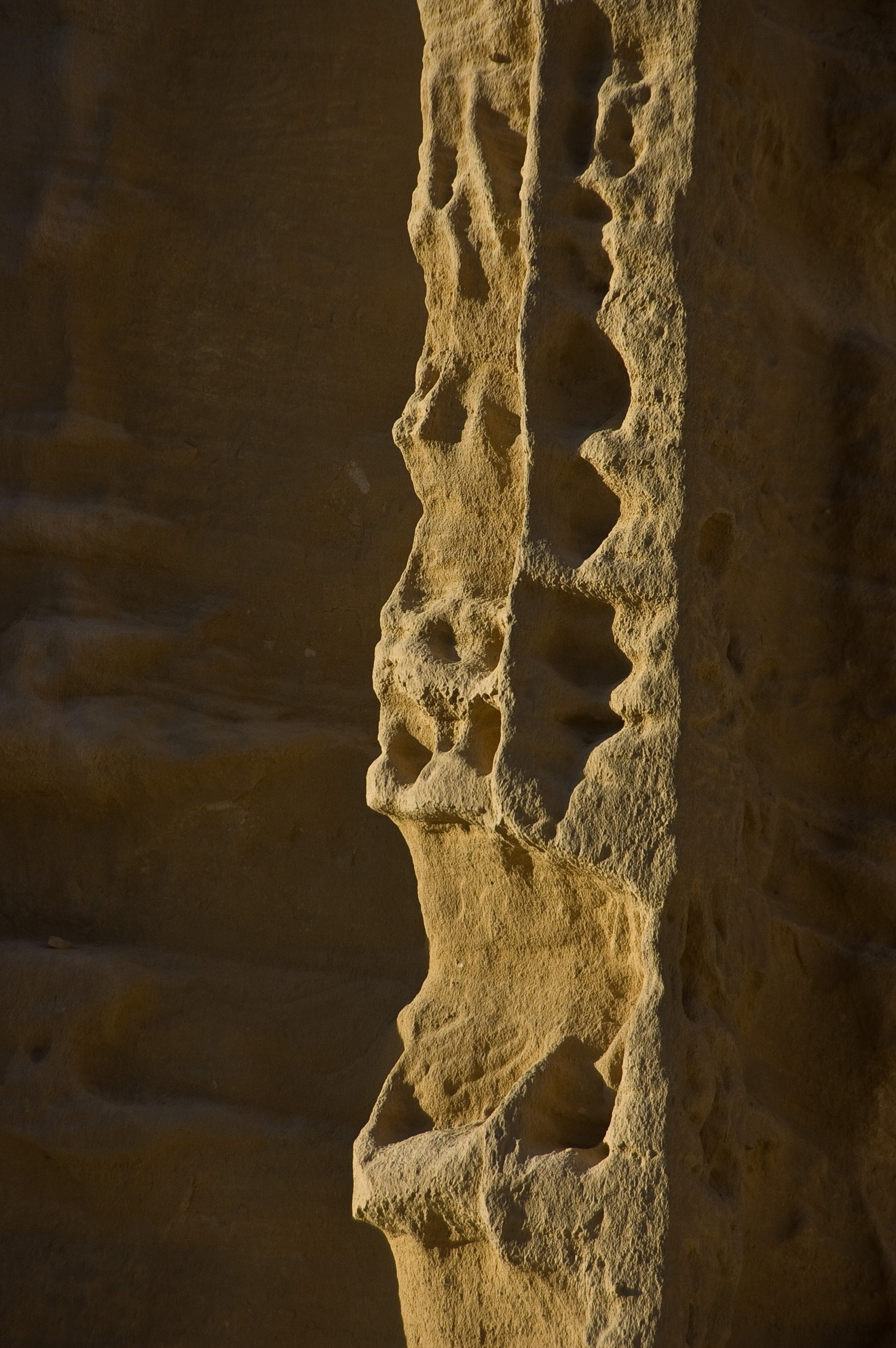
Khazareh Canyon, with its steep and narrow fissures, is one popular hiking area.

Muhamad of the Zalabia tribe, which is based in Rum village, a fairly recent creation.

Neat the red dunes of Al-Hasany Ramal and Jebel Faishiyya.

Close by Jebel Qabar Amra and Wadi al Bghidha.
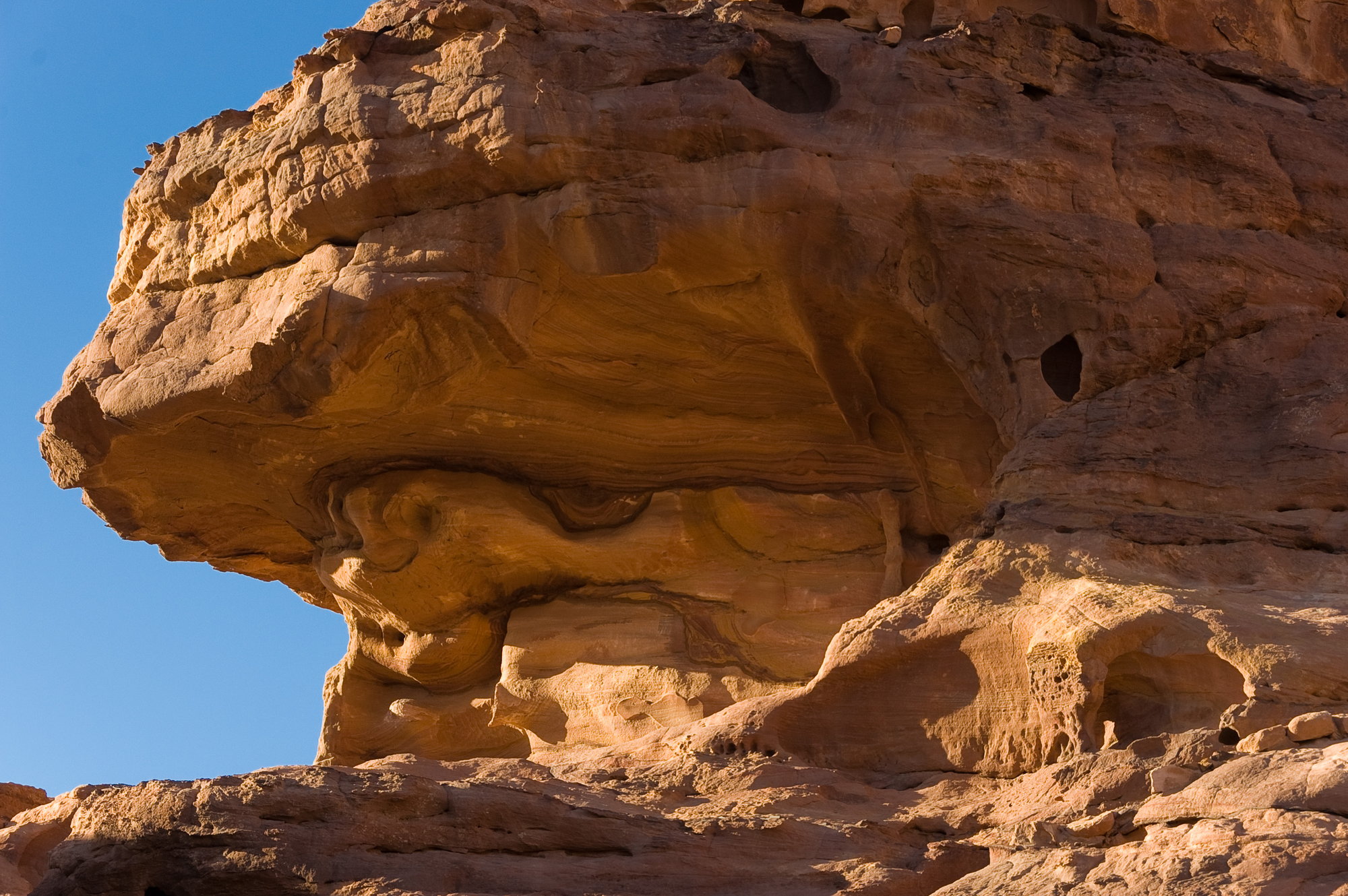
Jebel Umm E'jil.

Tafoni.
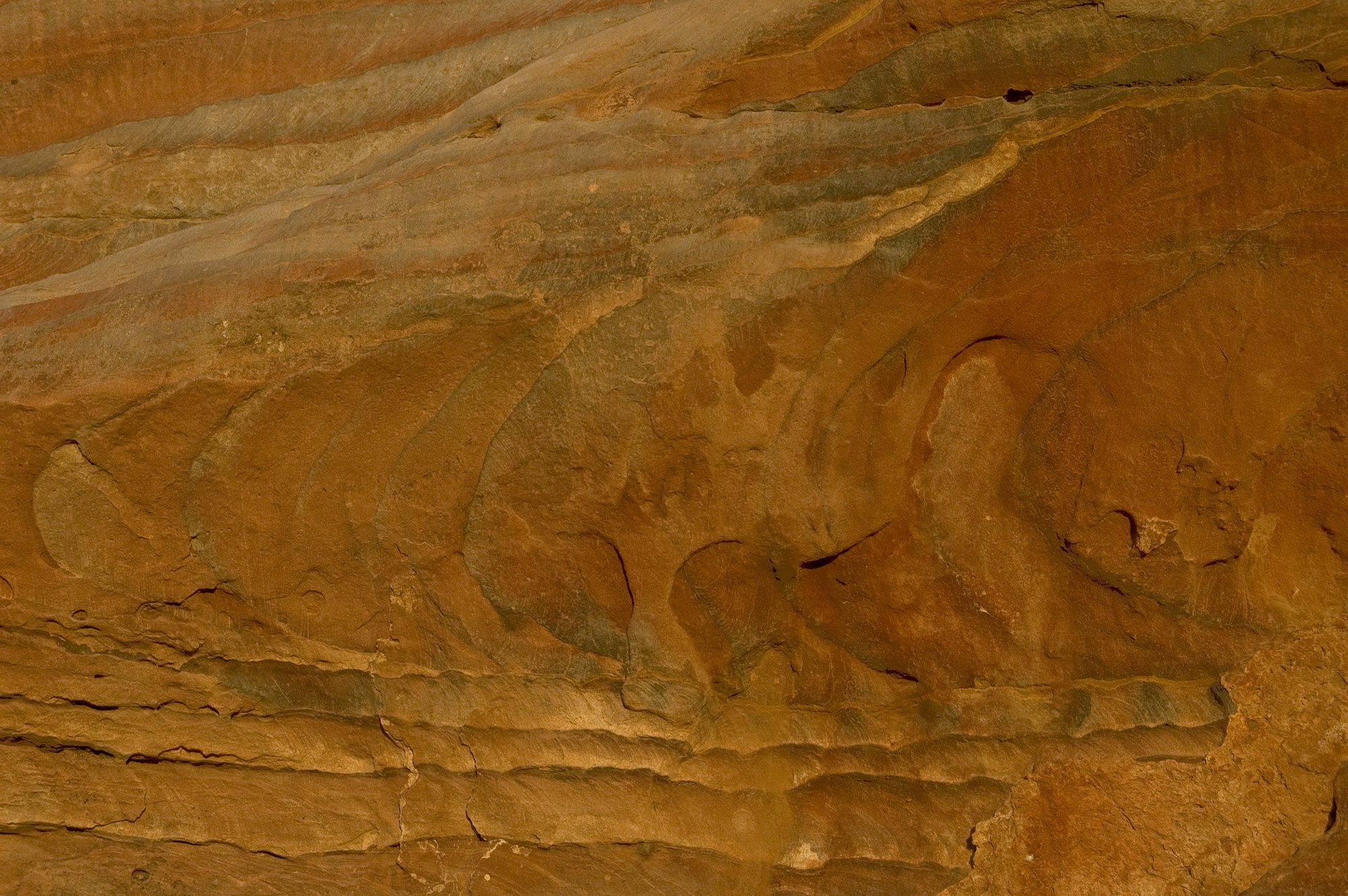
Rich pigments during the golden hour.
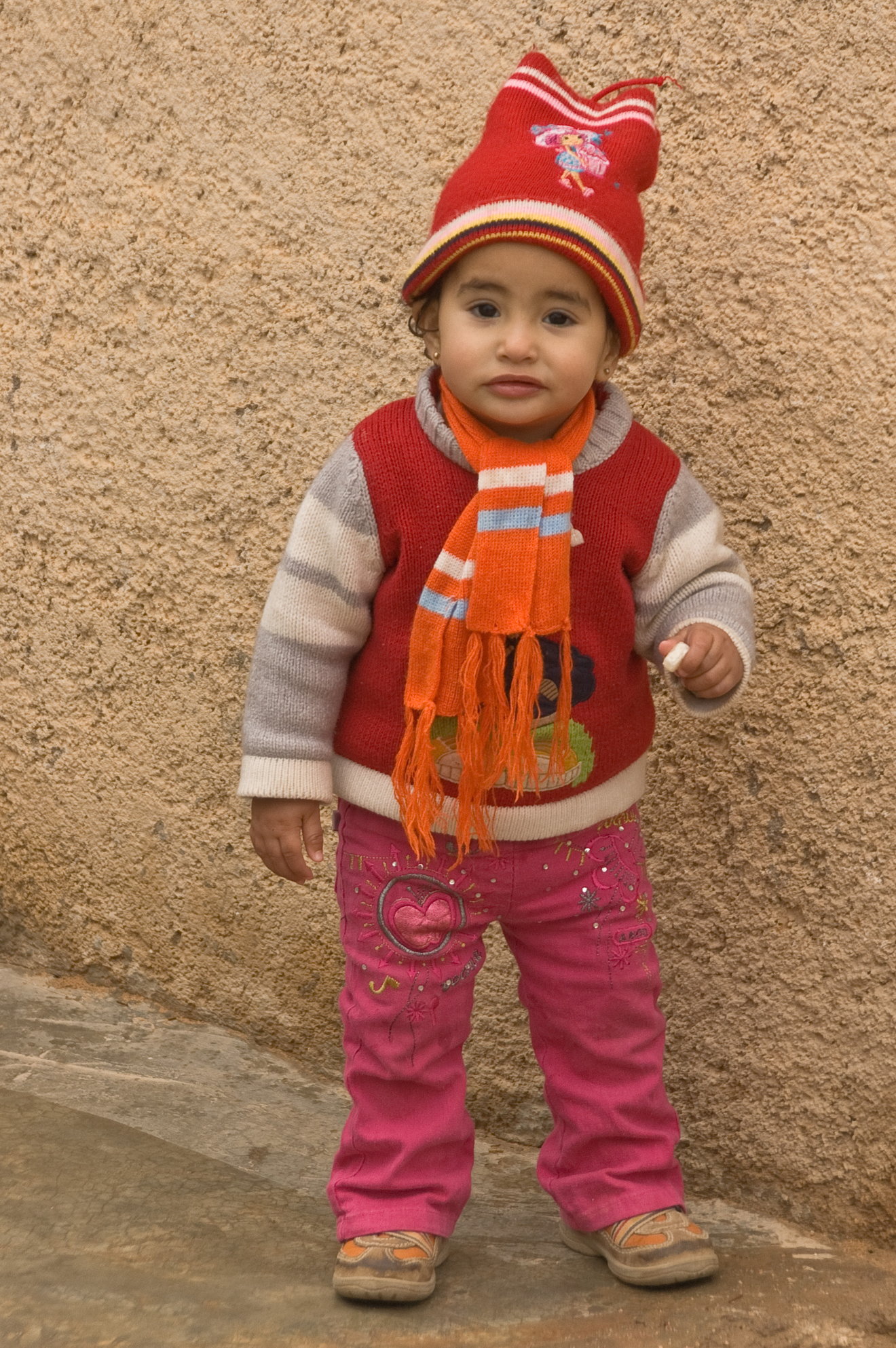
Awad's youngest, habibti Siham.
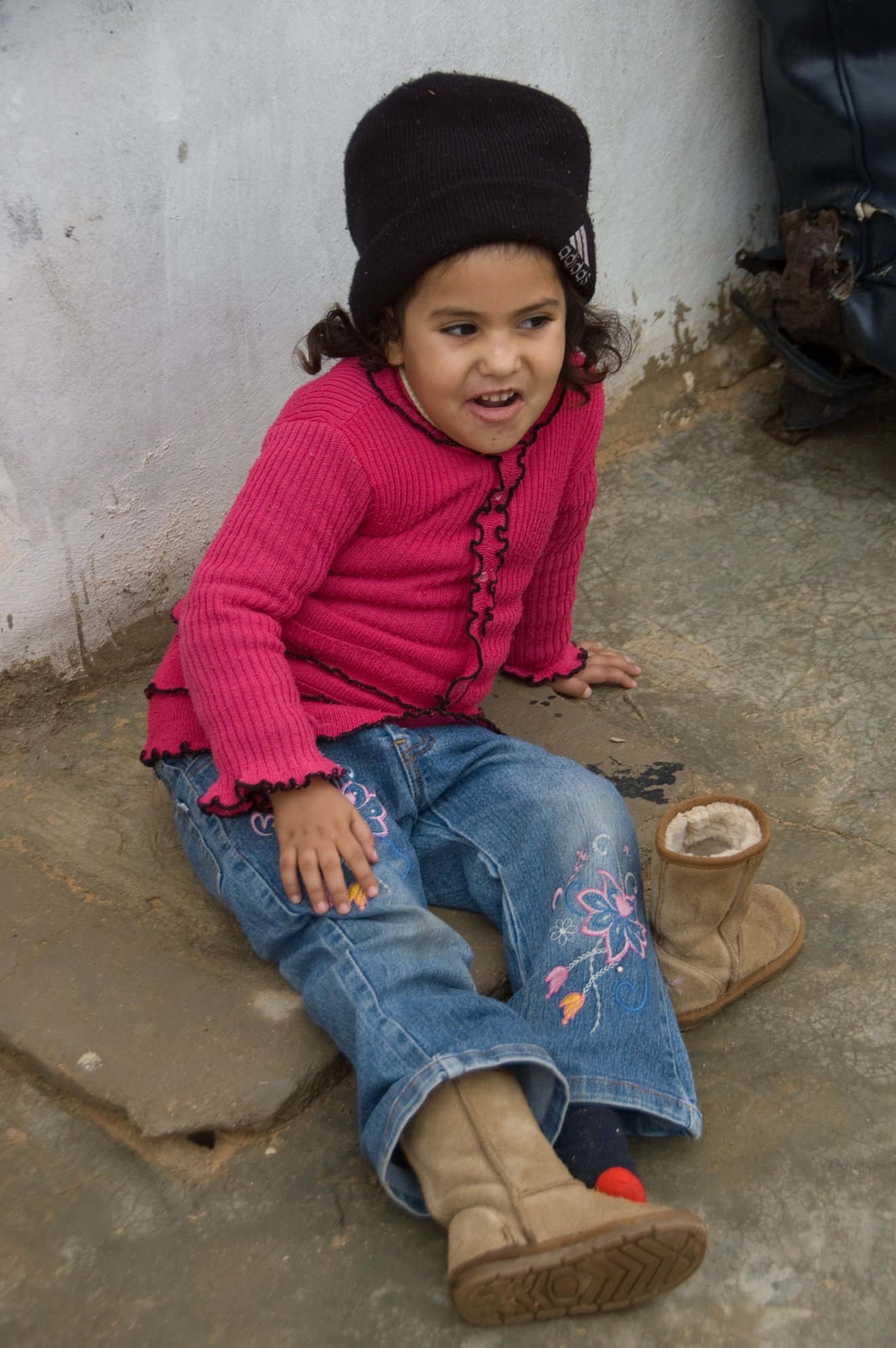
Siham's sister Hallah, with whom we drew camels.
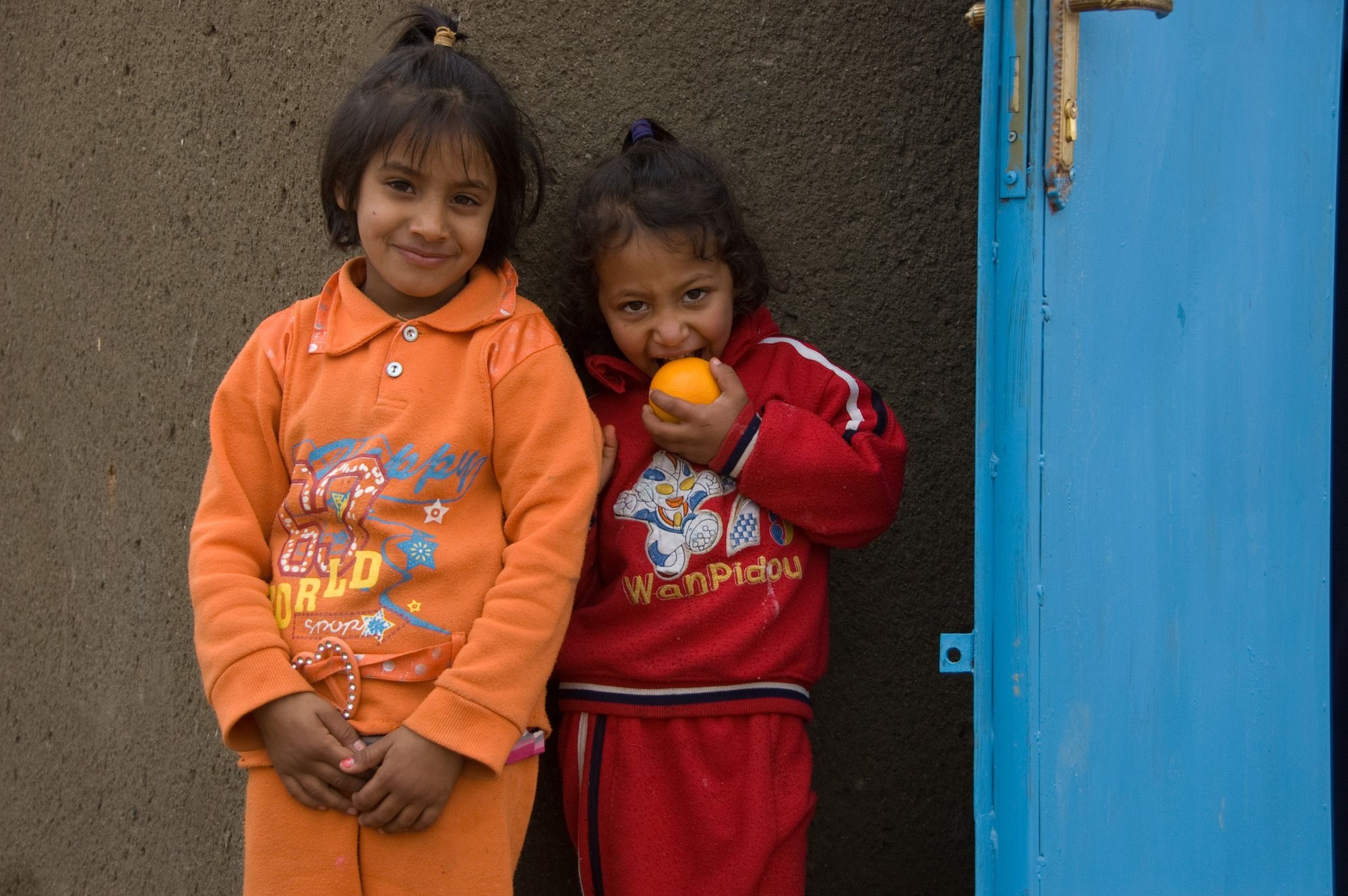
A pair of local citrus inspectors.

Jebel Burdah canyon is massive. Our echoing shouts carried into the misty distance.

Brooding weather and towering mountains form a Wadi Rum scene. *TIME FOR MORE DESERT MUSIC!
So now we change the channel to Wadi Rum. Such stunning landscape. Now that the pandemic seems to be waning, there will be plenty of new willing prisoners there, deep in the desert. A timeless Zen atmosphere is evident. Few places in Jordan demand as much exploration as this protected area of unspoiled natural beauty. Locals call it 'harra' or rocky desert. Vast cliffs and canyons, epic vistas plus dramatically-bulging rock formations are spread throughout these desert plains bordering Saudi Arabia. It can be hard to believe that all this is natural landscape and not some brooding geography of alien origin. As in Petra, unique tafoni can be found, born of an ancient seabed which once carved the elements into otherworldly honeycomb. Visitors will salute Mother Nature and her consort Time ('jawan'), for creating such unique, differentially-weathered wonders. Wadi Rum's secluded sites are reached by 4WD jeeps and pickups, horses, camels and also by bus #11 (get it? stick legs). Hikers enjoy this place. Enough already--I'm beginning to sound like a travel brochure. Let's return to fotos.

Those interested in going horseback might contact Sue at her 'Bait Ali Camp' in nearby Shakharia--she is an expert rider.

Shutterbugs are advised to place their cameras inside a good quality bag or container here. A single grain of sand can mess up your desert trek adventure.

On our first day in Wadi Rum, we helped to tow out an elderly couple whose vehicle had got stuck in the sand back during 'saabah' or sunrise. They'd been there for hours. They were a thankful but superstitious pair, from an age when hot-iron branding and drinking wildcat blood were norms. As recently as '98, Wadi Rum saw an honor killing-stabbing.

Picturesque bridge-arches are cliche images in Wadi Rum. Pictured here is the natural Jebel Kharaz (translation: 'full memory card'), found along the stony Sabah route.

From inside the same spot, we see Abu al-Fodor in the distance. Other such arches include Um Fruth.

There are no Petra-esque elaborate tombs recalling the Nabatean past in Wadi Rum, but the rockscapes more than make up for that. Off-road jeep tours are a great way to enjoy Wadi Rum plus its equally-impressive outskirts. Note that locals tend to buy their vehicles across in Saudi Arabia, due to punitive local taxes. Toyotas are popular.

One such example. My wife enjoyed painting some watercolor abstracts, with the irony that abstract shapes had been provided all around her!

For our nights camping under the stars, we'd booked with ex-policeman Obeid Naser Al-Amareh. We'd done so because his Azzabi Bedouin Life camp had excellent reviews. Obeid was of the Zuweydeh tribe, which is based in Diseh village. Unfortunately he was in Amman with a sick relative, so he left his ruggedly handsome brother Awad (shown here) in charge of the tent. He was assisted by Obeid's 19 yr old son Nial. Awad explained that he was fond of 'vitamin C'=ciggies.

Some blankets next to the 'amoud' support pole. The six poles throughout the tent each had different names. As evening ('masa') approached, propane heaters allayed our concerns about the desert winter cold. My wife brought out her precious stargazing charts.

When we arrived there at the site near Wadi Um Ishrin in the Khor al Ajram range, there were a handful of other travelers just leaving. Note how the front guy ropes ('habel') were secured with sandbags. An old British dynamite box was being recycled to weigh down another rope.

We were there around Xmas, so the foliage tended to be extra-dry. Tree types included 'tarta' and 'ghoda'. Acacias bleed a dark-red sap which is put to use. Another tree had pine-style, dill-scented needle leaves. *Credit Mrs Z's superb photo-editing talent for this one, as well as many other shots shown here.

This alien rocky outcrop served as the camp WC plus its generator and storage area. Campers should bring LARGE flashlights. The neck-pencil ones that Mrs Z and I brought were useless during um, wee-hour visits.

Seen here are 'hashim' brushwood, 'samr' kindling and 'arfaj' firewood. All were essential to make fresh tea.

Wild sage ('sheih') is not only made into a 'zaaki' delicious tea, but is also prized for making indigo blue dye. Breakfast ('fatour') by assistant Abdi, also included labanah yogurt with flat pita bread and date syrup. Dinner: 'maglouba'-style chicken. Abdi wore a stylish black Calvin Klein hat. *Nial also presented us with a bottle of fine red local 'St. George wine, similar in taste to that from nearby Bakka valley. He did so 'because otherwise guests will assume that we are not civilized.'

Sting could've had his 'Tea in the Sahara' just as well in Wadi Rum. Our first tea was in Barrah canyon, near Jebel Abu Judayda. These glasses are 'kaseh'. Tip: Maamoul Deemah brand whole wheat date cookies go especially well with tea.

Bark from the sidr-nabk tree was used to make the natural red dye used with the tassel on the right.

A beautiful lamp made by the Swalhiyeen tribe.

Mrs Z relaxes with Nial, our host Obeid's 19 yr old son (i.e. Awad's nephew). They are in the 'magad' sitting area, by the 'jurad' fireplace. Nial made us promise not to tell his uncle, or Allah Forbid his dad, about his smoking cigarettes. To this day, Jordanian youths will not smoke in front of their elders. Nial's fave place was the port of Aqaba, where everyone his age favors jeans over trad clothing.

Awad wears the traditional long white gown-shirt called a 'thobe'. If worn above his ankles, that'd denote his devoted religiosity. Atop his thobe, he sports a black 'abaya'. His red-white head-cover is an 'amagh', essential for any desert dweller. Some call it instead a 'koufeyah'. The black coil cord surrounding it is known as an 'agal'.

Obeid and Awad's brother invited us over to his own home tent a few kms away, in order to drink 'gahwa' (coffee with coriander) and listen to him play the rababah instrument. It had a quad-shaped soundbox made of goat skin.

Each home has clearly-designated areas, which often put males and females and livestock in separate sections.

Awad did something kind after hearing about our interest in touring schools. With little warning and less explanation, he raced us over to the nearby all-male King Talal Miltary school (est. 1960). It was located next to the original, pre-war Badia Desert Patrol HQ in Tuwaiseh, a hamlet close to Diseh Village. I was severely underdressed, having assumed that we were bound for another desert drive!

After learning that the students had to tend to the neighbouring tomato field, I told the boys that I'd been born on a tomato farm. Mrs Z noticed that some of the youngest kids had been rewarded for correct answers by having gold stars affixed to their foreheads! We were gifted 2 books: one by Queen Noor and also a history of Jerusalem. In return, I bookmarked 7 of the most fun educational game websites from my own class, in their Computer Lab.

The commencement of Recess was signaled by some of the loudest and most jarring Arab pop ever recorded, blaring through the school's PA horns. These students would eventually grow to join the army with its 100,000 members or the 34,000 reservists.

At first we were intimidated by the serious demeanor of Headmaster-Principal Major Maher Qabasi (not shown), but we eventually warmed to each other. Two things resulted. First, he arranged for his teacher wife's class in Aqaba to join the International Pen Pal club that I ran in all of my Toronto schools. He then sought our assistance in his new pet project as a tech inventor. His latest gadget was an ingenious wristwatch device designed to alert hearing-and-visually-impaired folks about fire.

Parallels. **Btw, we did as promised for Major Qabasi. We thereafter took his invention project-idea to the CNIB (Canadian National Institute for the Blind) in Toronto, a place well-known to Fodorite and volunteer GoddessToGo! Unfortunately, they were not as interested in the new technology as we'd all hoped.

En route to Jebel Makra.

Khazareh Canyon, with its steep and narrow fissures, is one popular hiking area.

Muhamad of the Zalabia tribe, which is based in Rum village, a fairly recent creation.

Neat the red dunes of Al-Hasany Ramal and Jebel Faishiyya.

Close by Jebel Qabar Amra and Wadi al Bghidha.

Jebel Umm E'jil.

Tafoni.

Rich pigments during the golden hour.

Awad's youngest, habibti Siham.

Siham's sister Hallah, with whom we drew camels.

A pair of local citrus inspectors.

Jebel Burdah canyon is massive. Our echoing shouts carried into the misty distance.

Brooding weather and towering mountains form a Wadi Rum scene. *TIME FOR MORE DESERT MUSIC!
Last edited by zebec; Mar 22nd, 2022 at 09:36 PM. Reason: yallah yallah yallah
#17
Original Poster
Join Date: Jan 2008
Posts: 7,514
Likes: 0
Received 0 Likes
on
0 Posts
Our loud local trio, The Tea Party, doing a song which evokes that part of the world: The Bazaar. *The next number below this is an acoustic version of the same song, an attempt to convey a related feel.
#19
Original Poster
Join Date: Jan 2008
Posts: 7,514
Likes: 0
Received 0 Likes
on
0 Posts
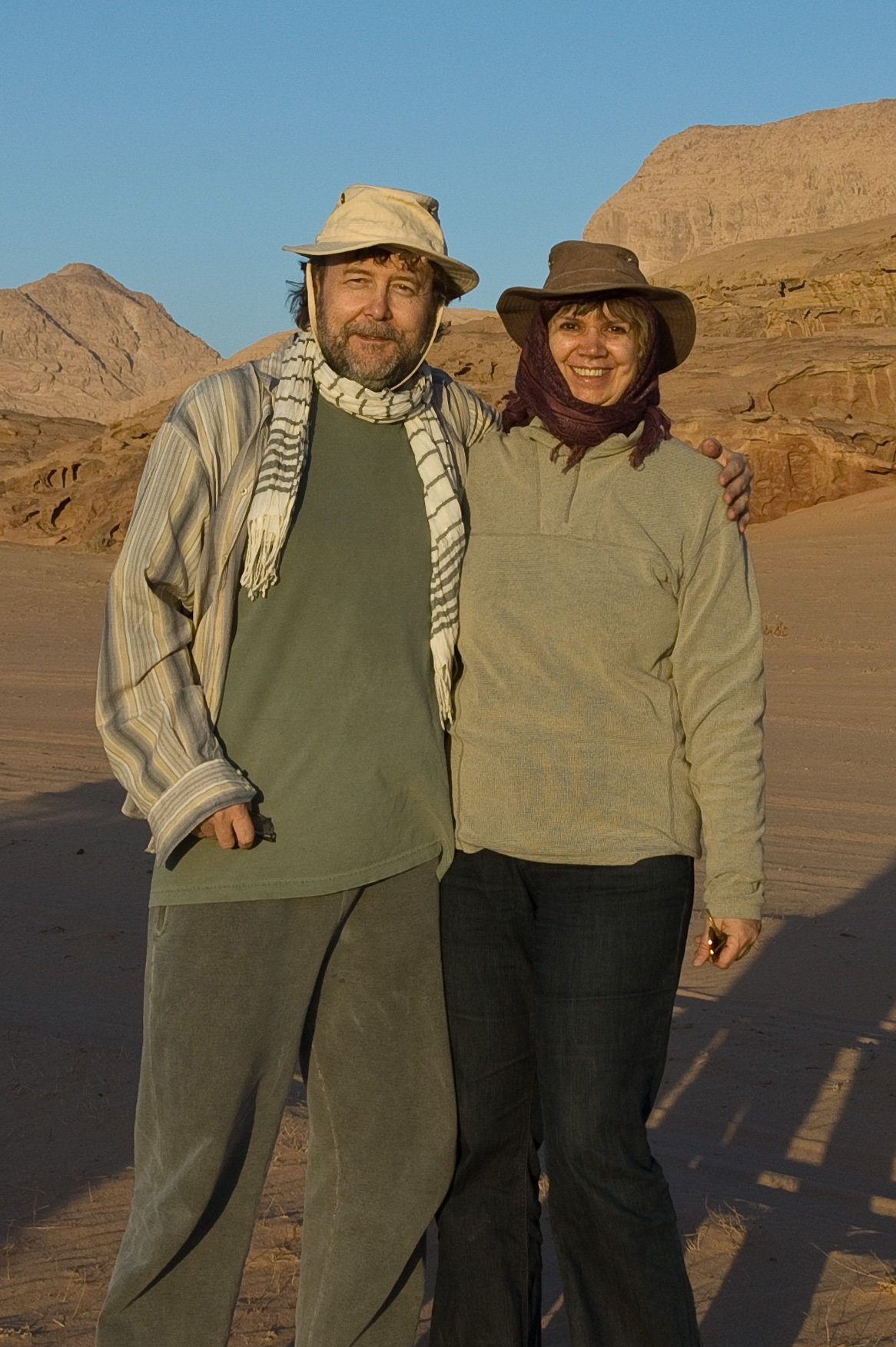
Mr and Mrs Z seen here en route to his audition at a male fashion firm.
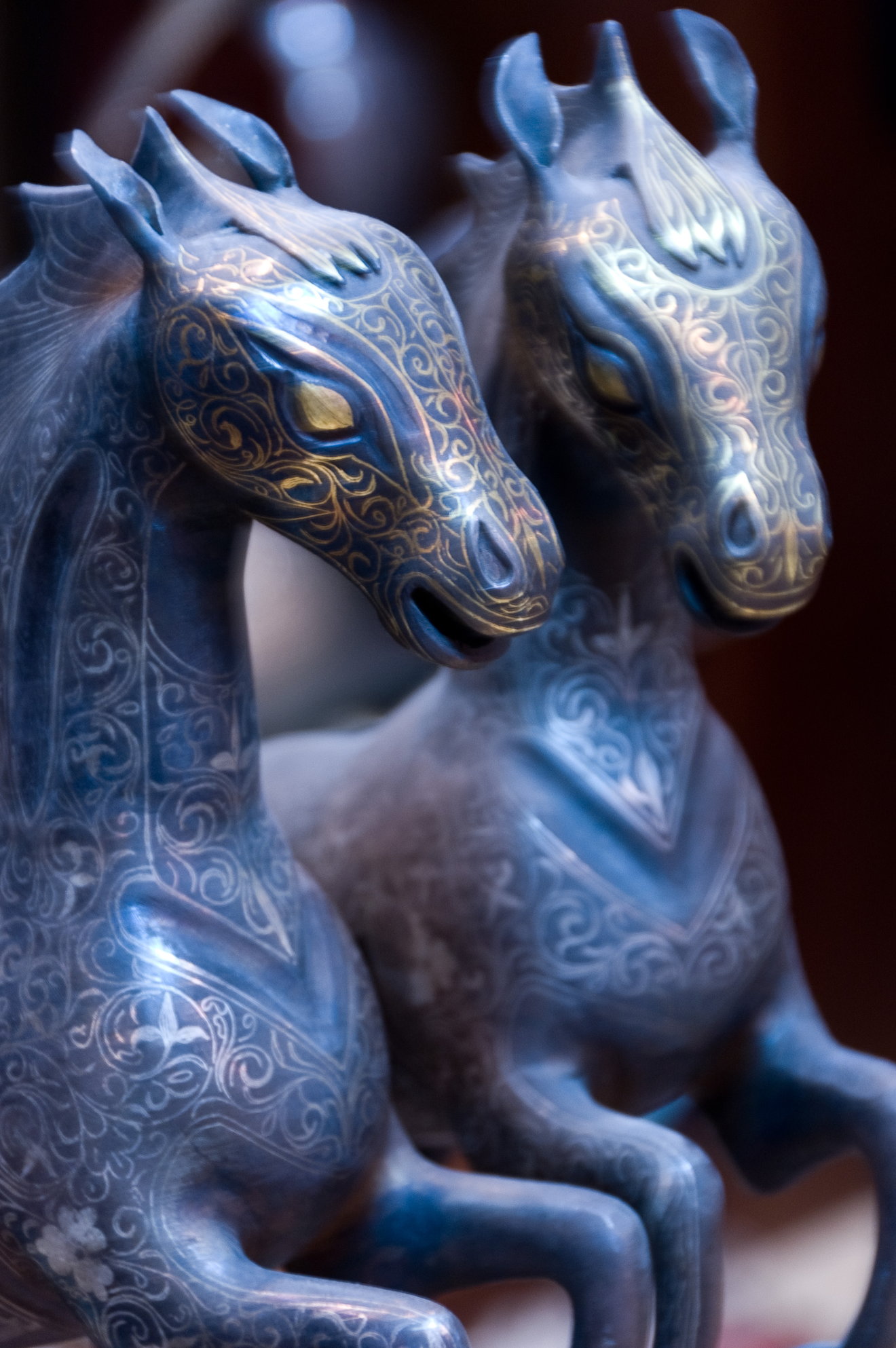
Two other horses in Jordan.

Red lantern in Madaba town.

Jordan also offers the Jerash ruins.
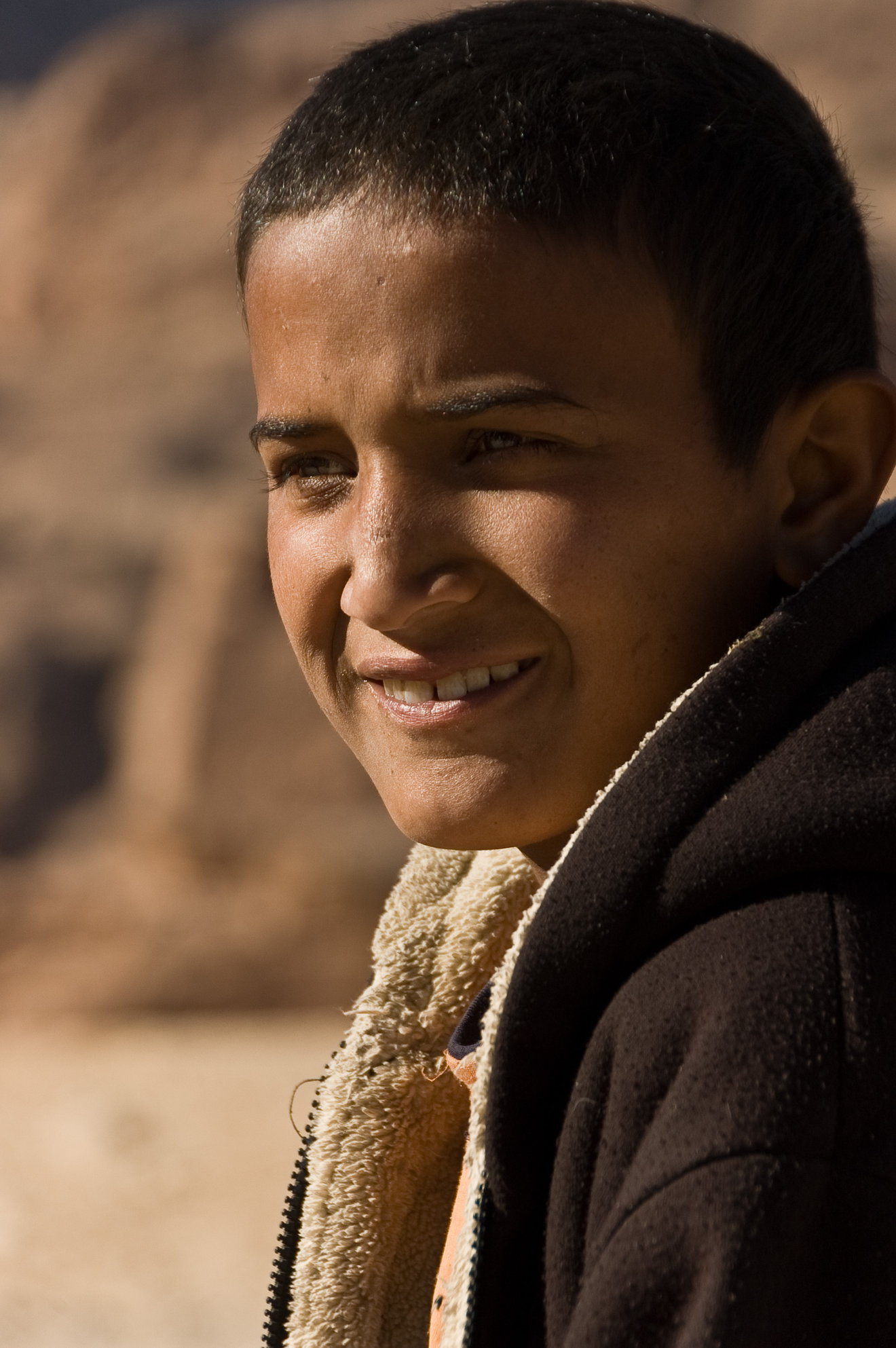
Tawfiq ('good fortune') was a pleasant lad who patrolled the siq.

Do go for a traditional 'hammam' or Turkish-style massage treatment while in Petra. There are a few different places that offer it. Bliss.

Anyone know whatever became of good ol' Ruth Caswell, the travel specialist who once ran a prominent Jordan website?
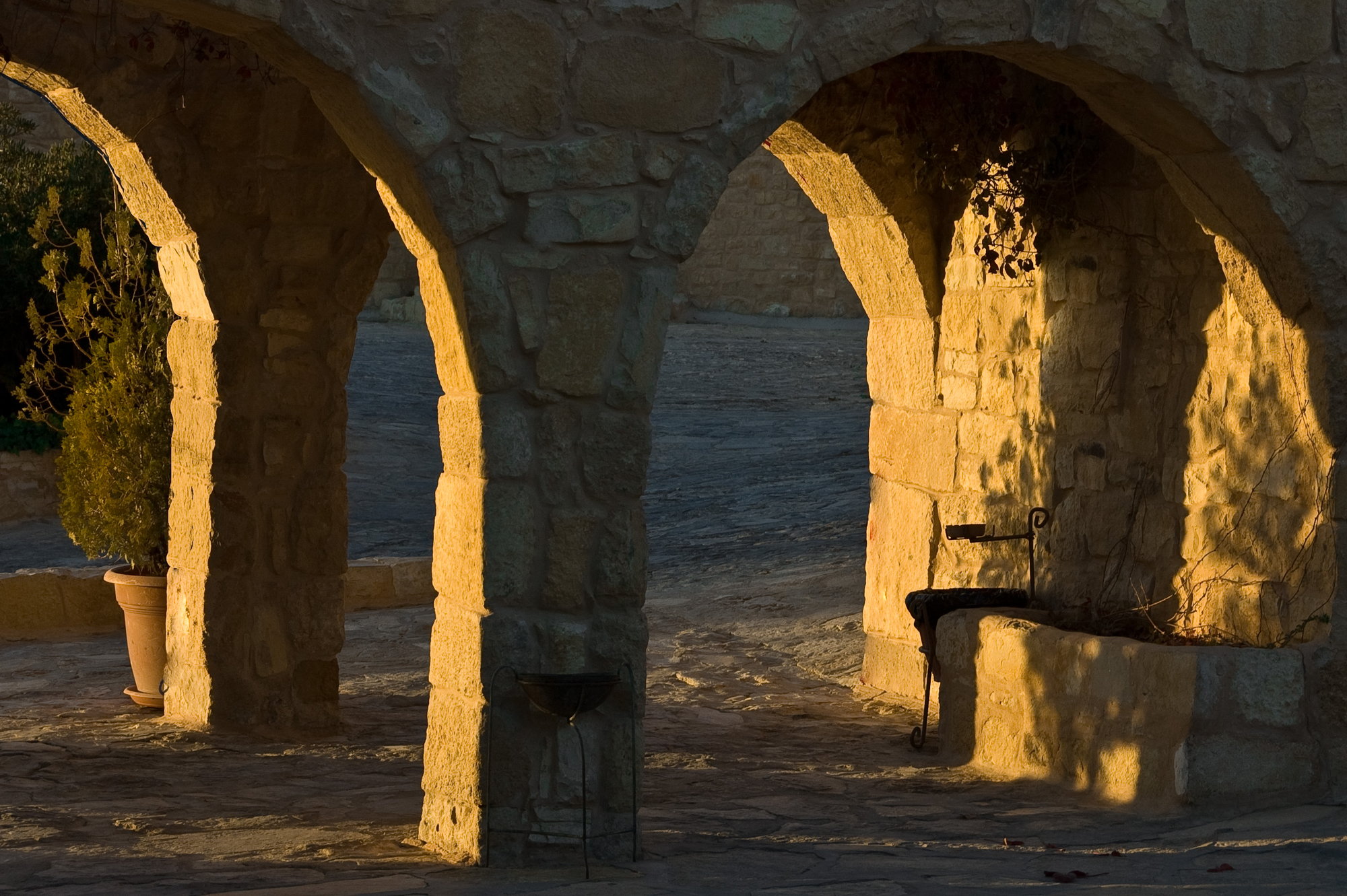
The arches at the front of the restored Ottoman village 'Taybet Zaman'.
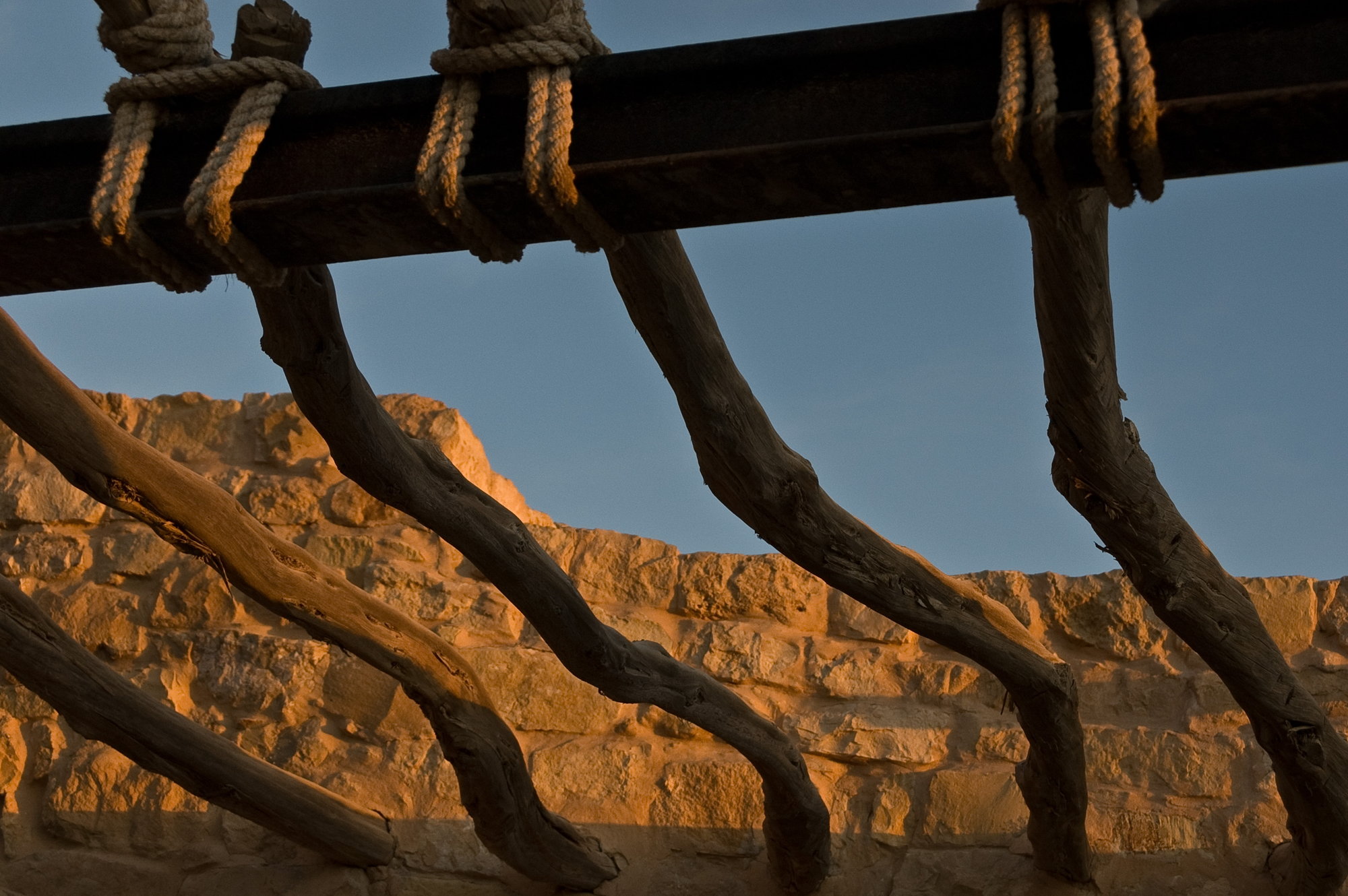
Travelers may stay at that lodging.
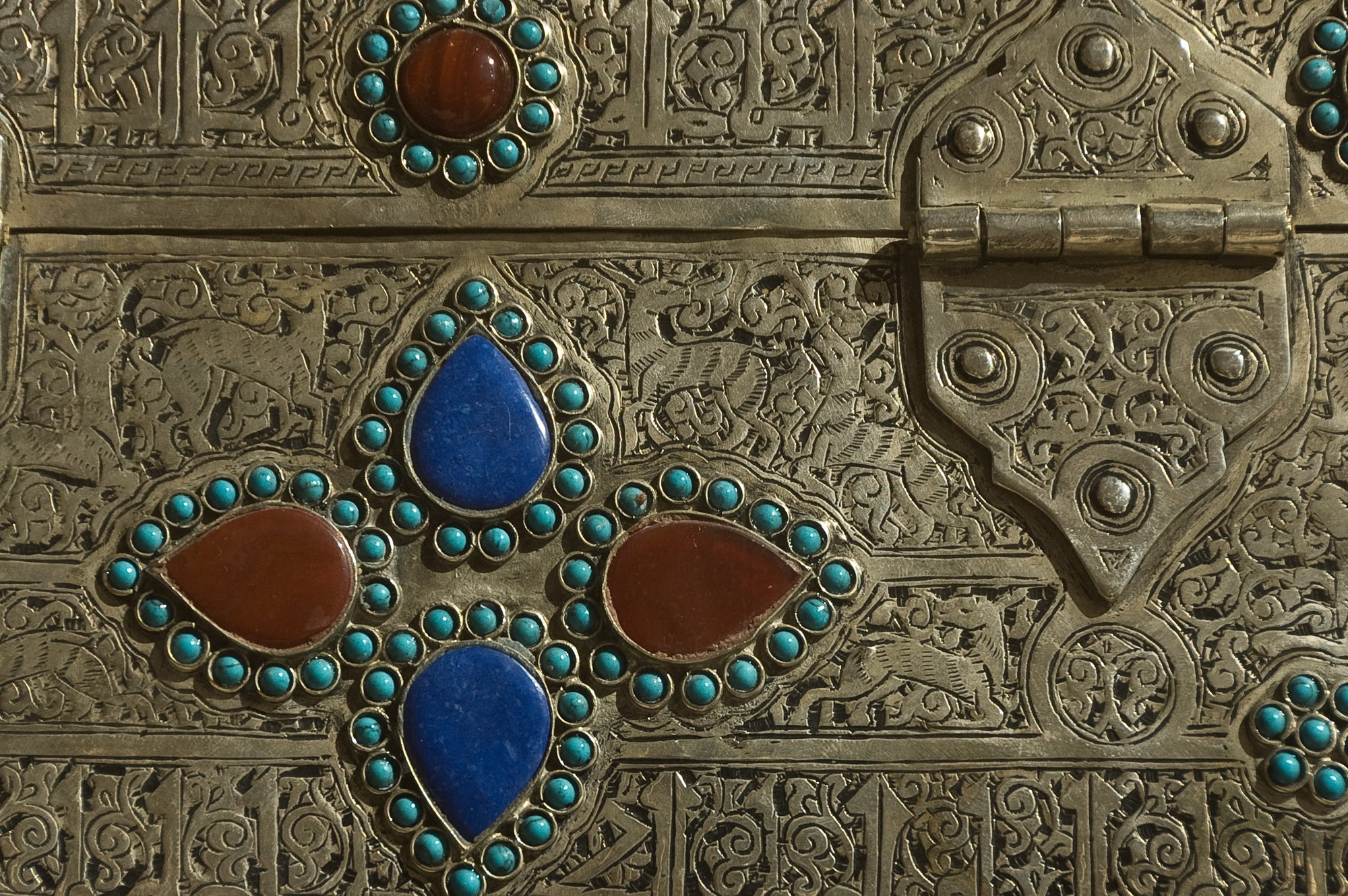
See also the Movenpick hotel, where outstanding service was a norm.

Some souvenirs.
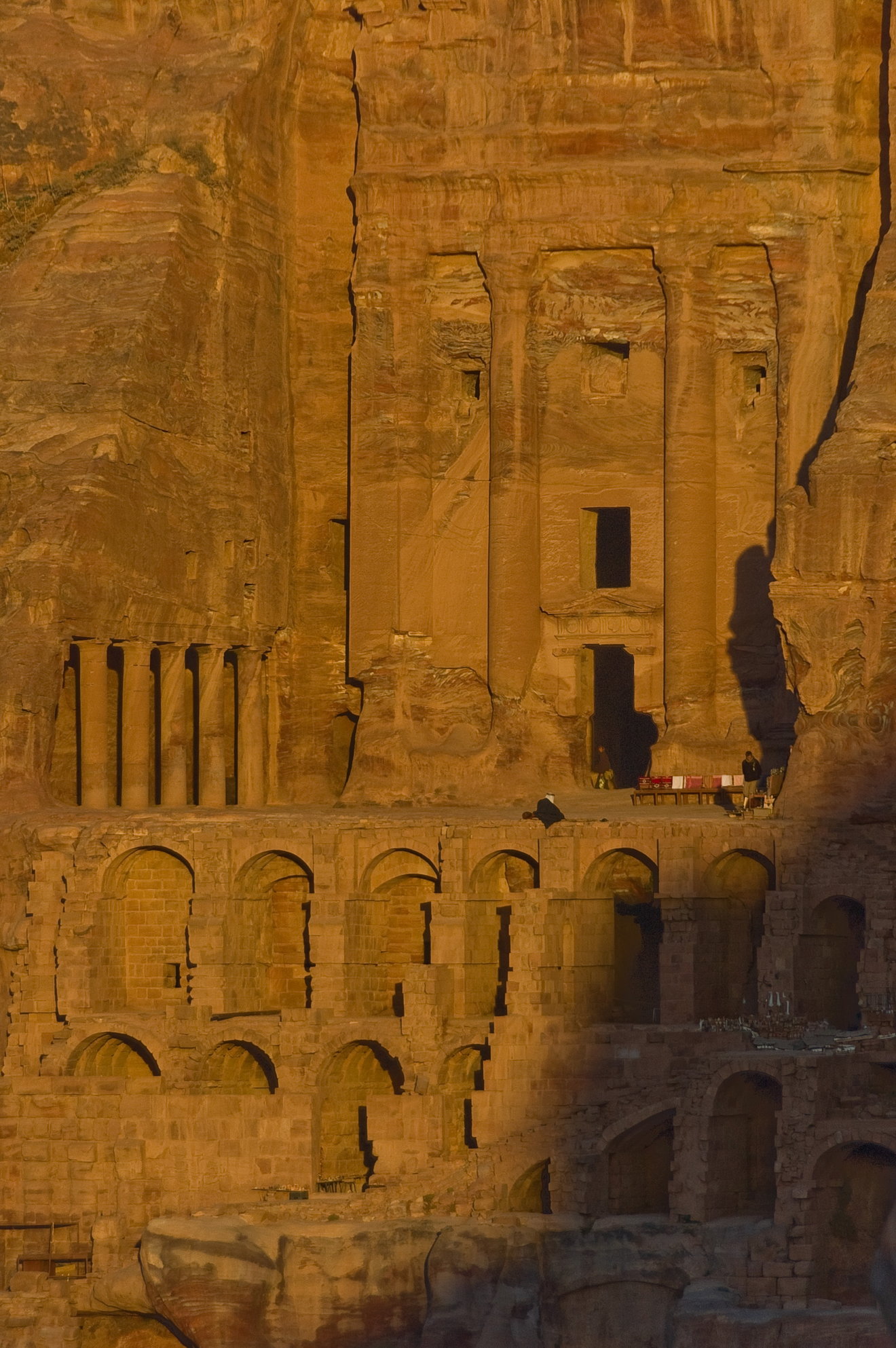
The colonnaded 'Urn' tomb may have originally been some sort of legal court.
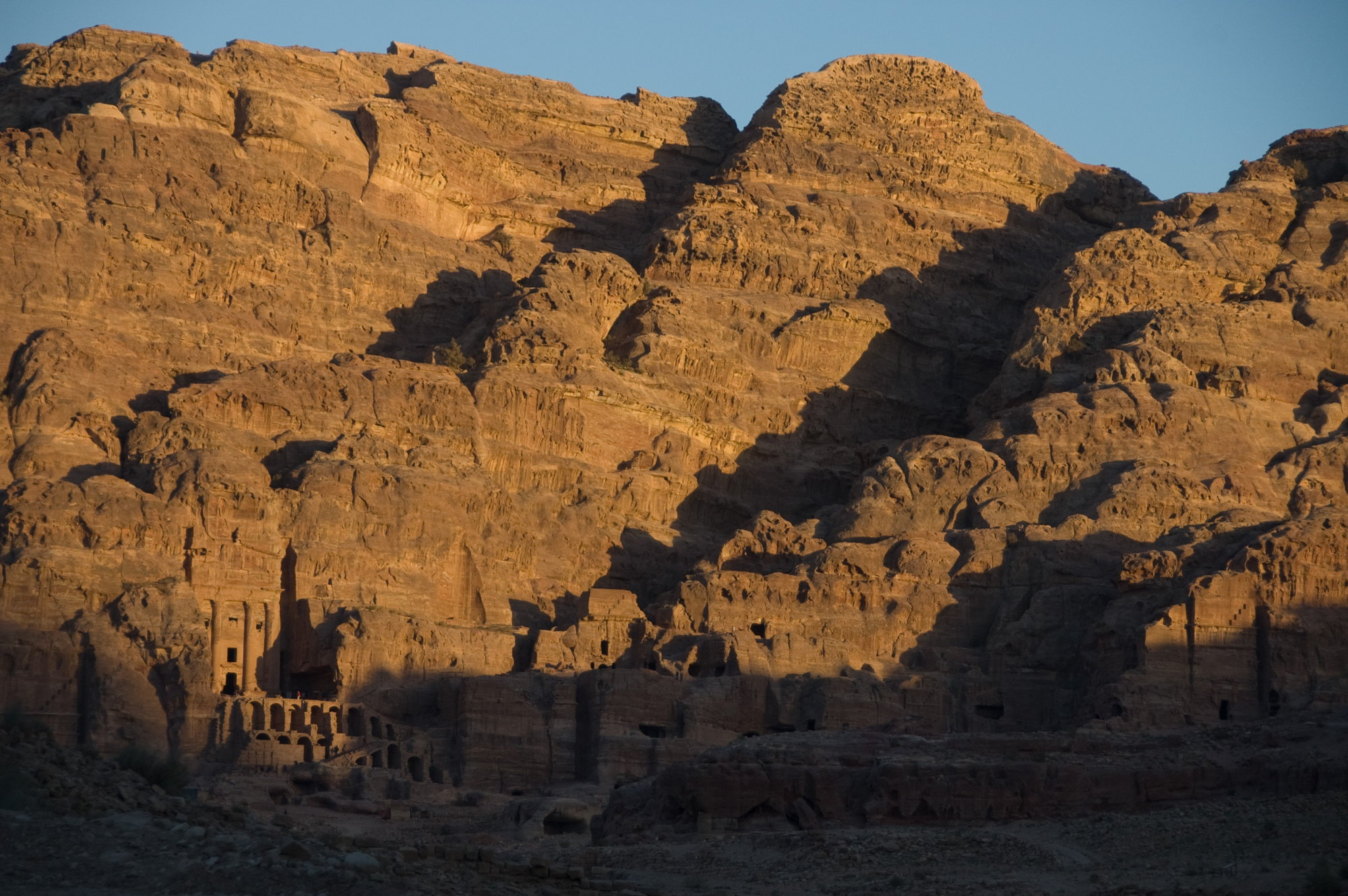
The so-called Royal Tombs look their best during sunrise or the golden hour. Thank you for viewing our TR. Inta-heit. Hallas. (I am done. The end)
#20
Original Poster
Join Date: Jan 2008
Posts: 7,514
Likes: 0
Received 0 Likes
on
0 Posts
An invitation: lets now open up this Jordan TR to everyone. Please do not hesitate to post your own Jordan imagery and/or Trip Reportage here. Poster 'Nelson' and I once tried that kind of joint presentation over on our Vancouver Island TR. I'd like to encourage that kind of sharing once more here. Its all good.
'When we are young
wandering the face of the earth.
Wondering what our dreams might be worth.
Learning that we're only immortal
for a limited time.'
('Dreamline' by Johnny Shandoo and the Broken Pediments)
'When we are young
wandering the face of the earth.
Wondering what our dreams might be worth.
Learning that we're only immortal
for a limited time.'
('Dreamline' by Johnny Shandoo and the Broken Pediments)



